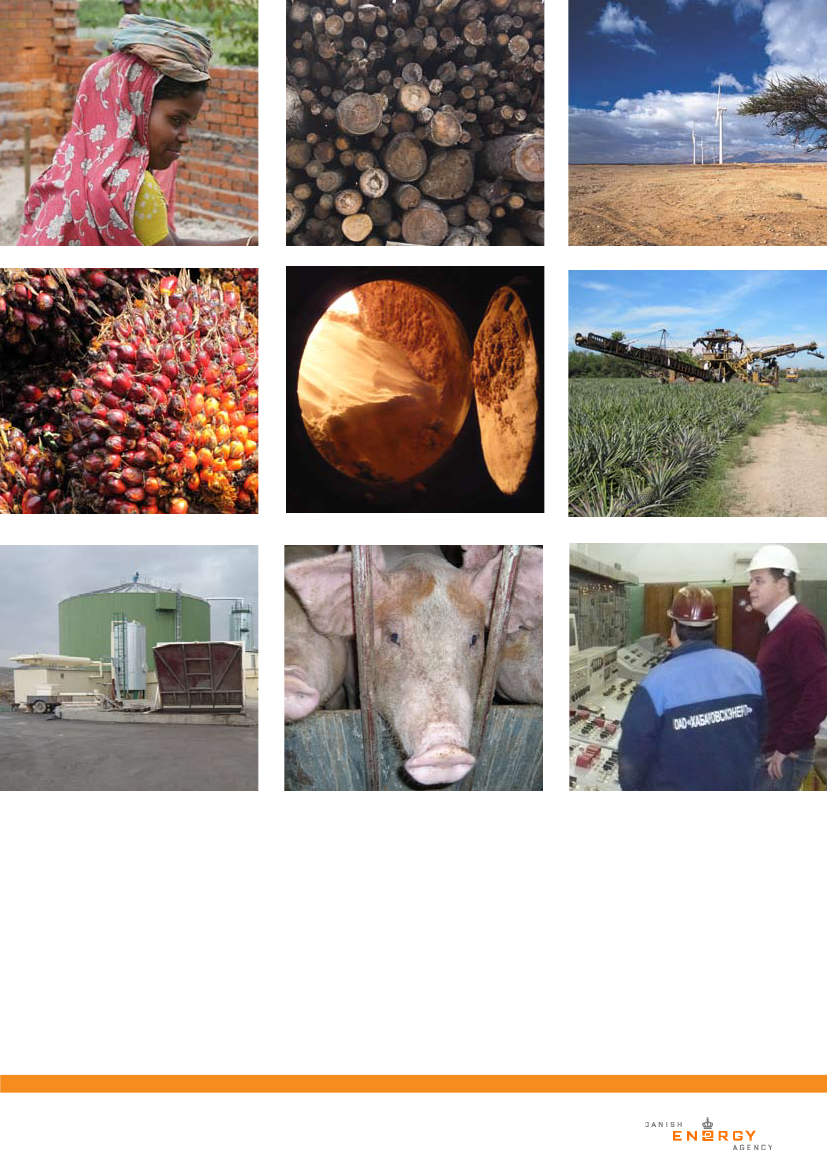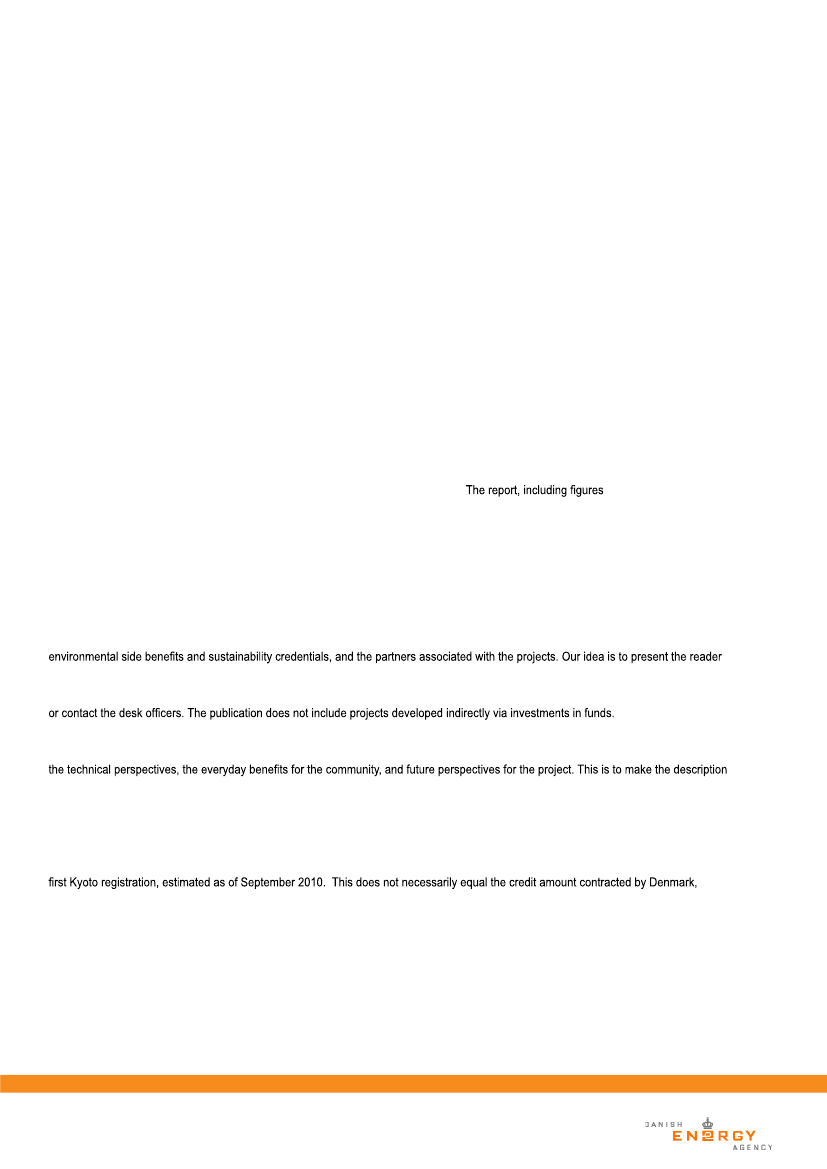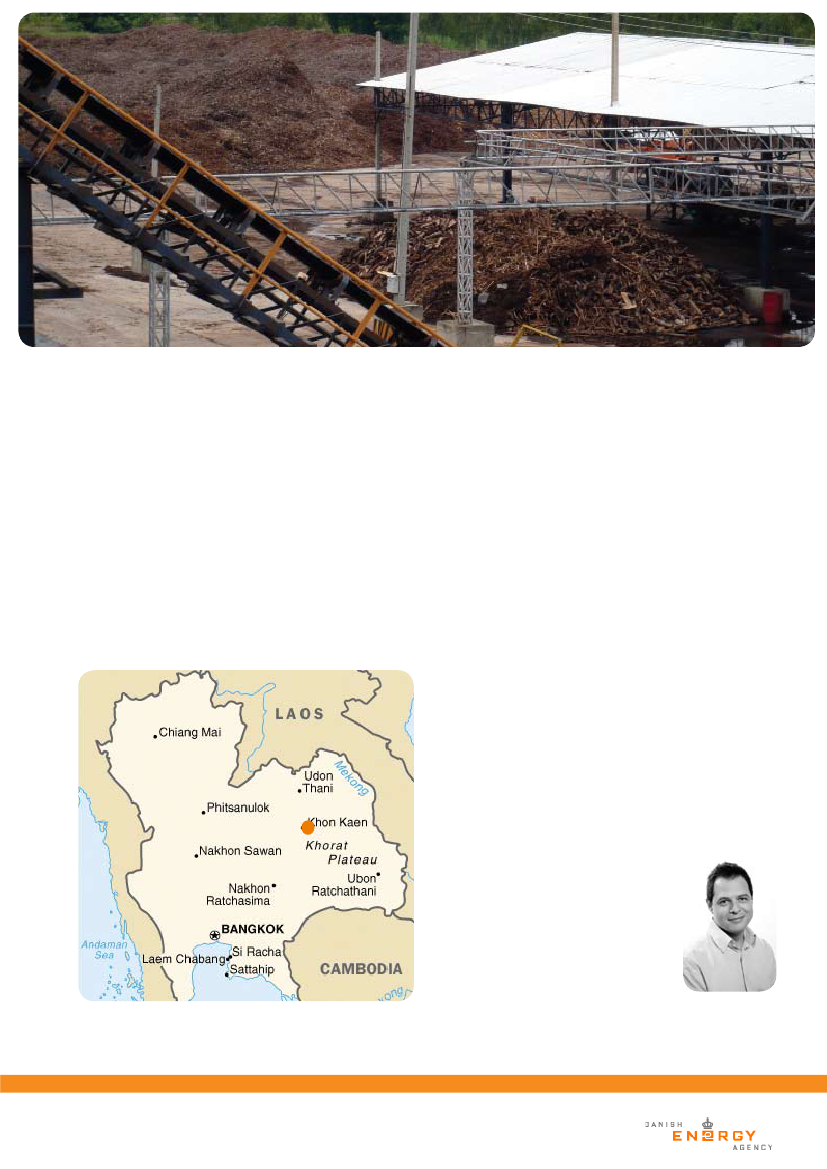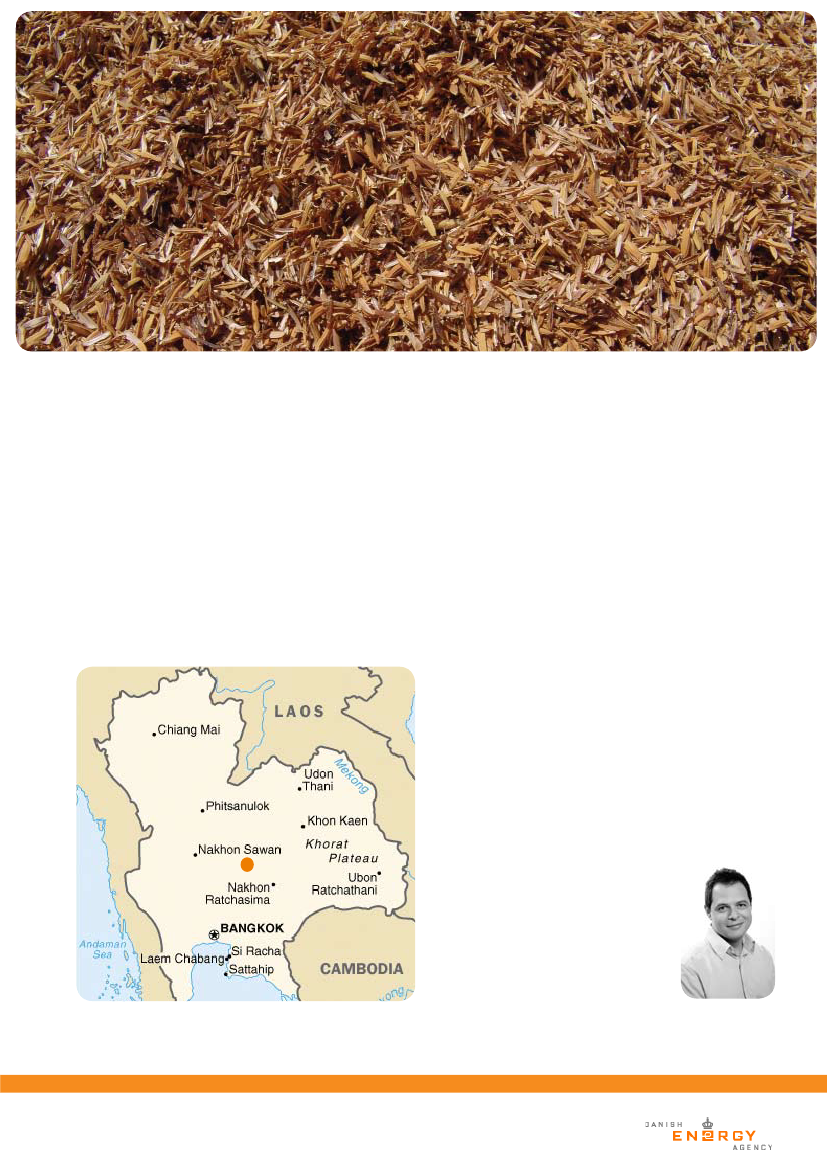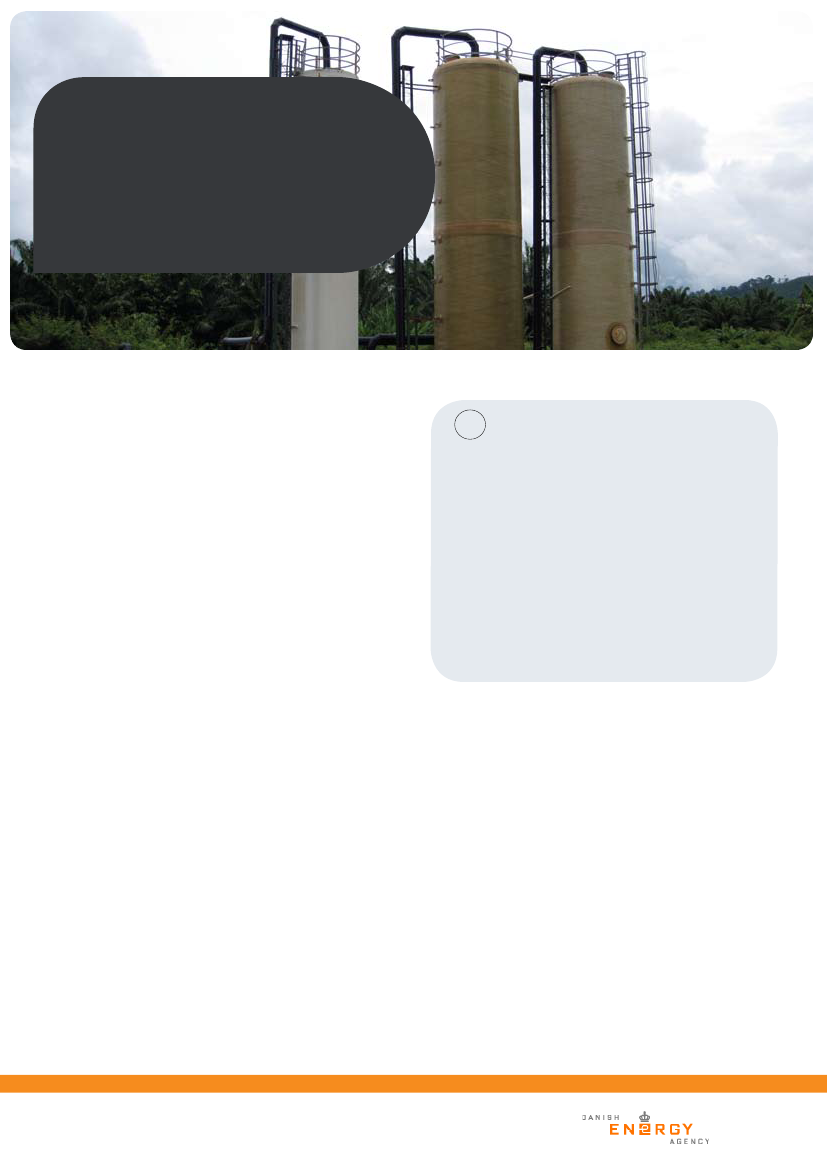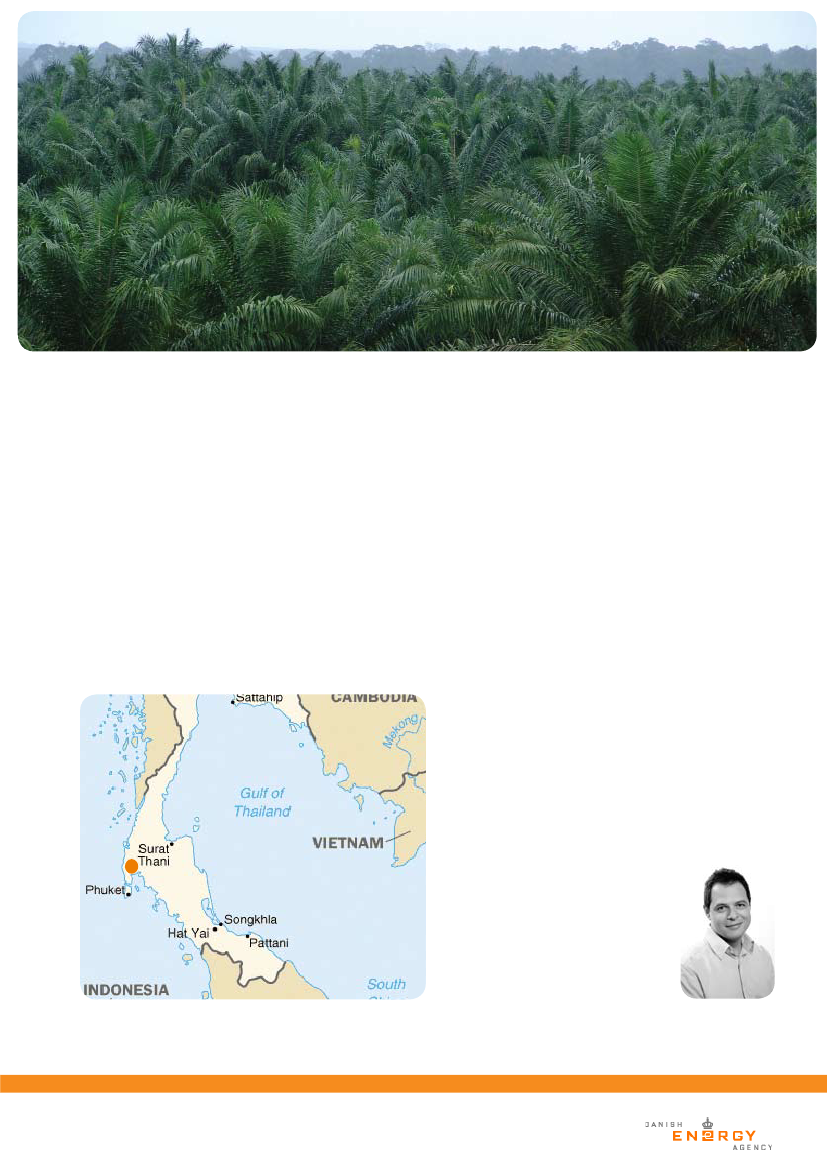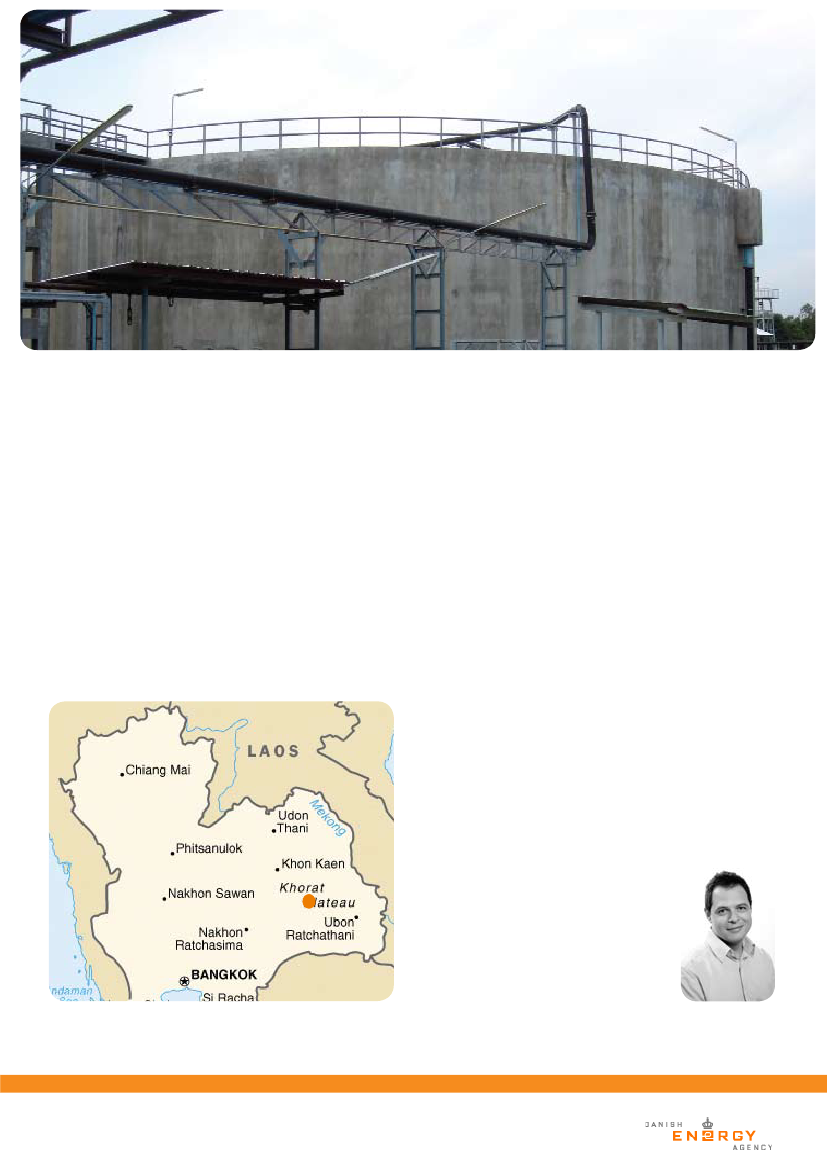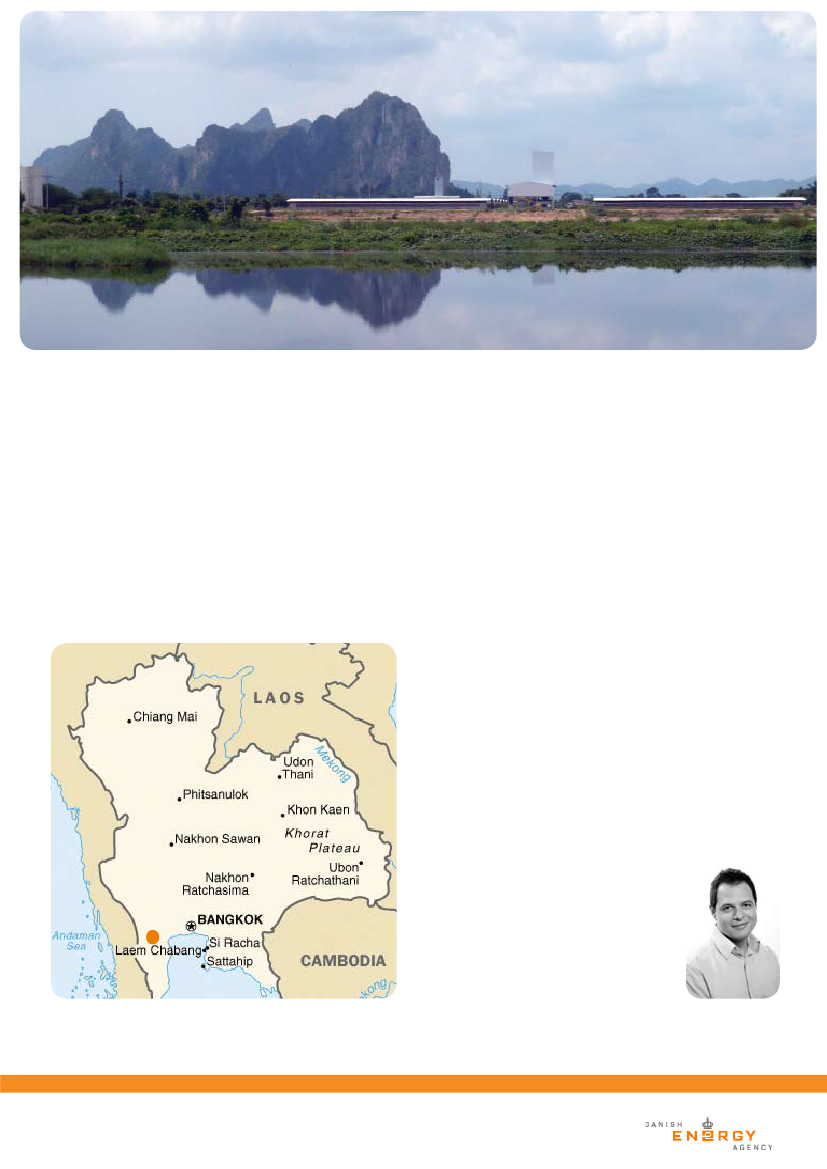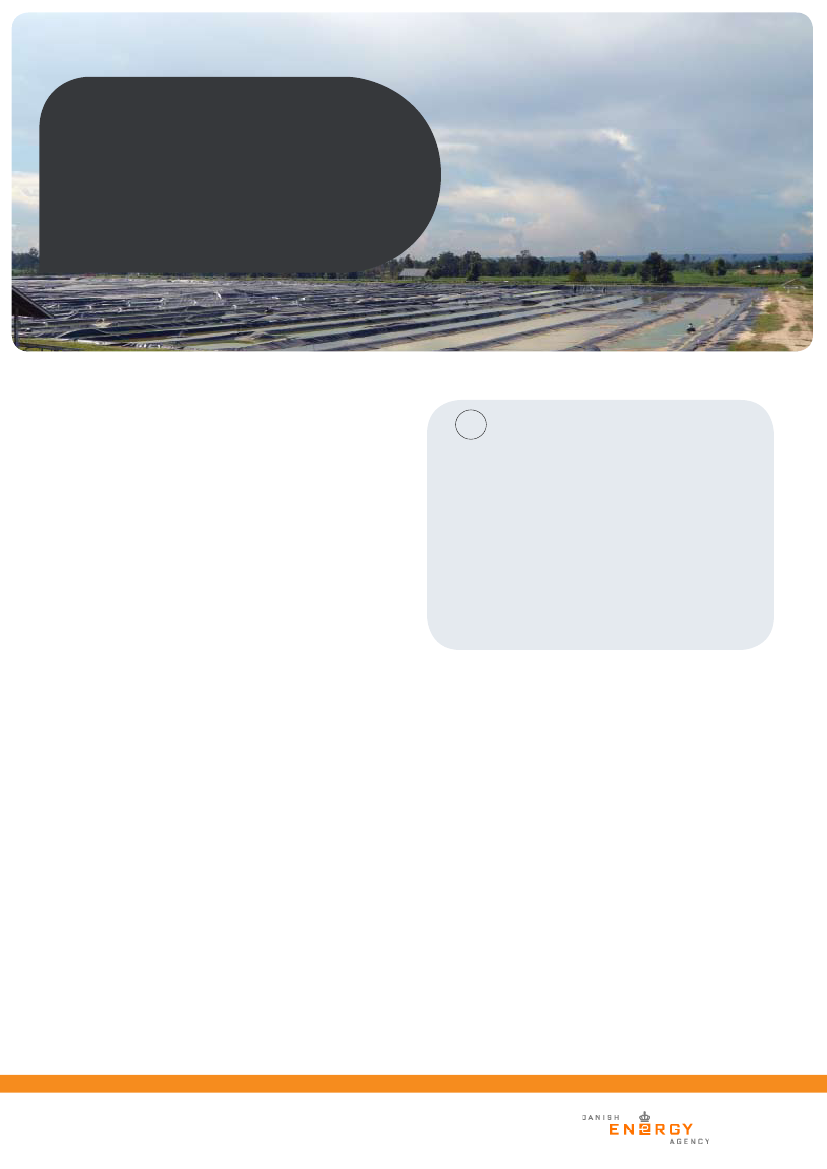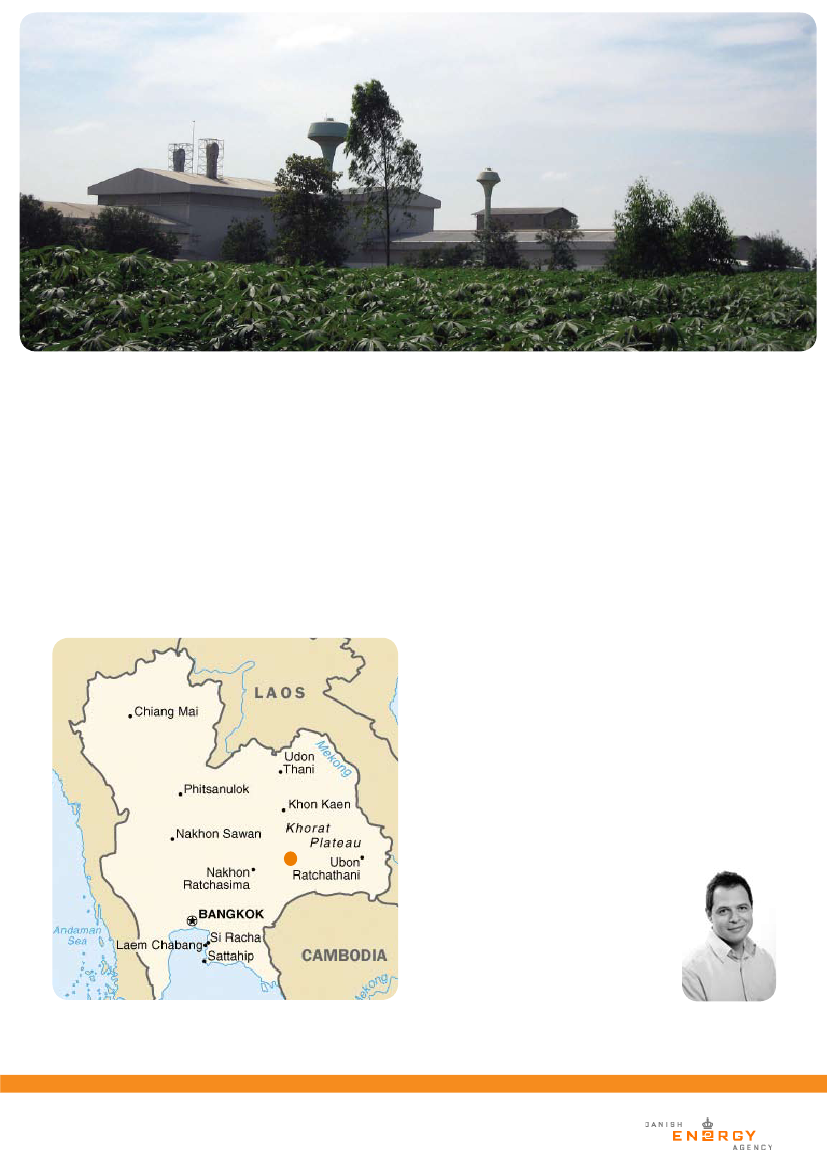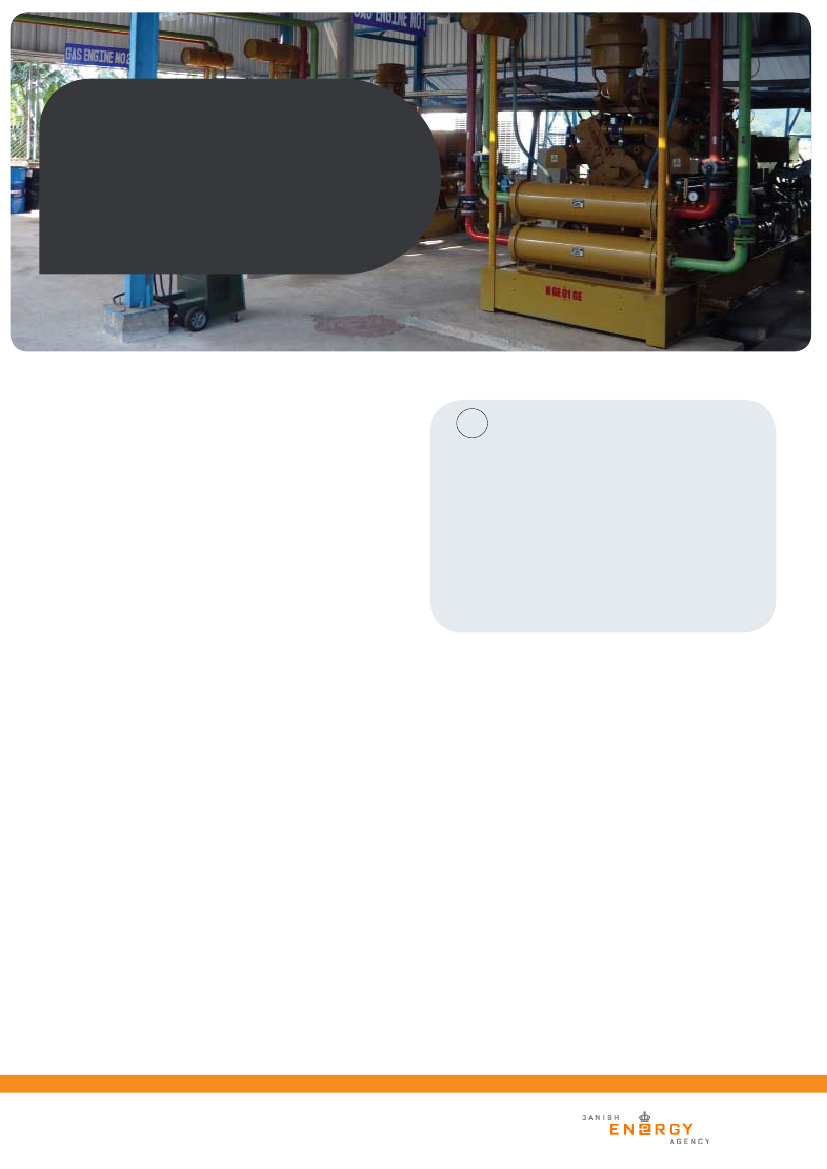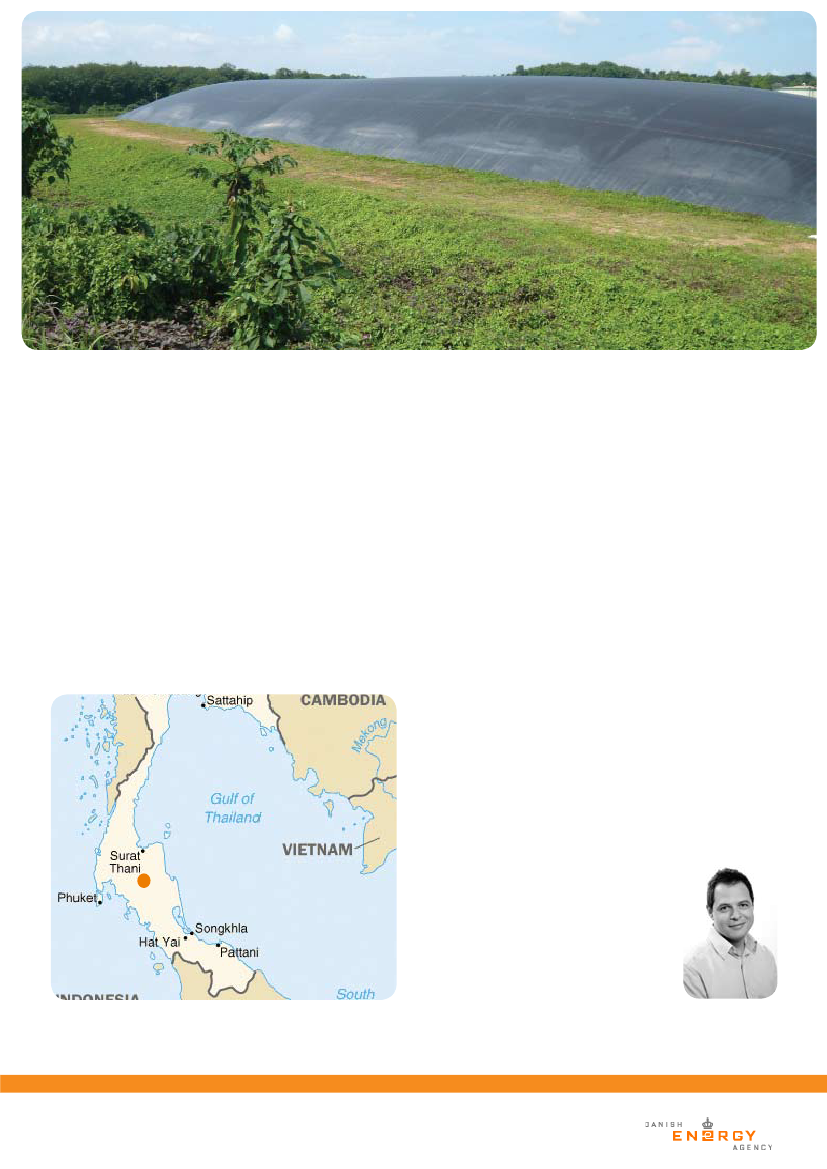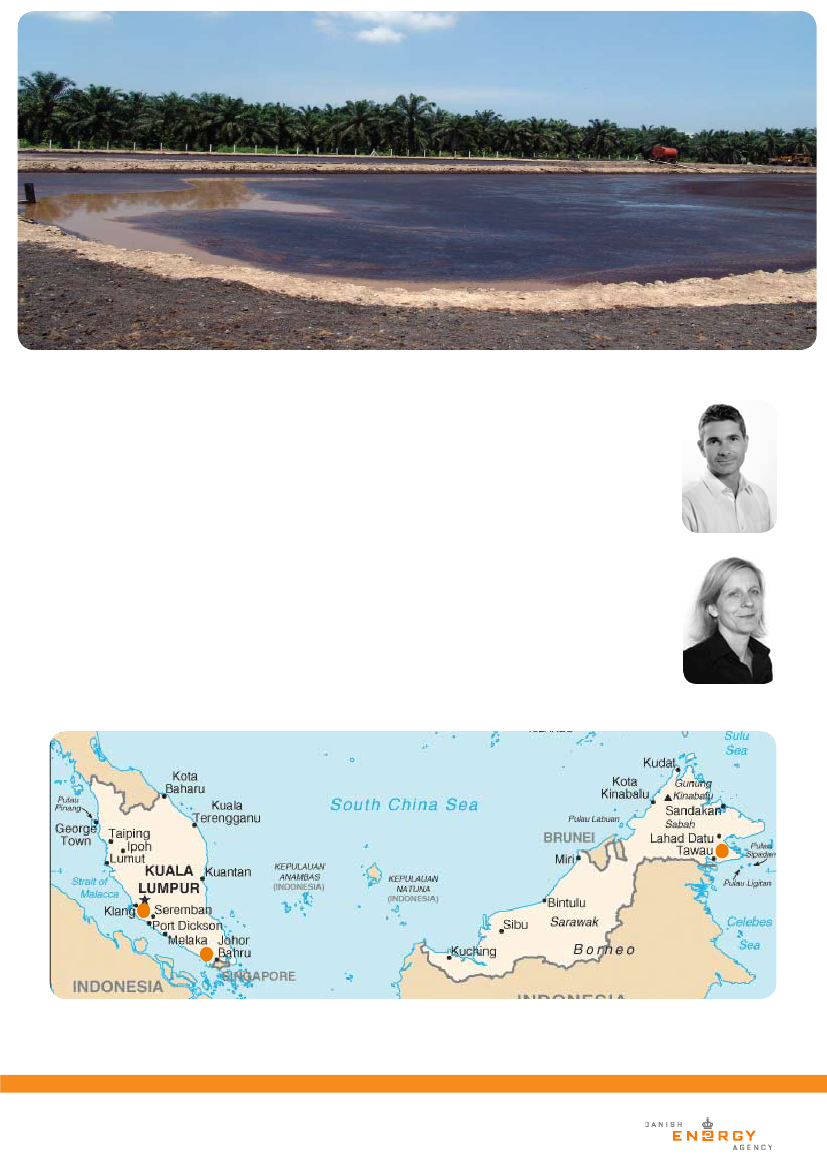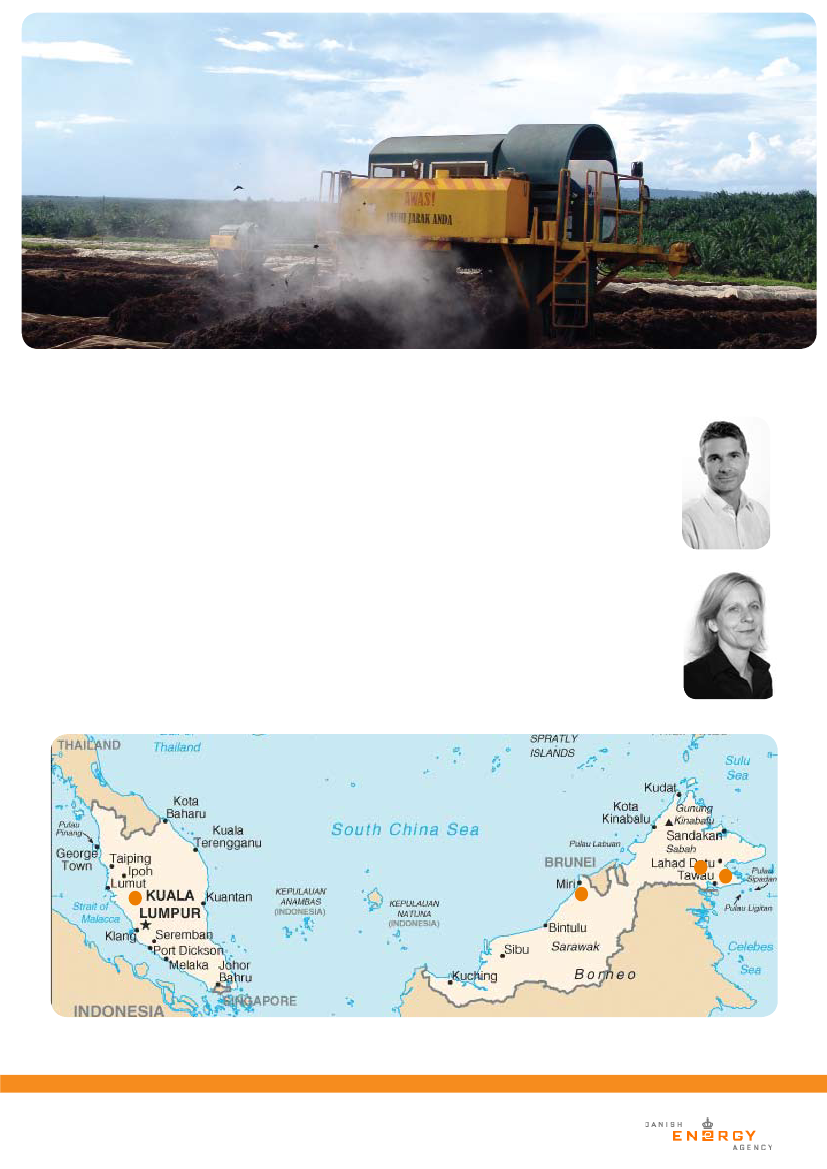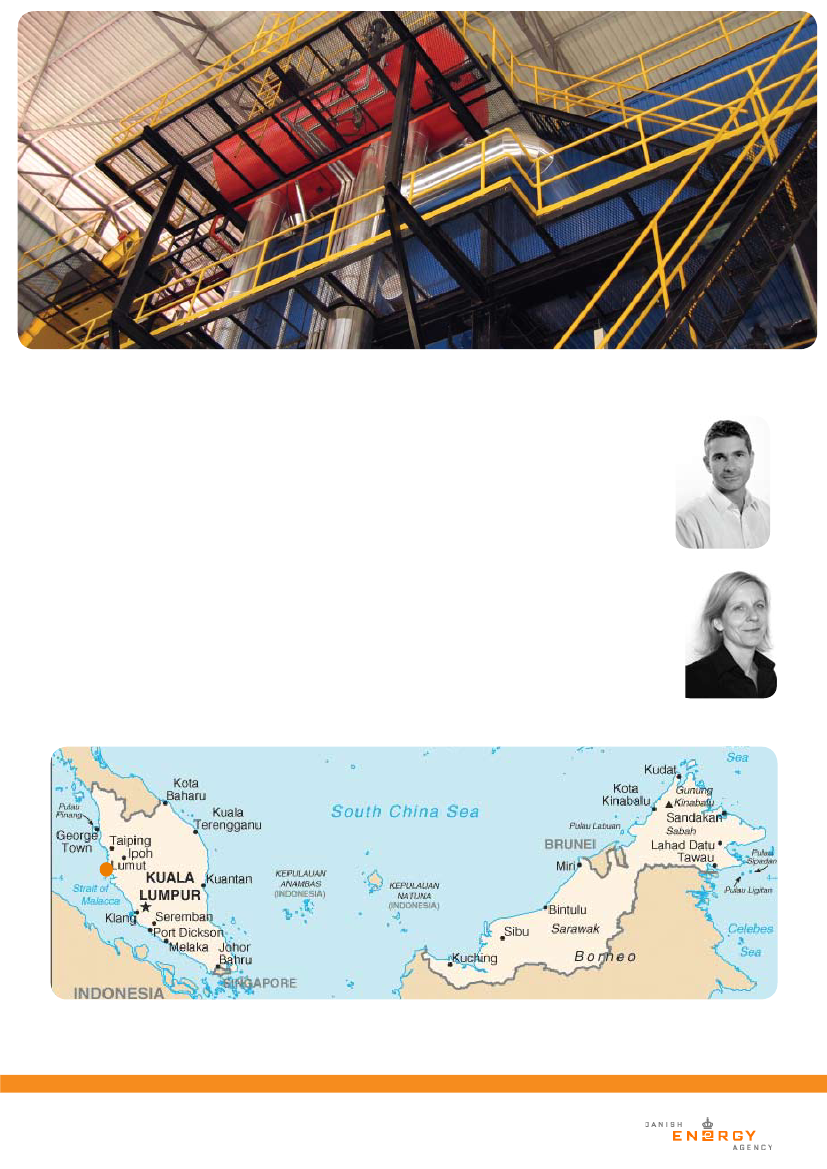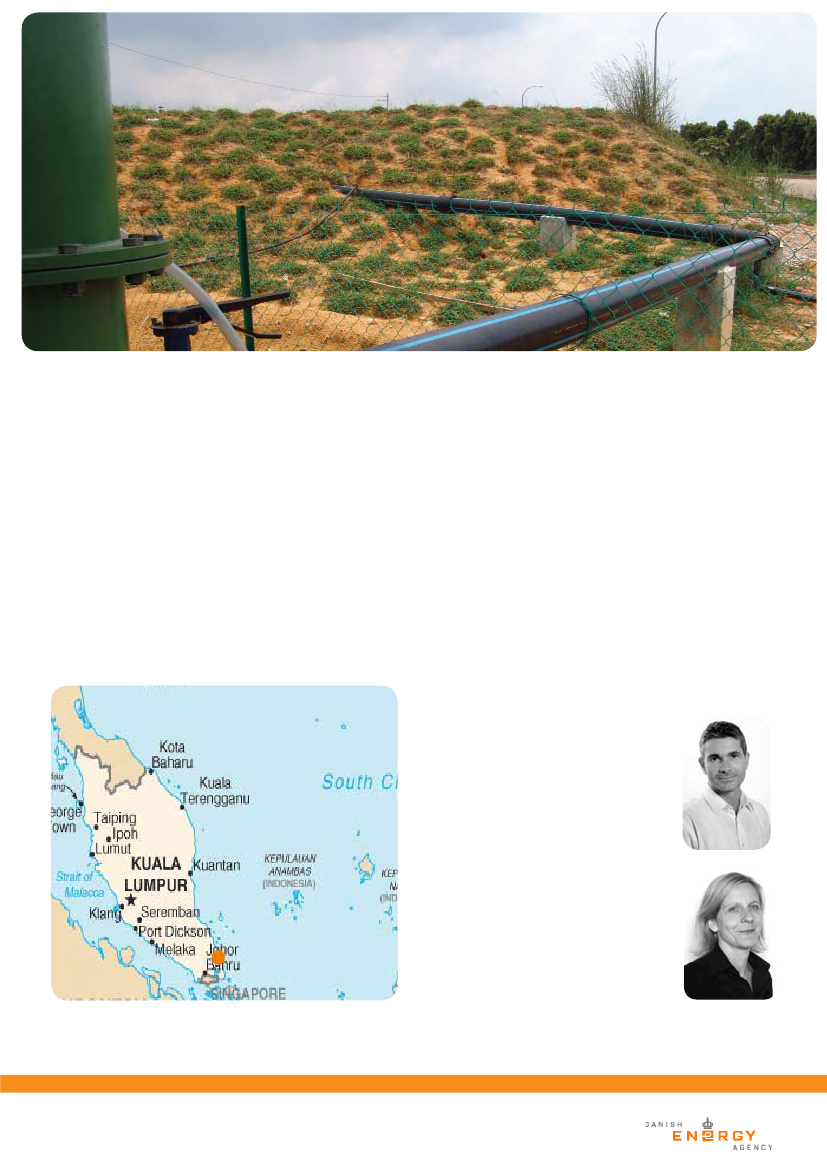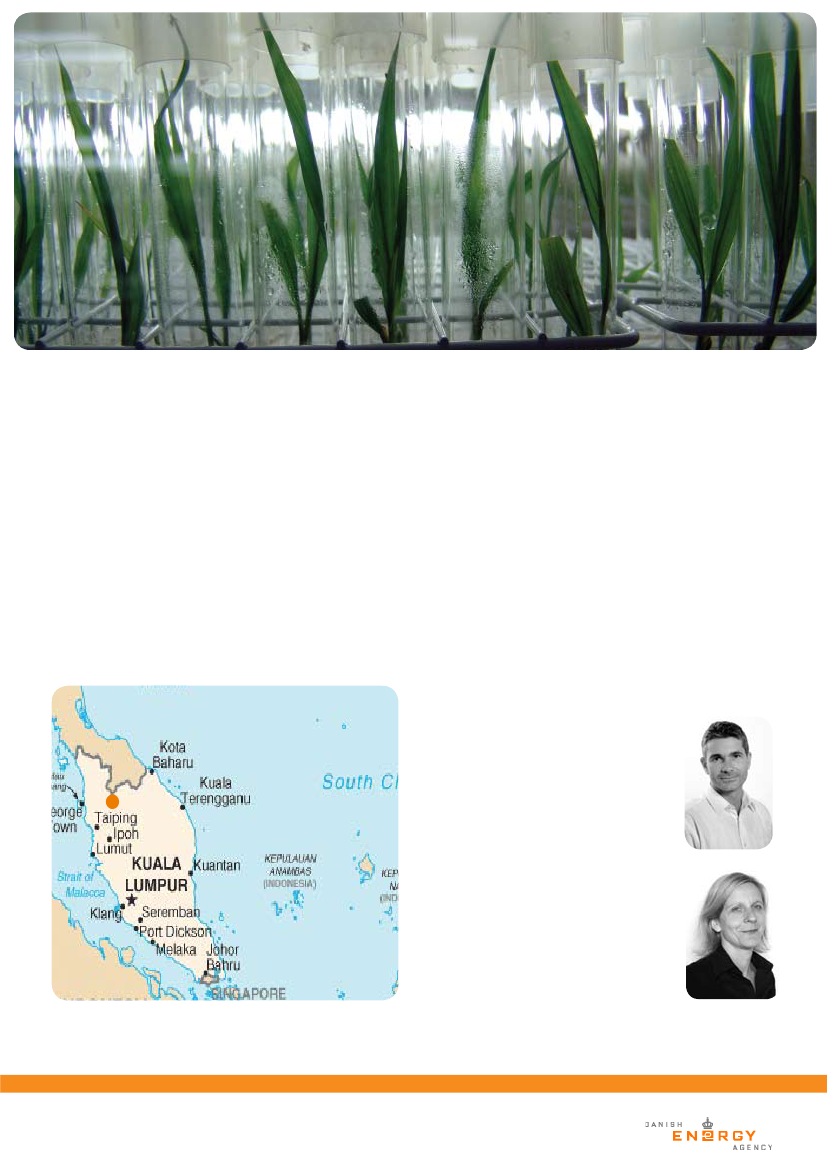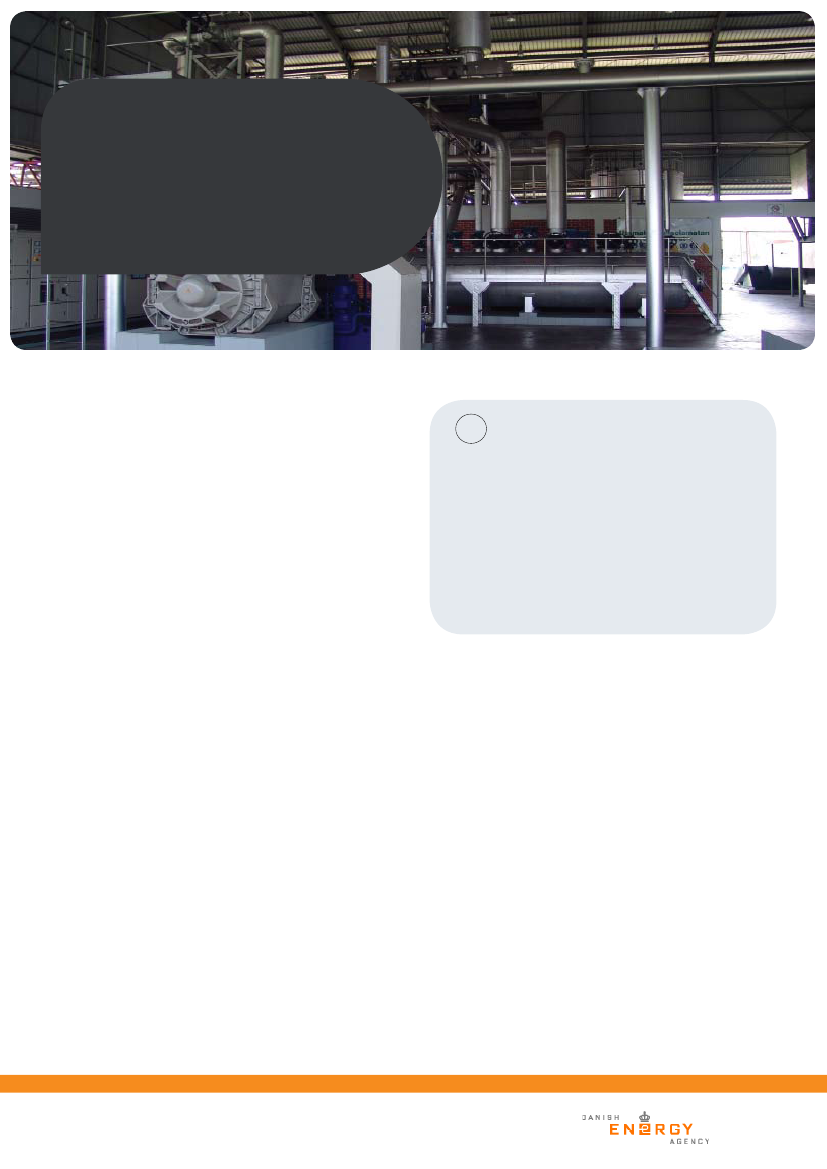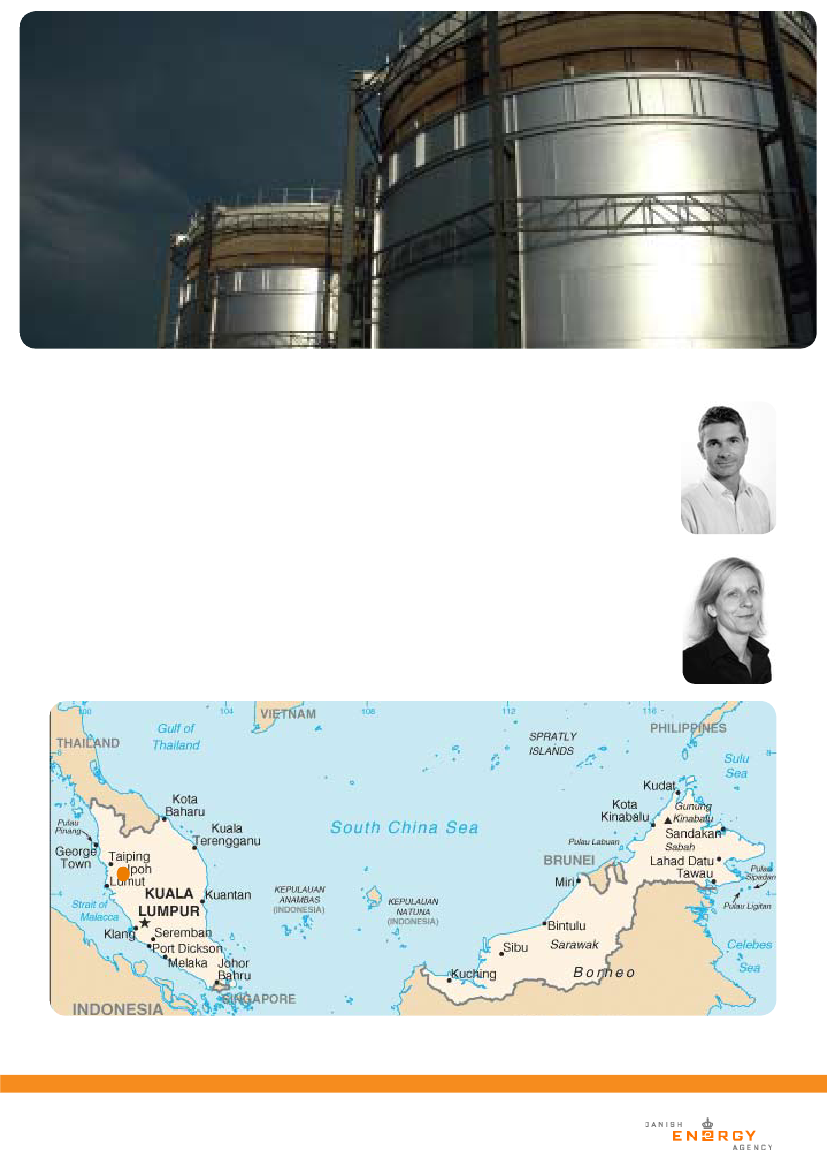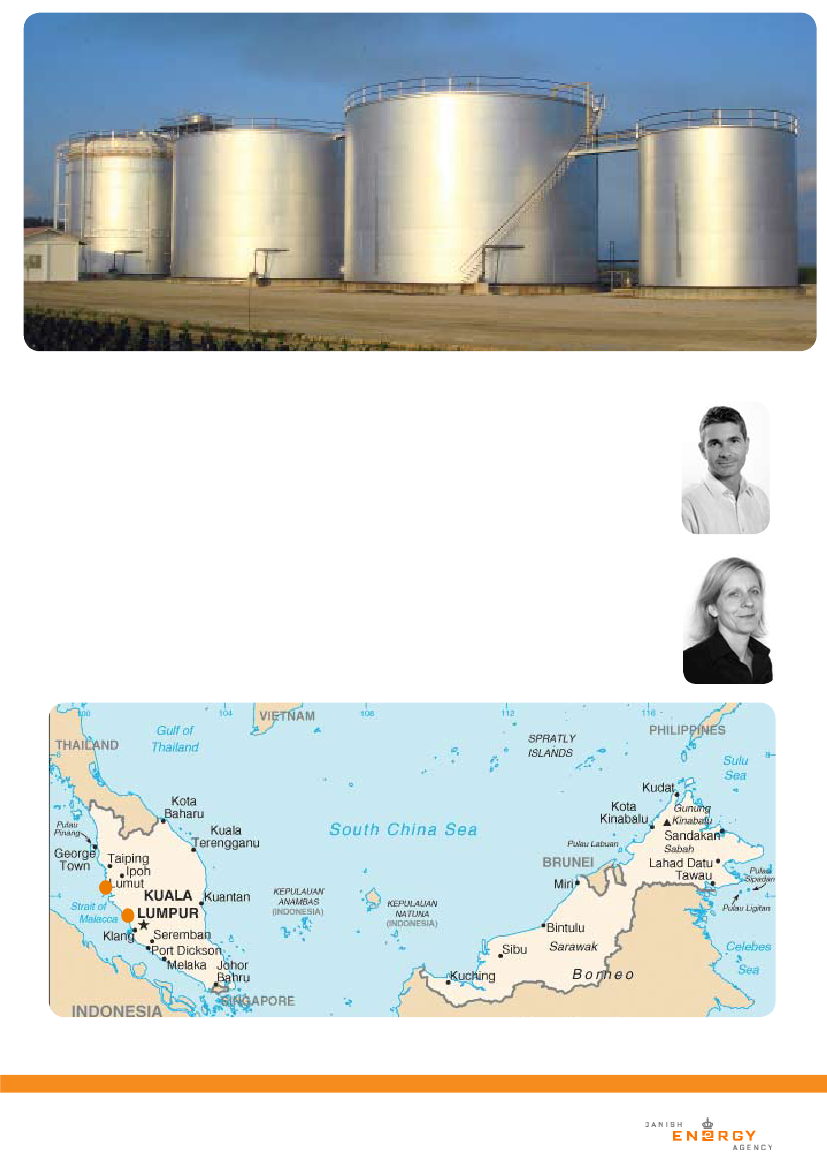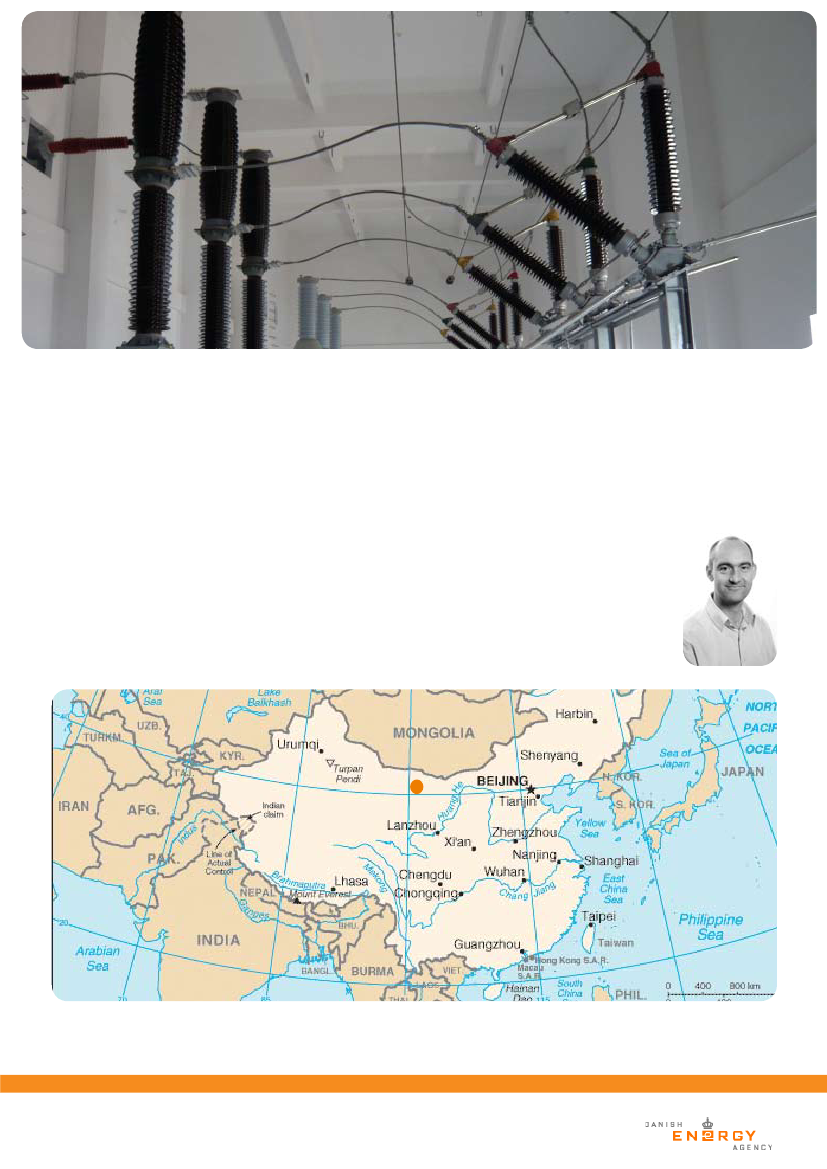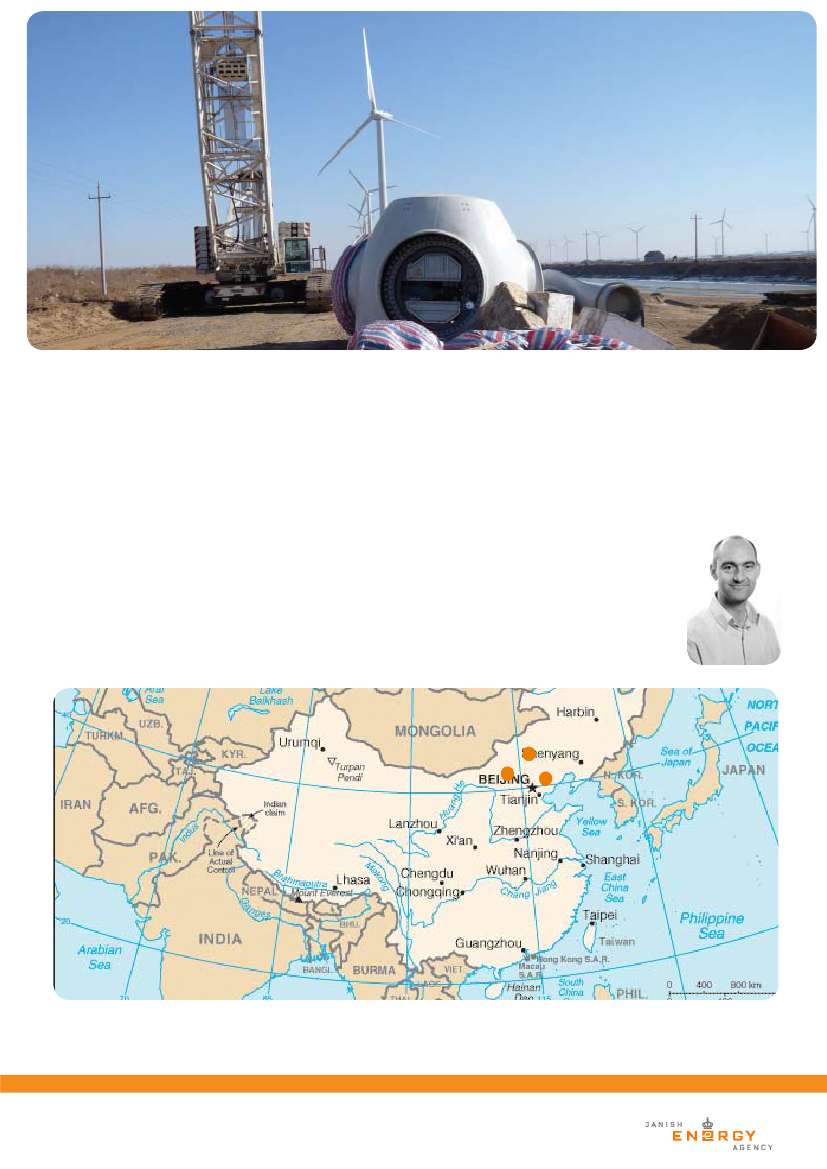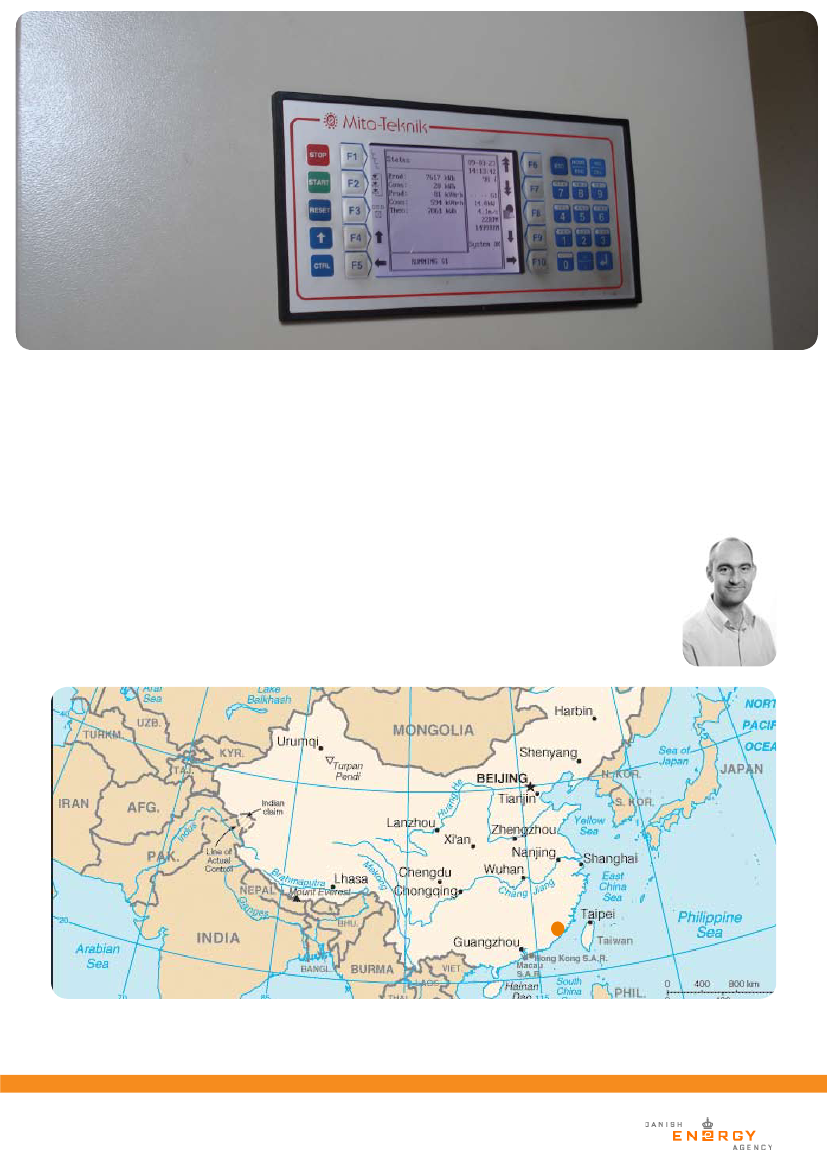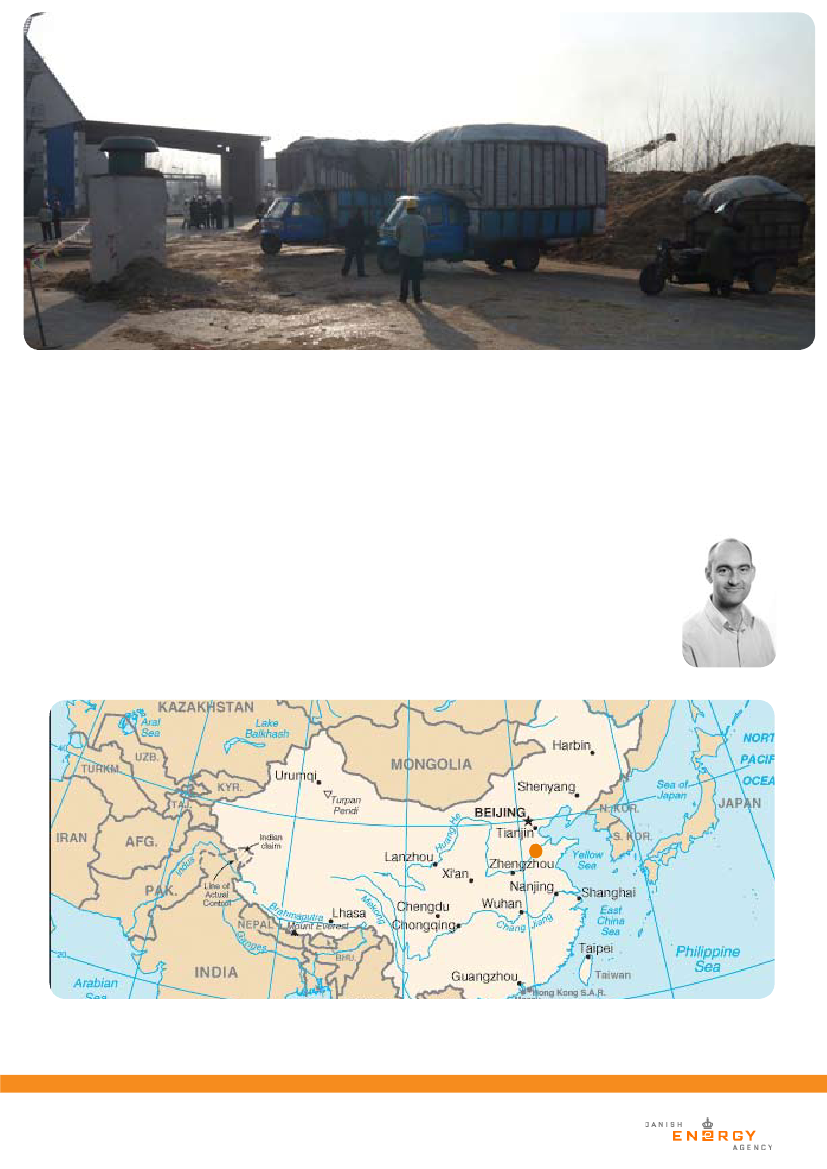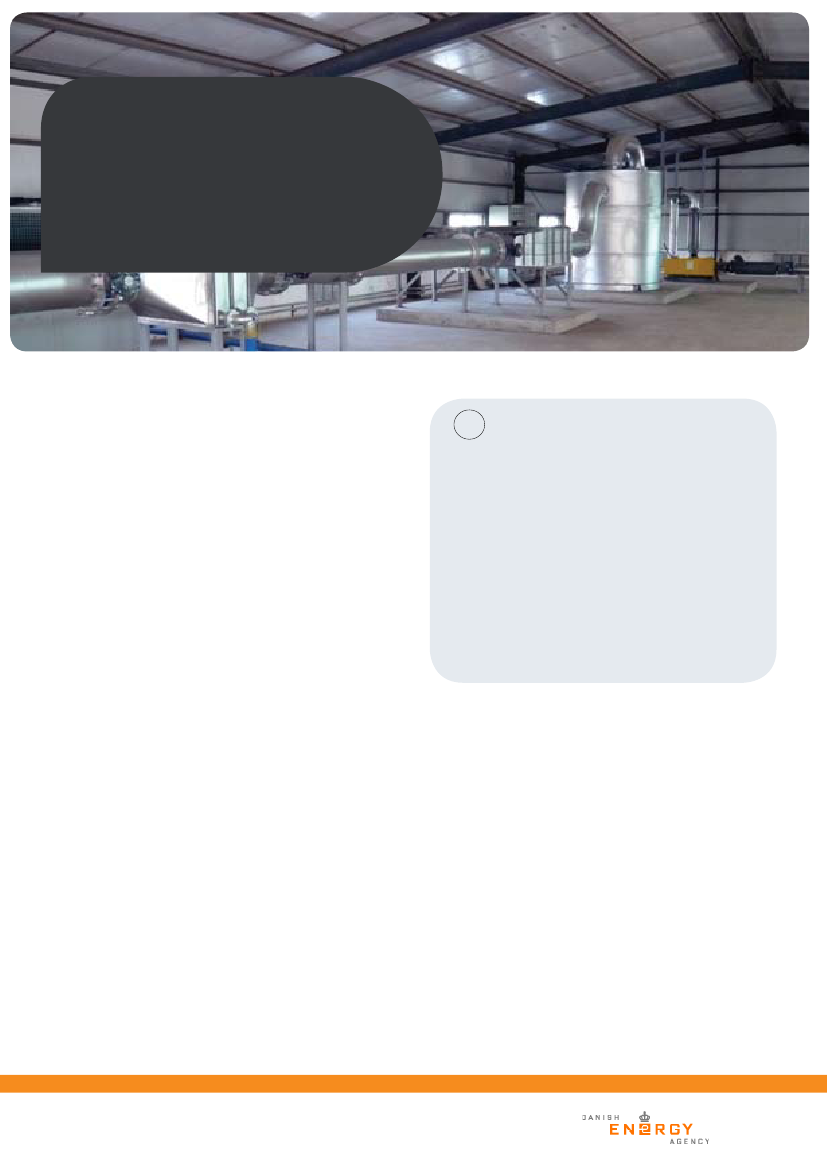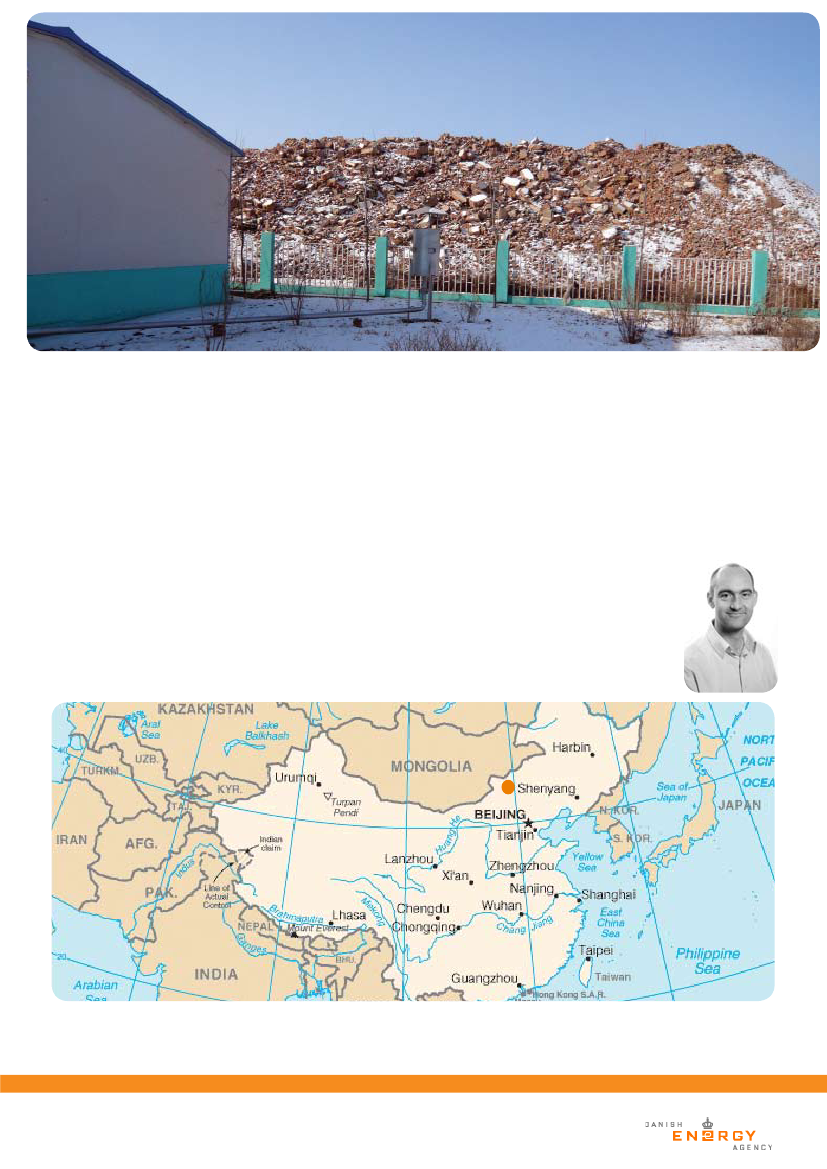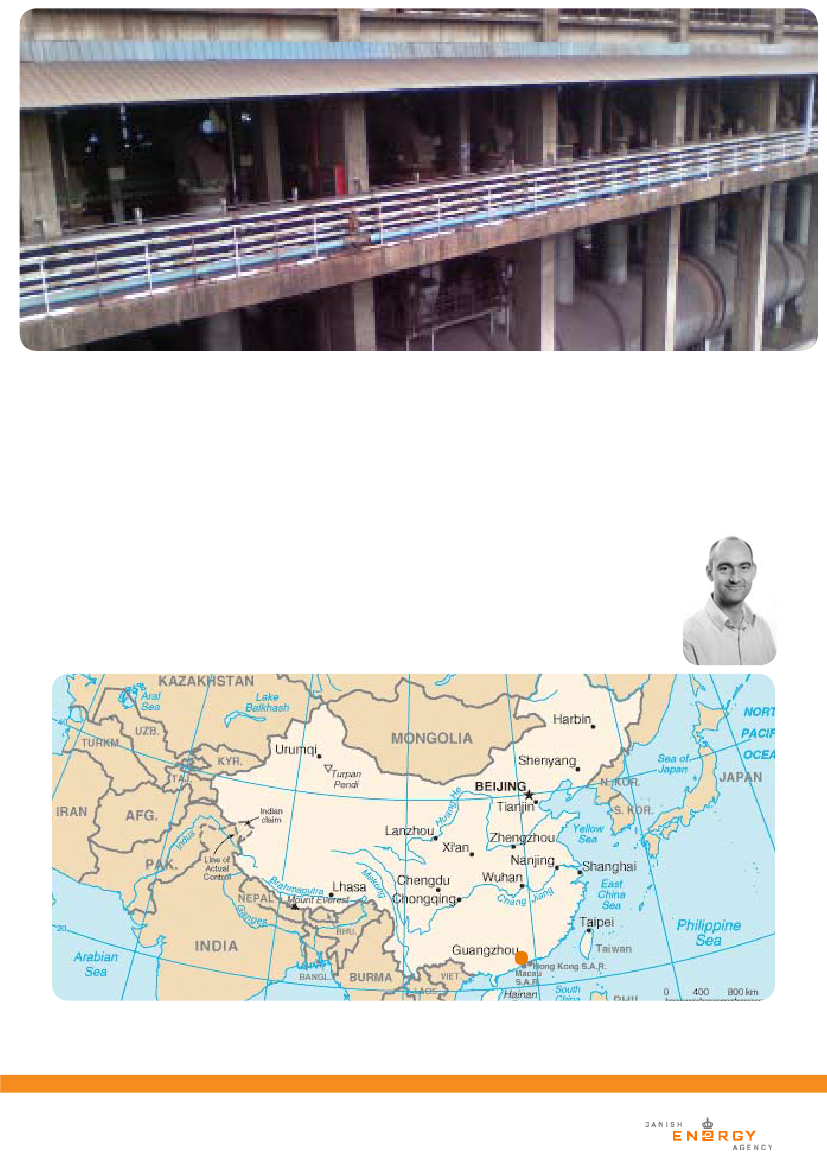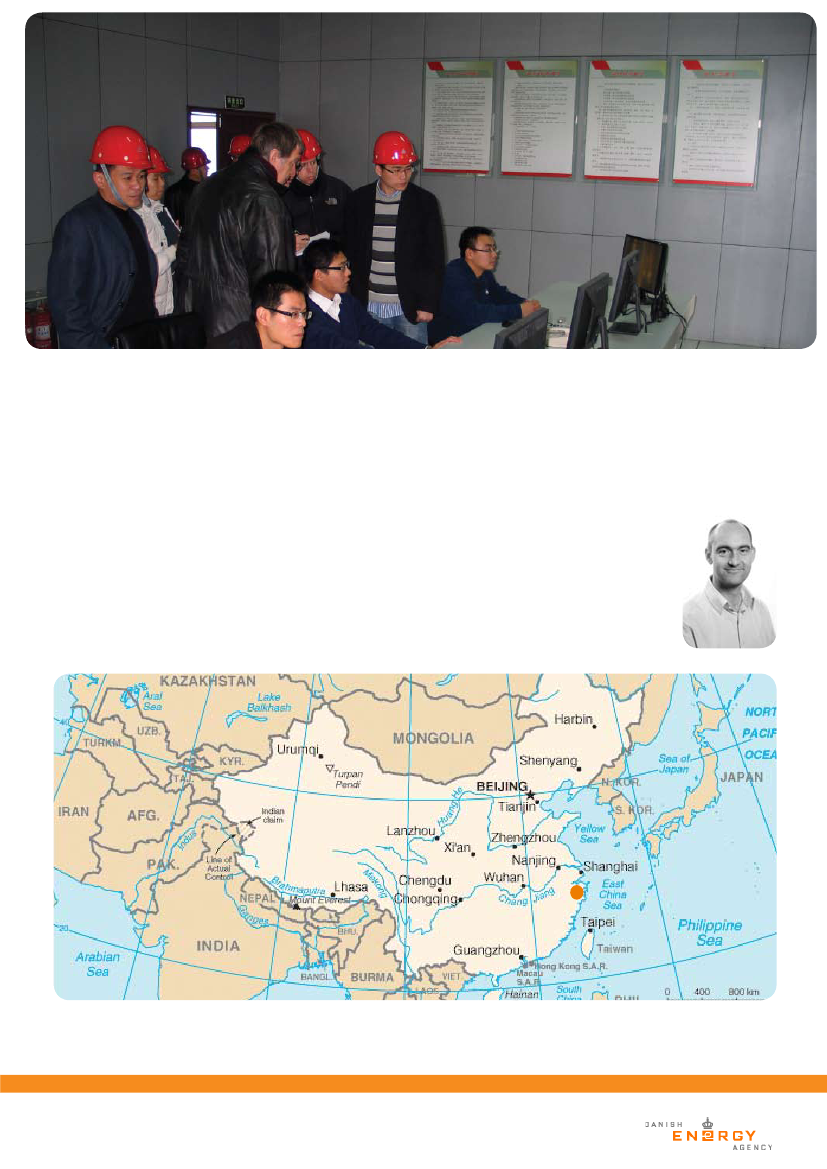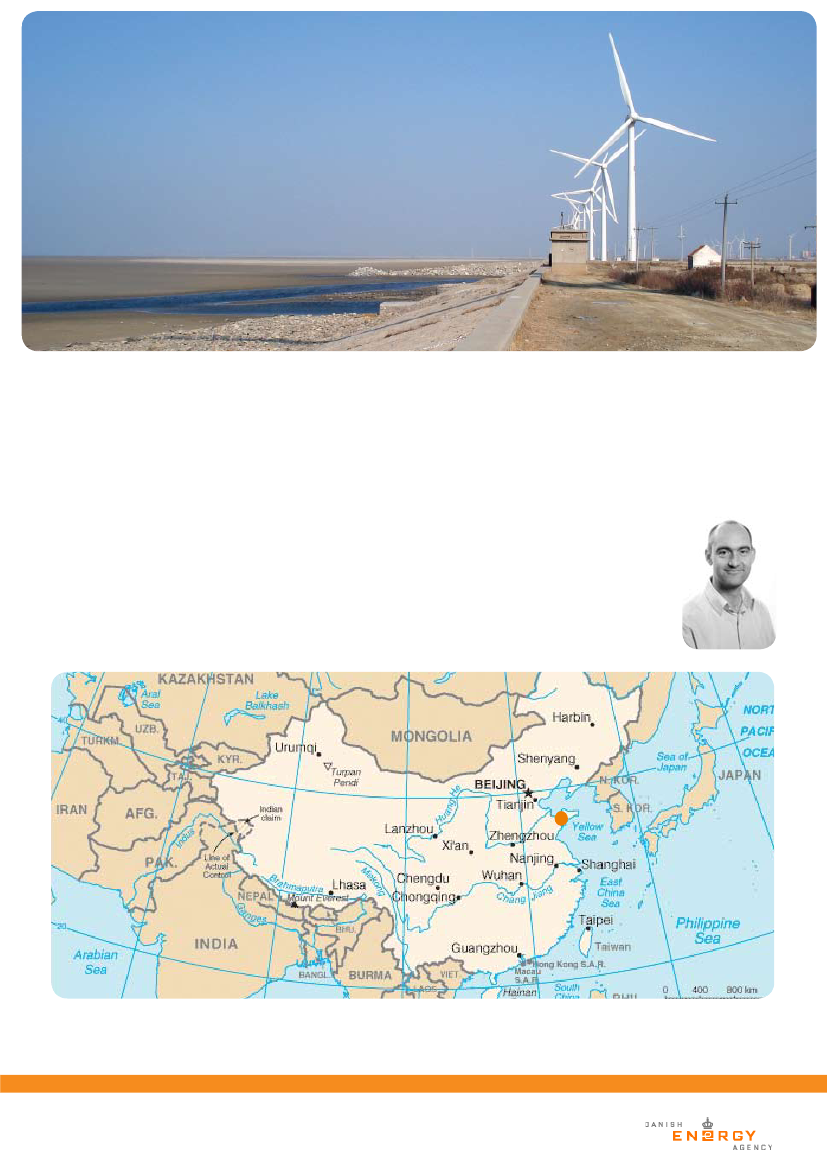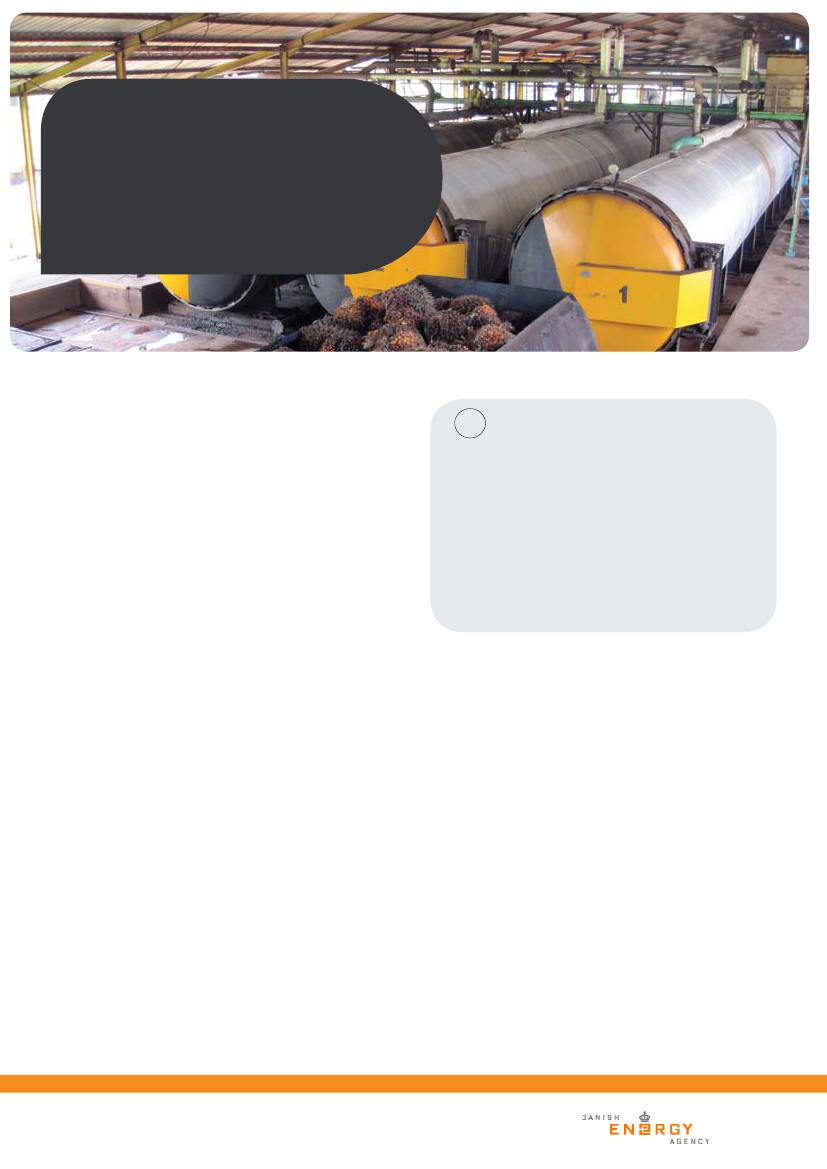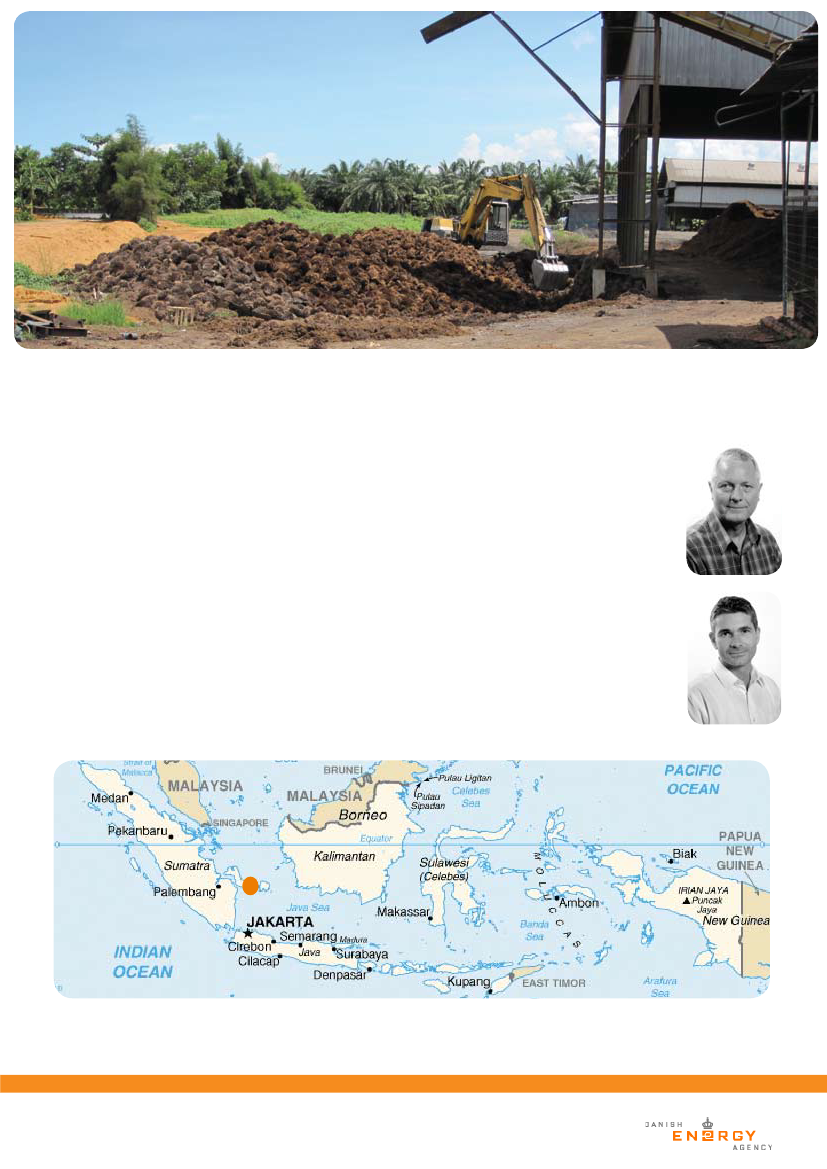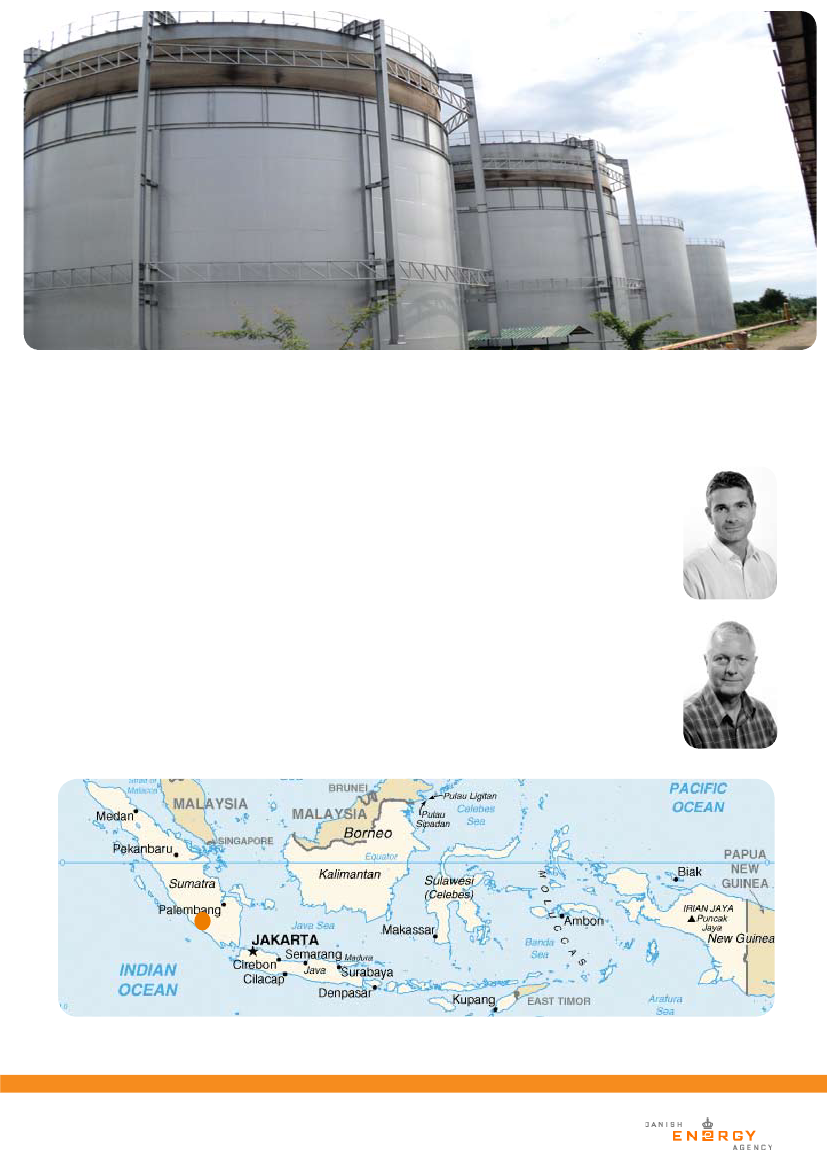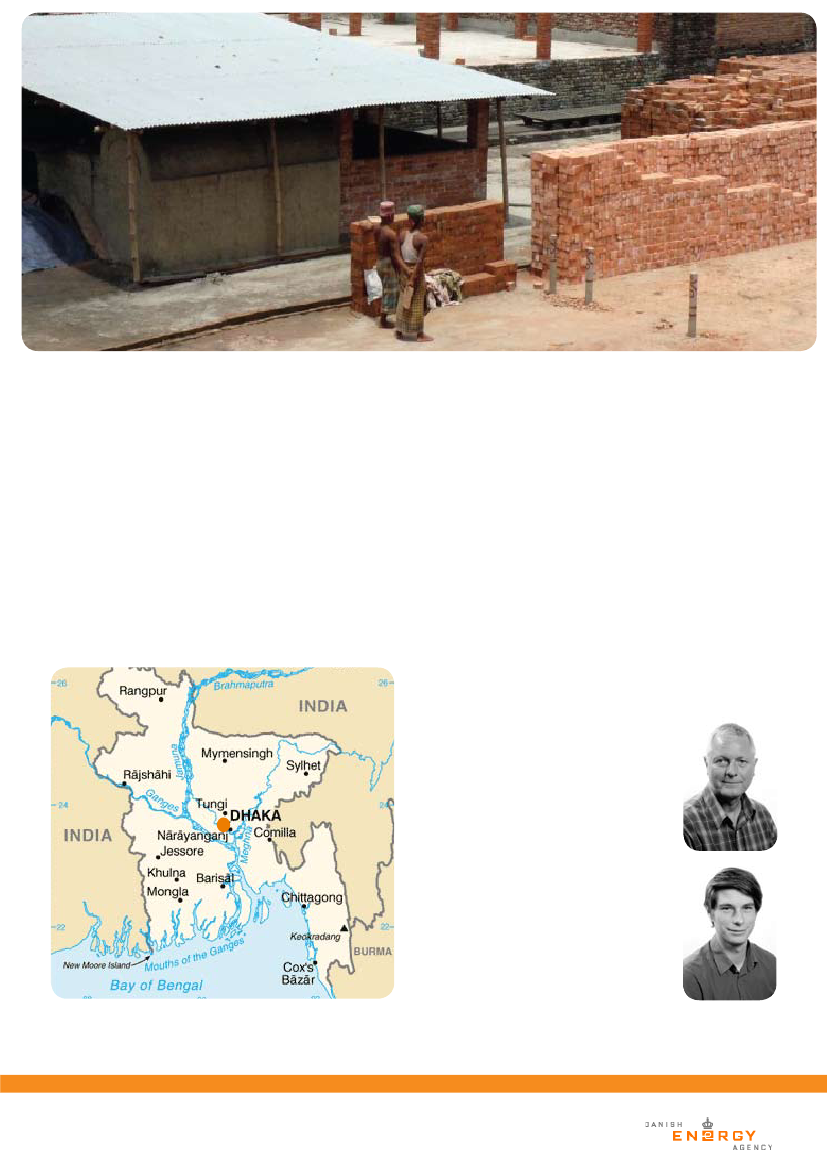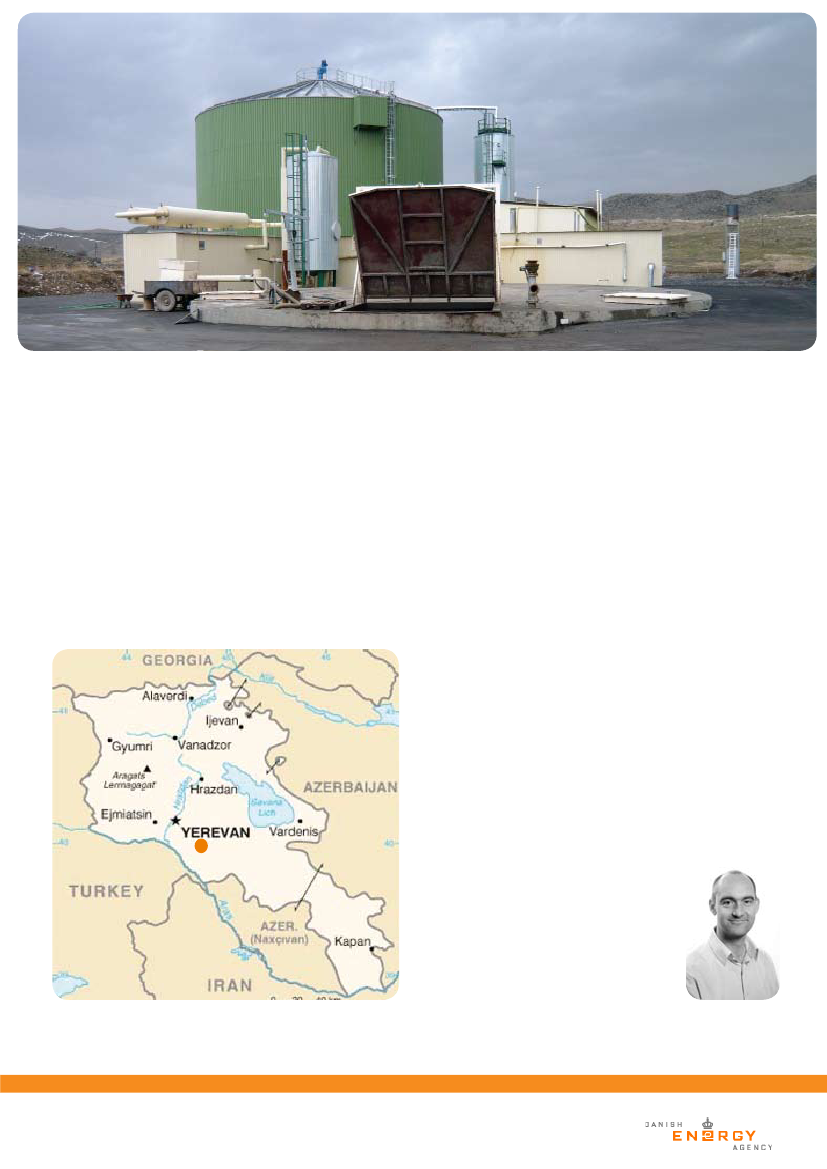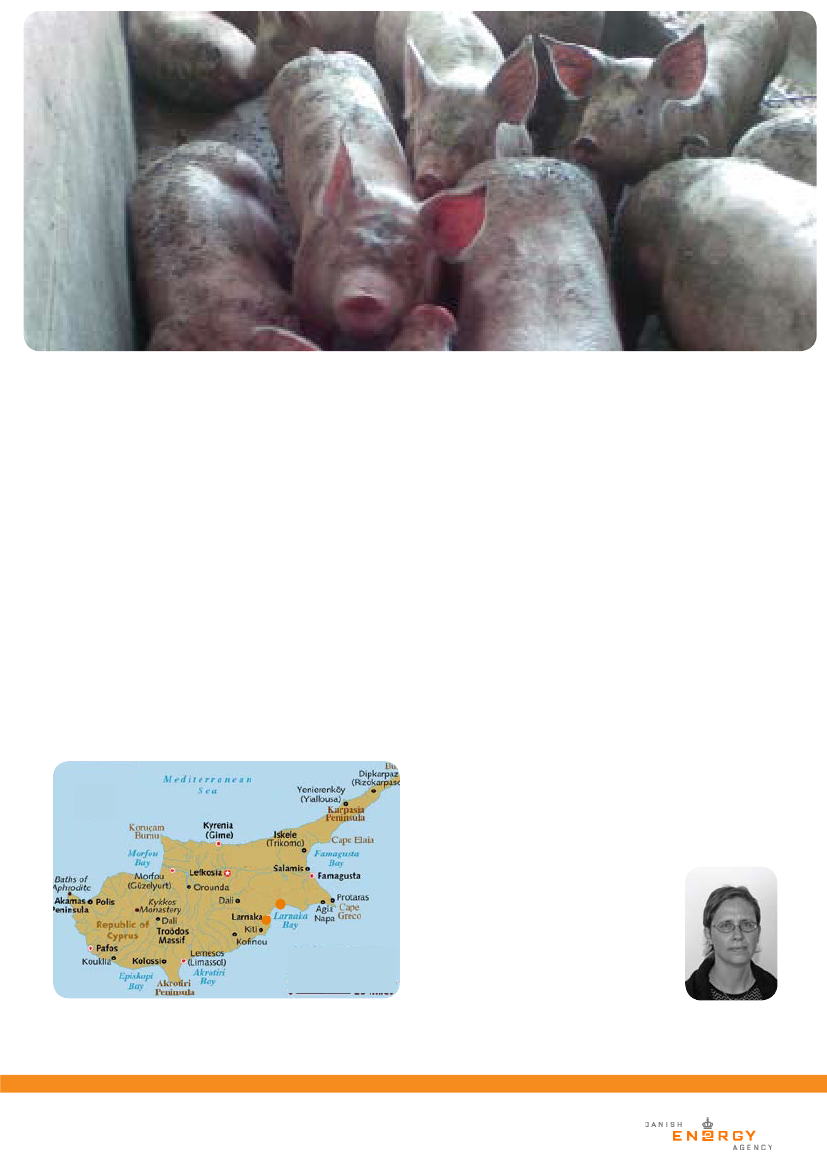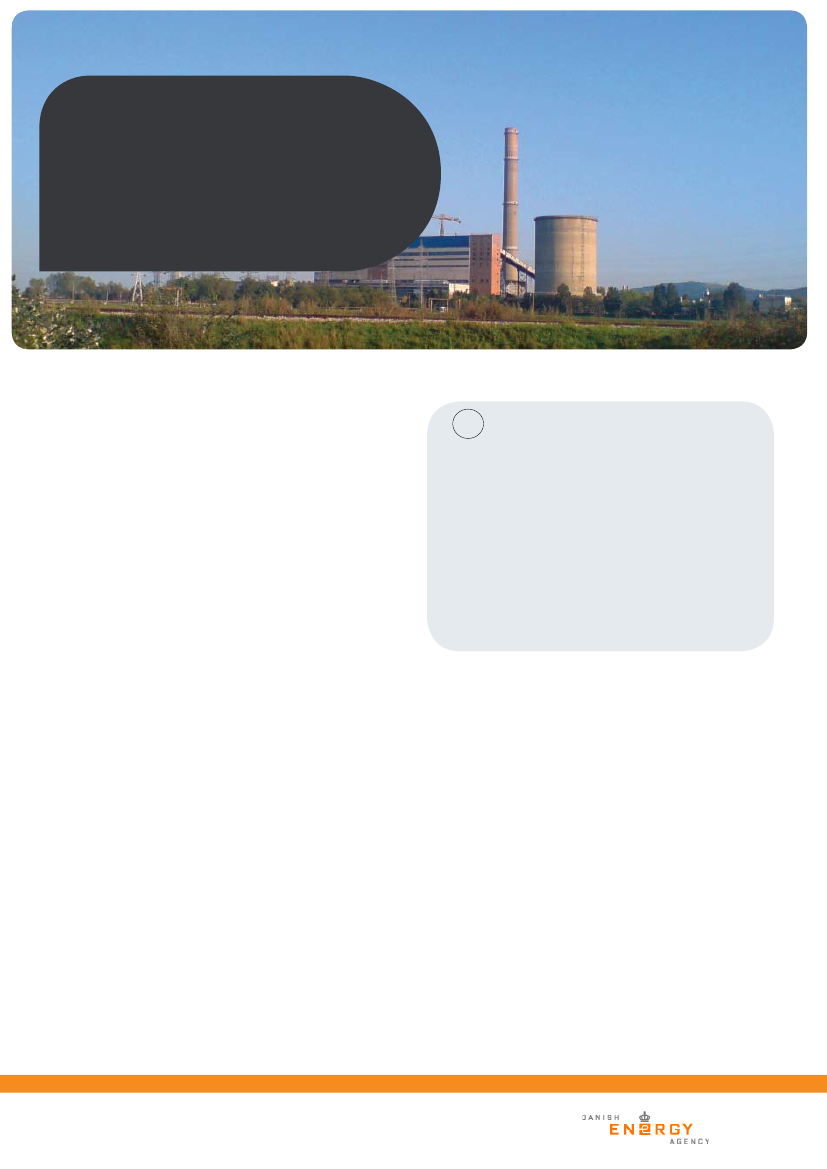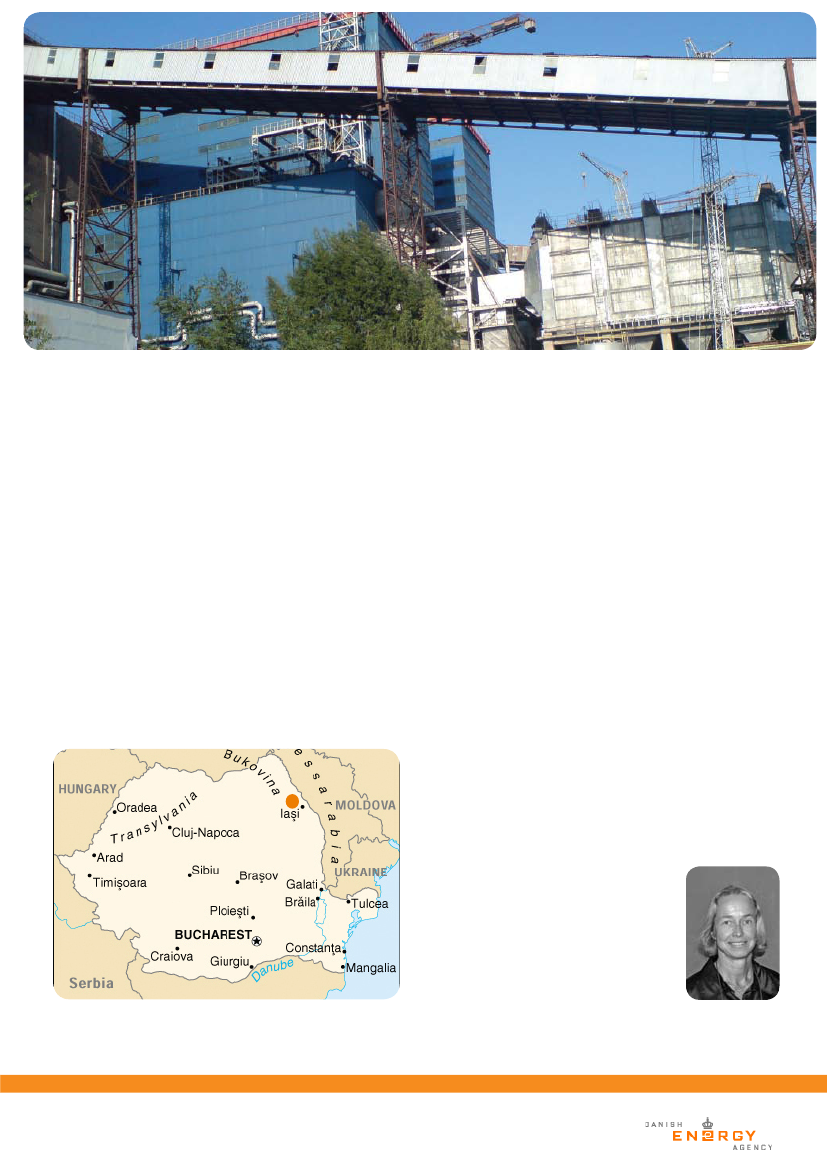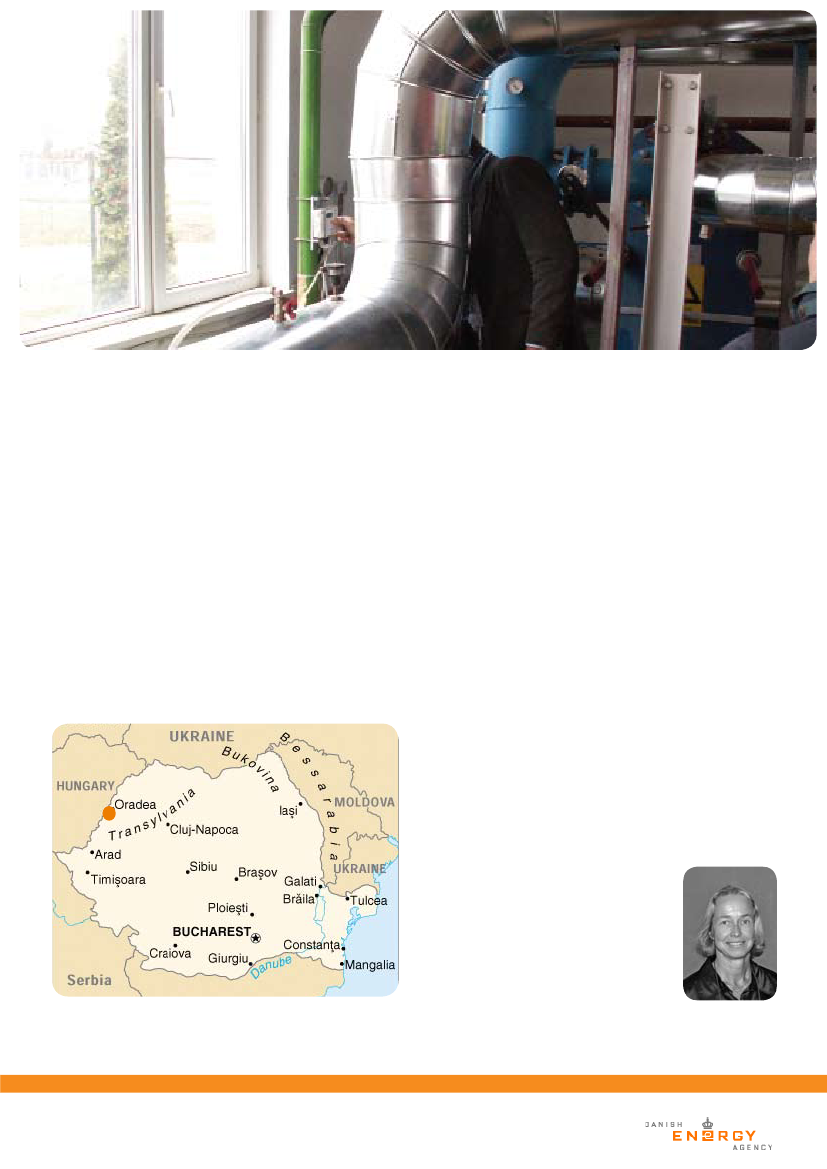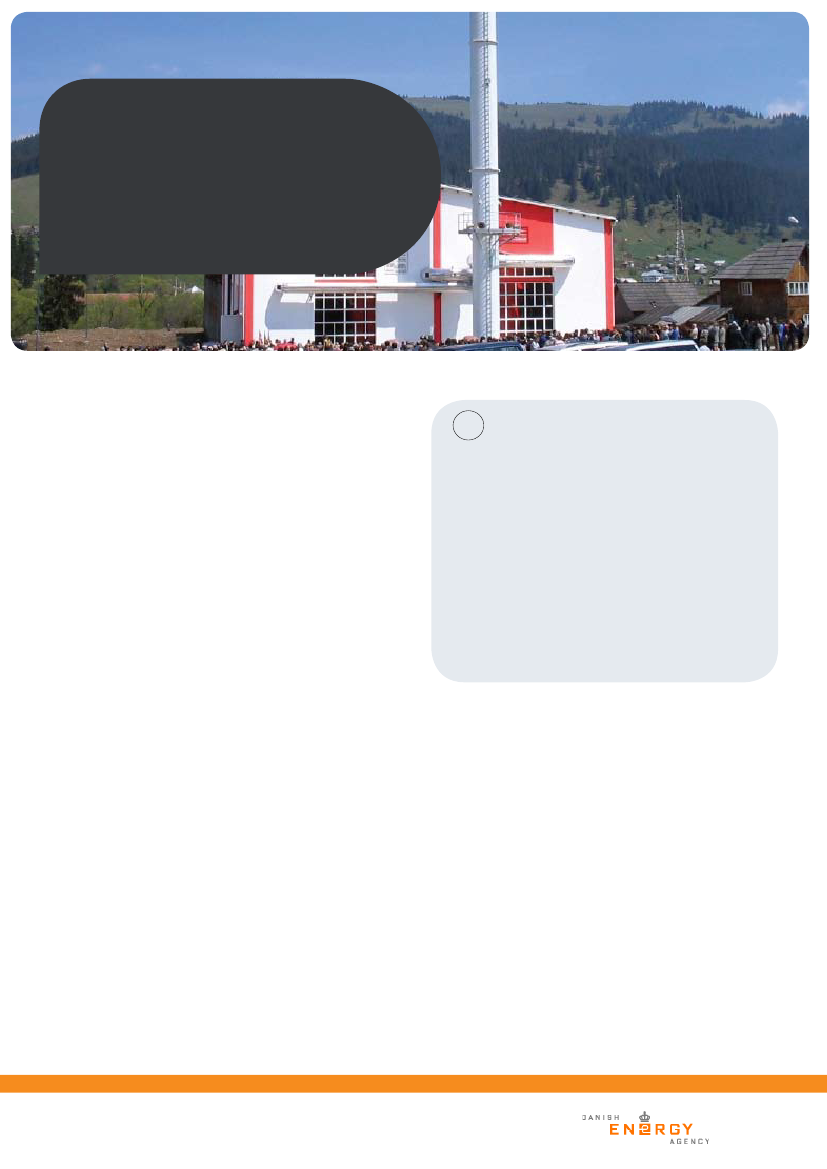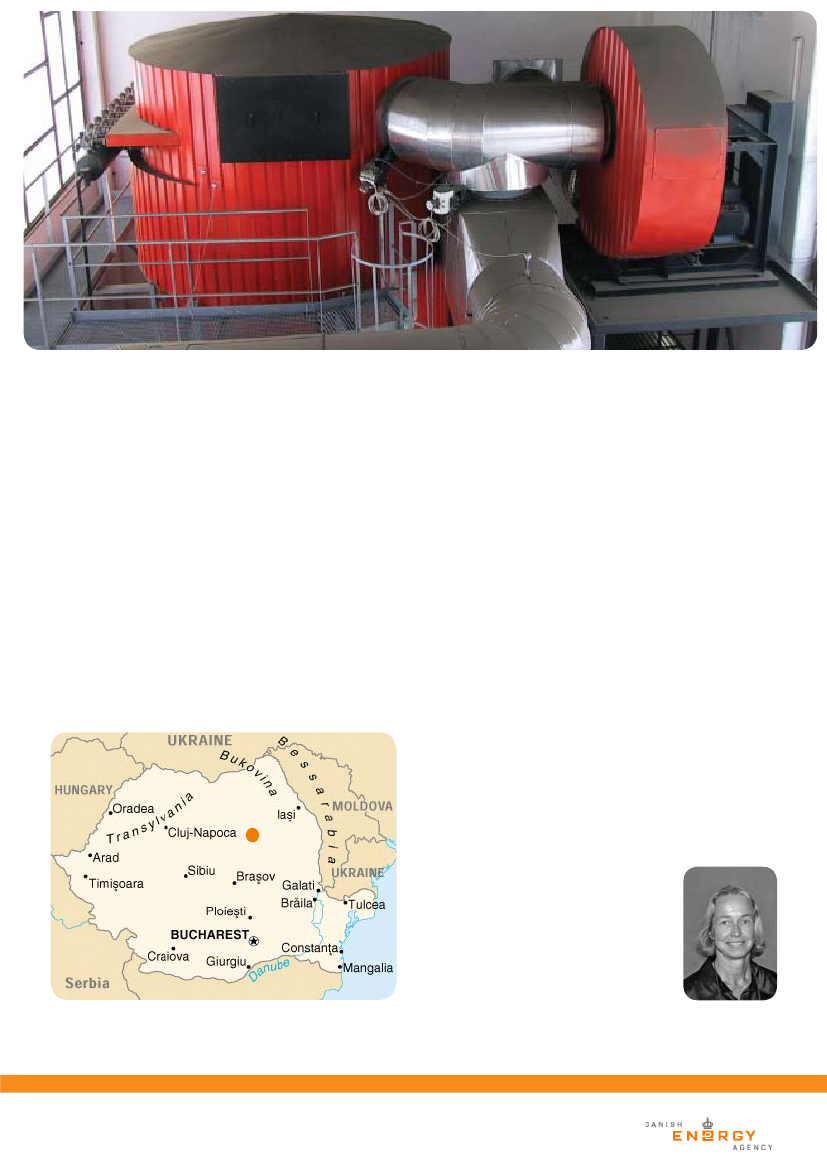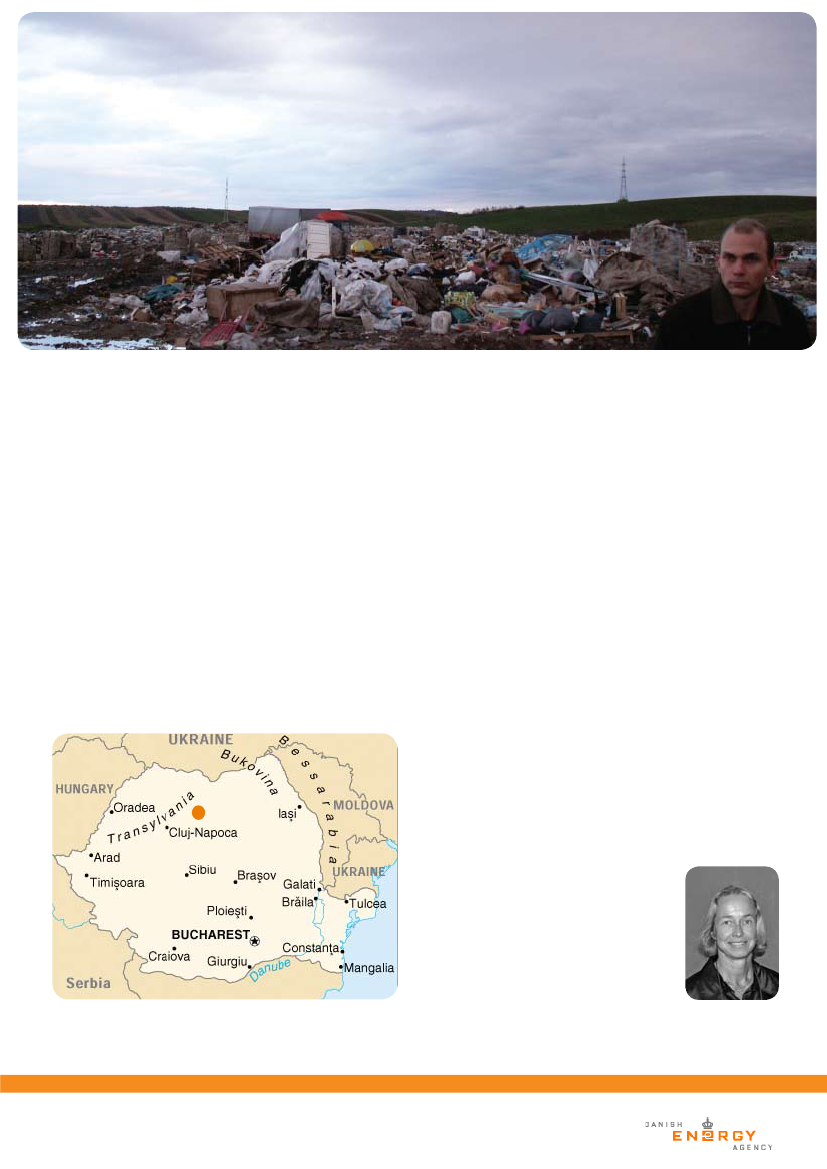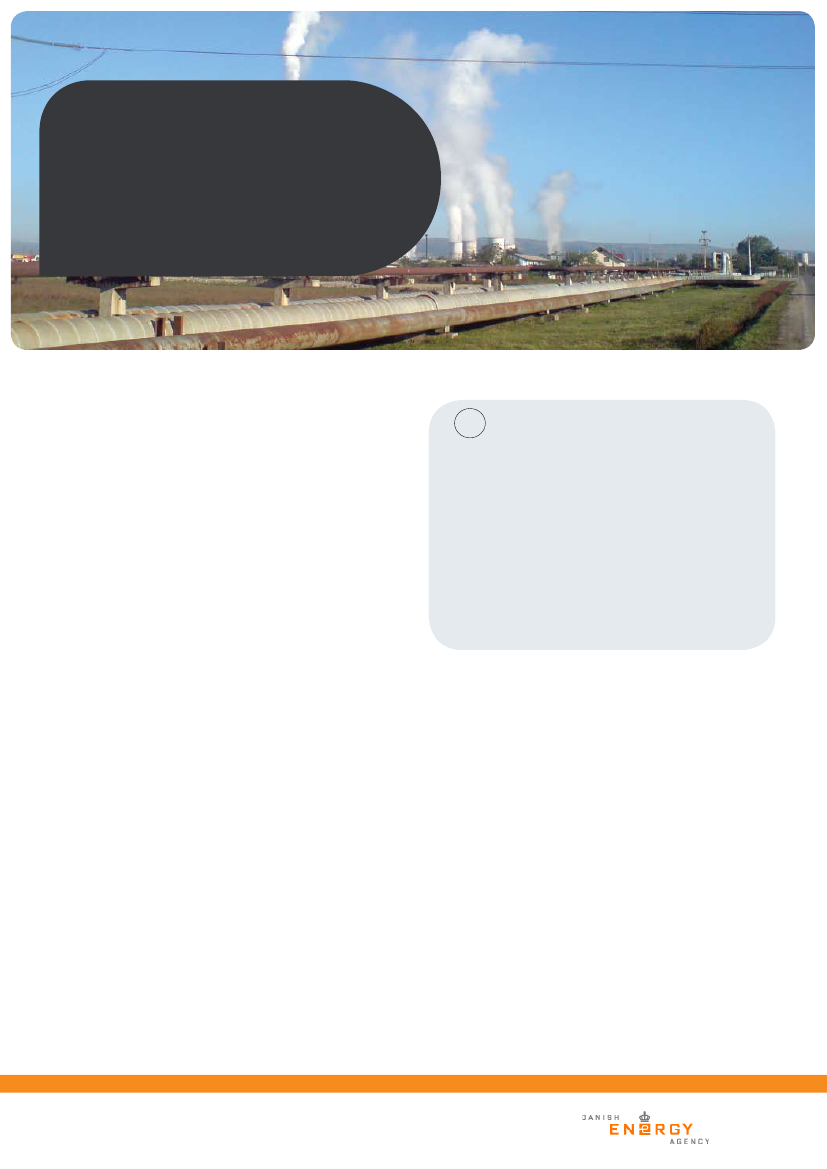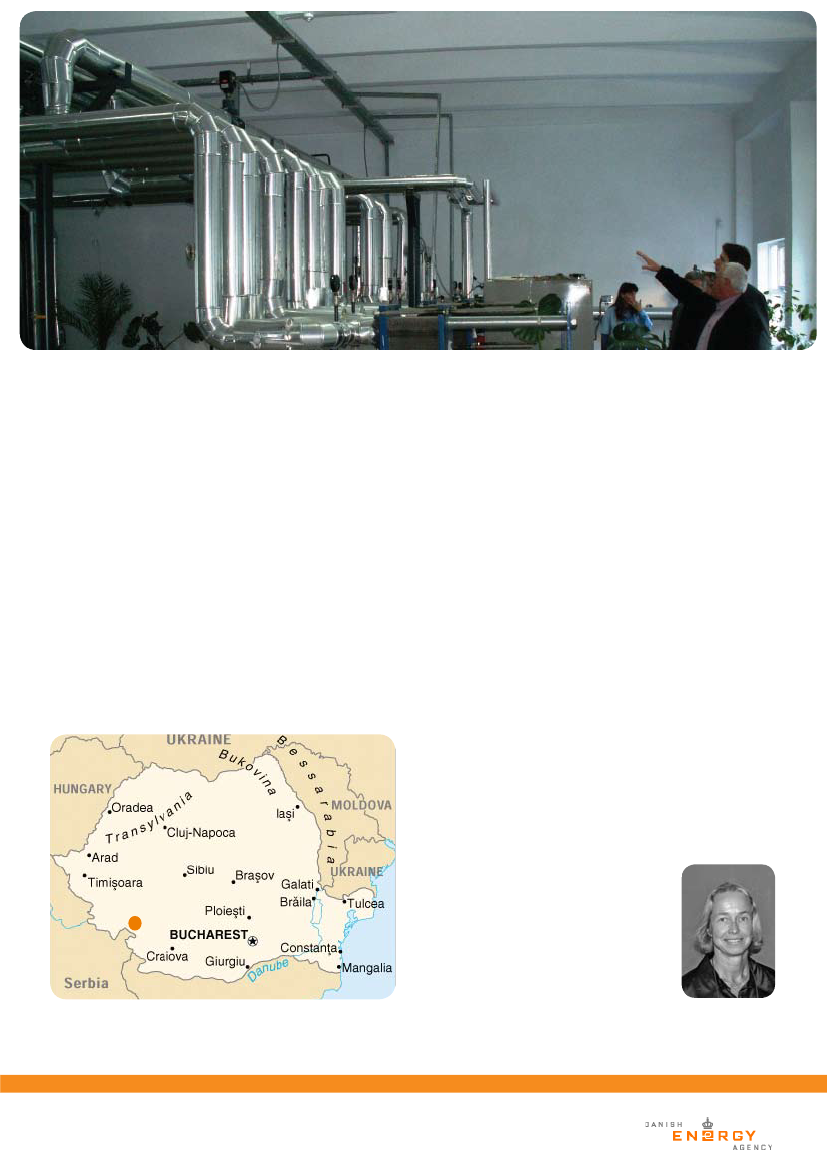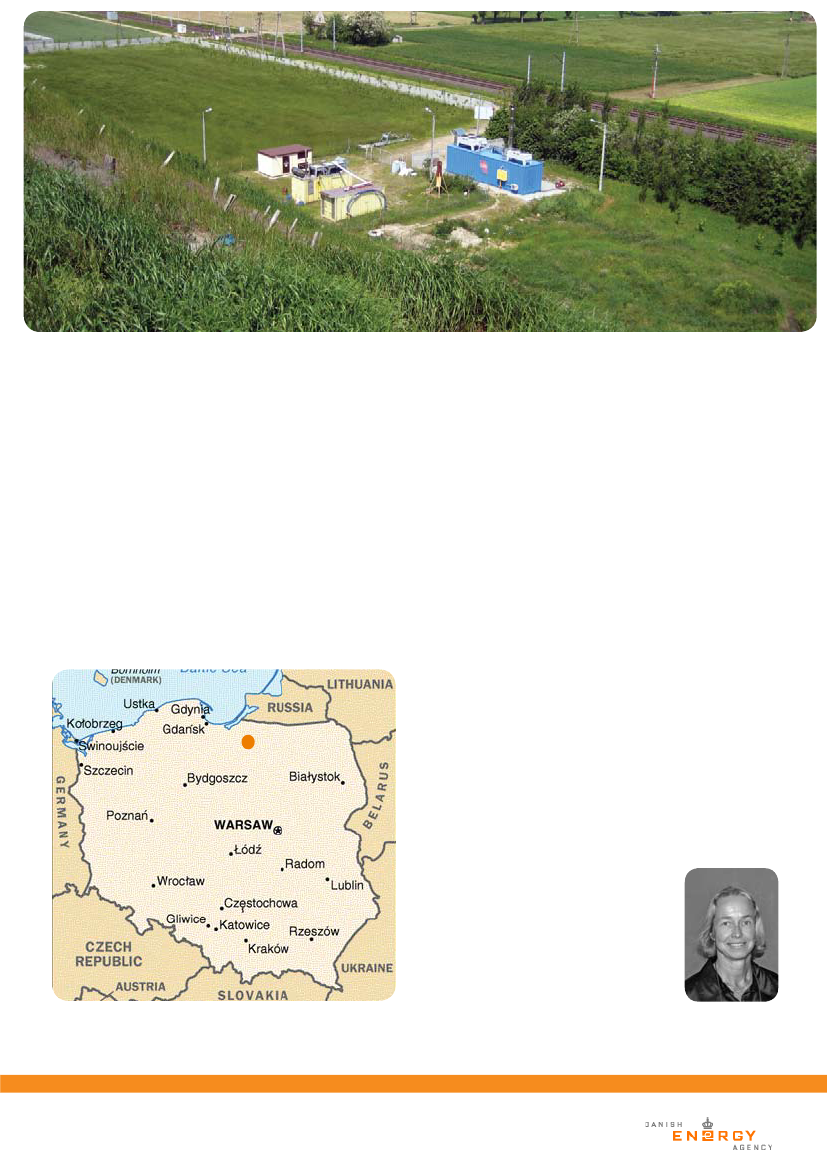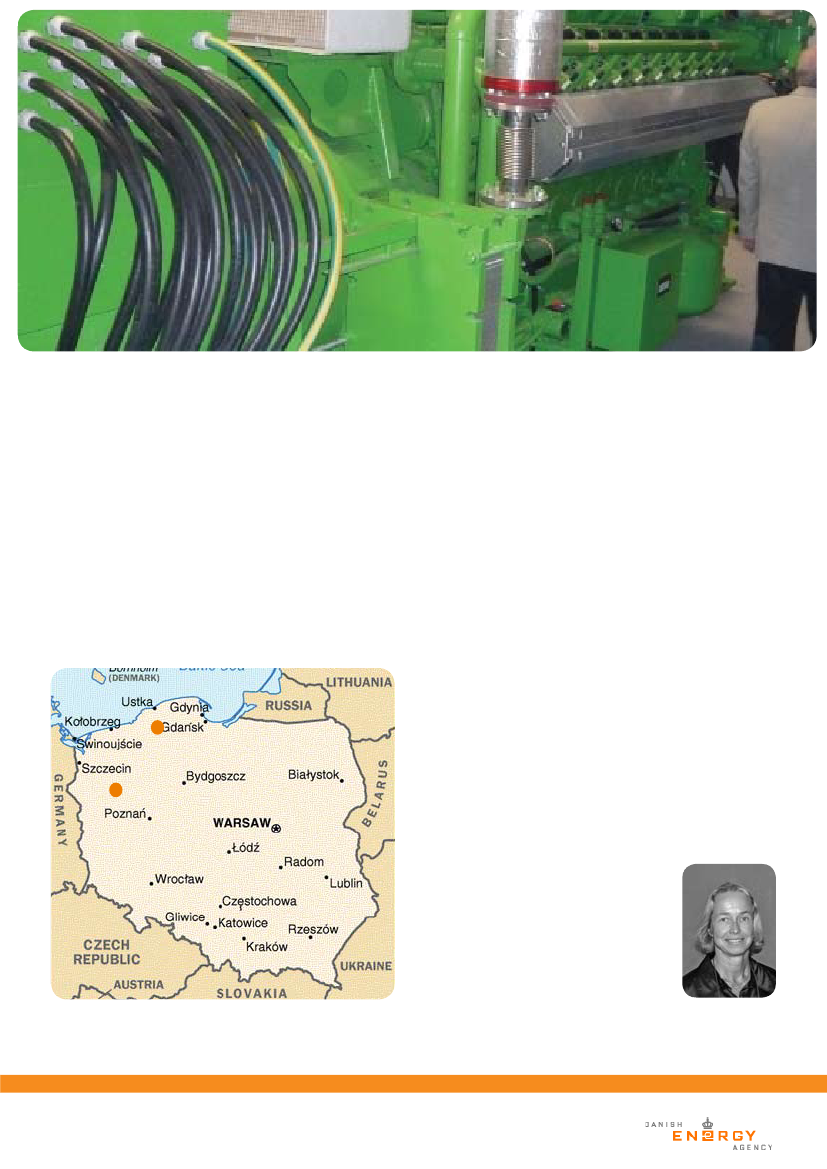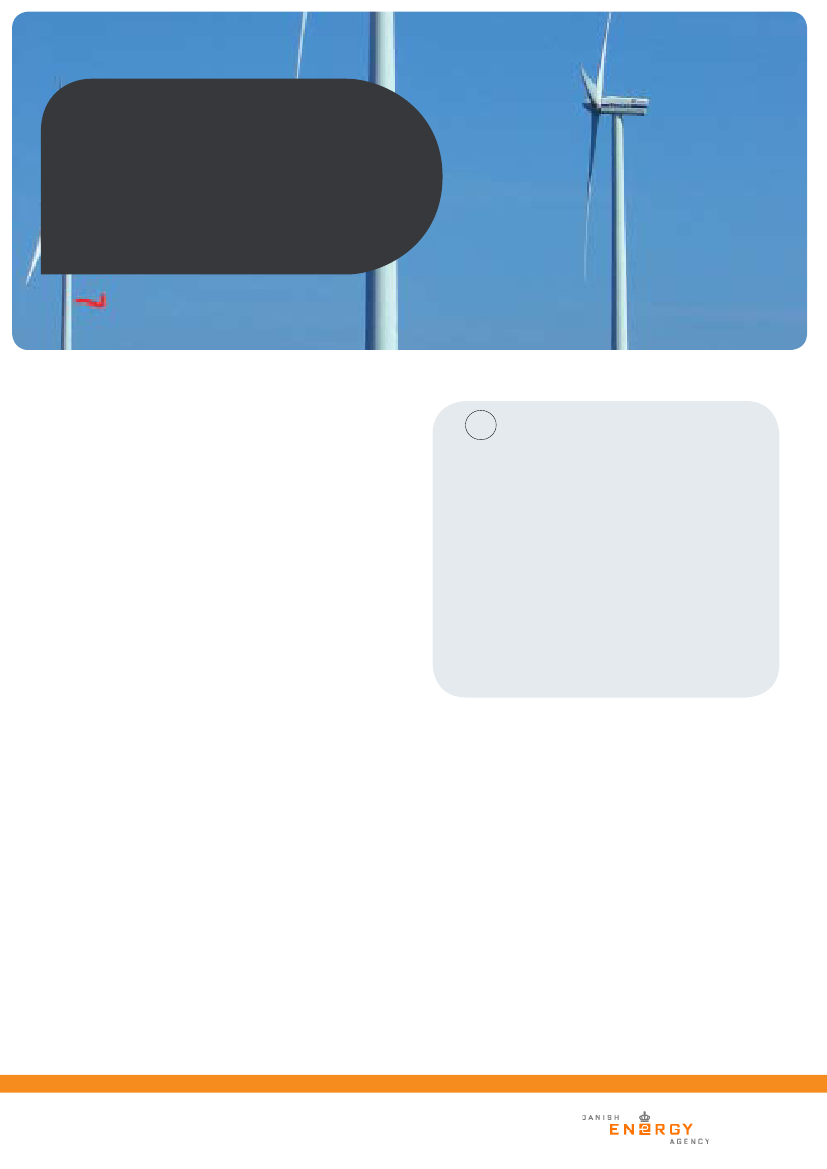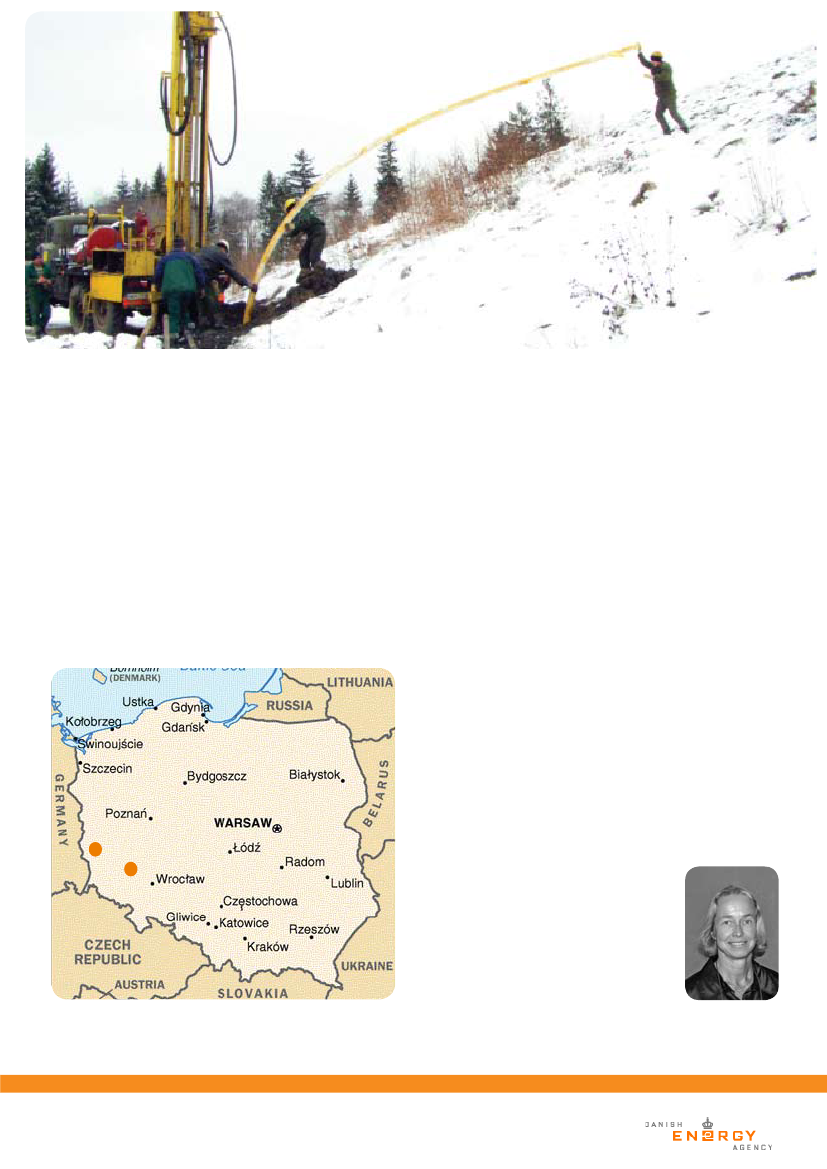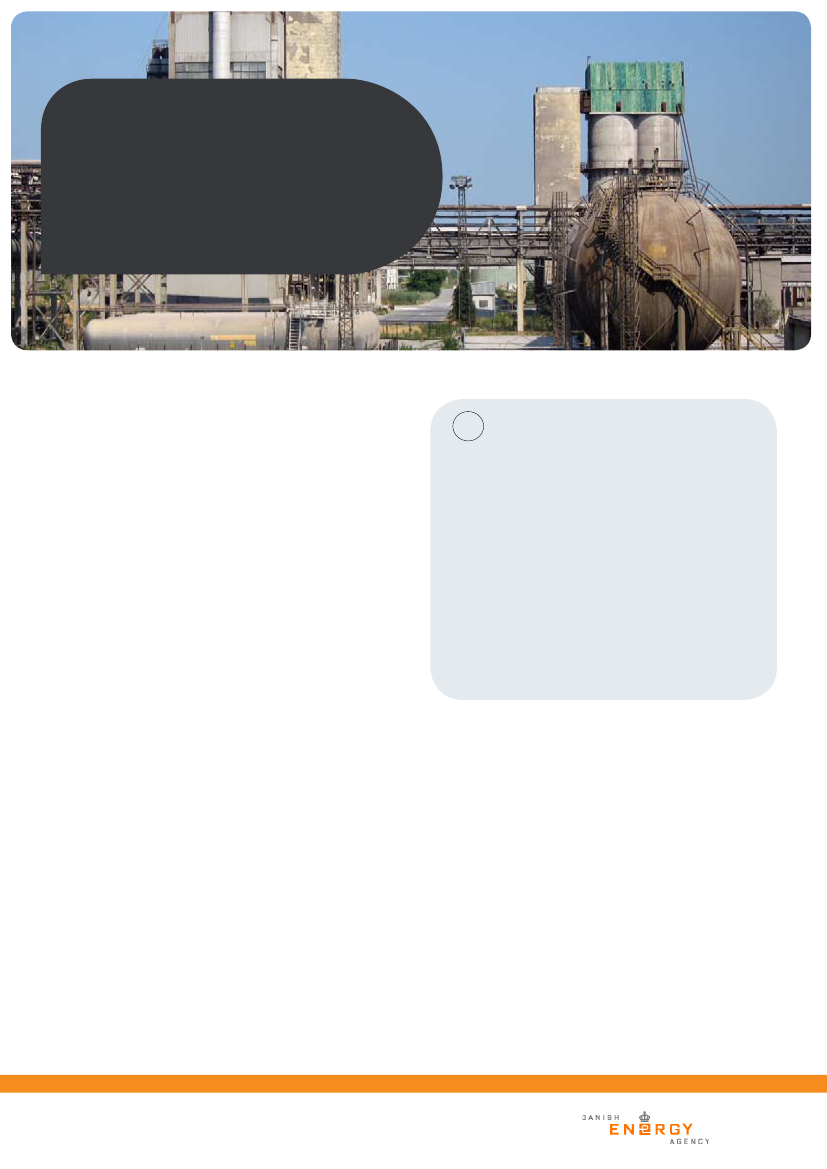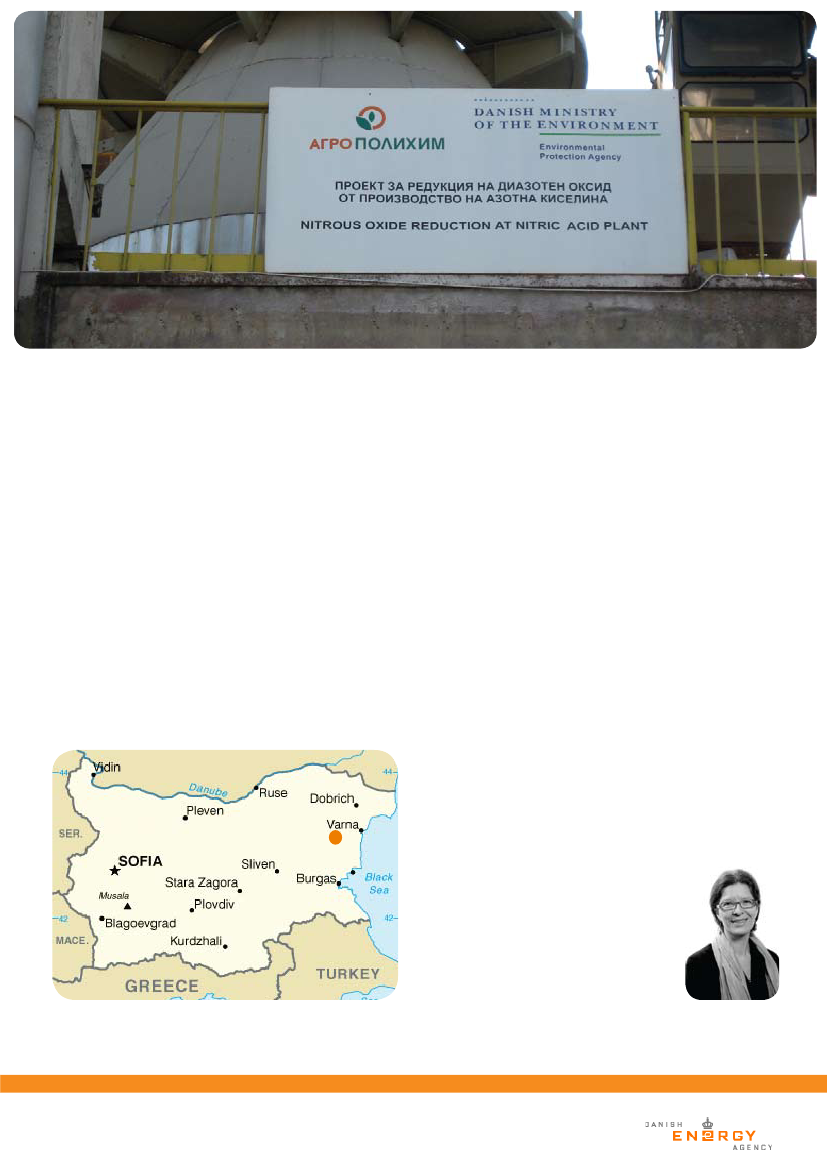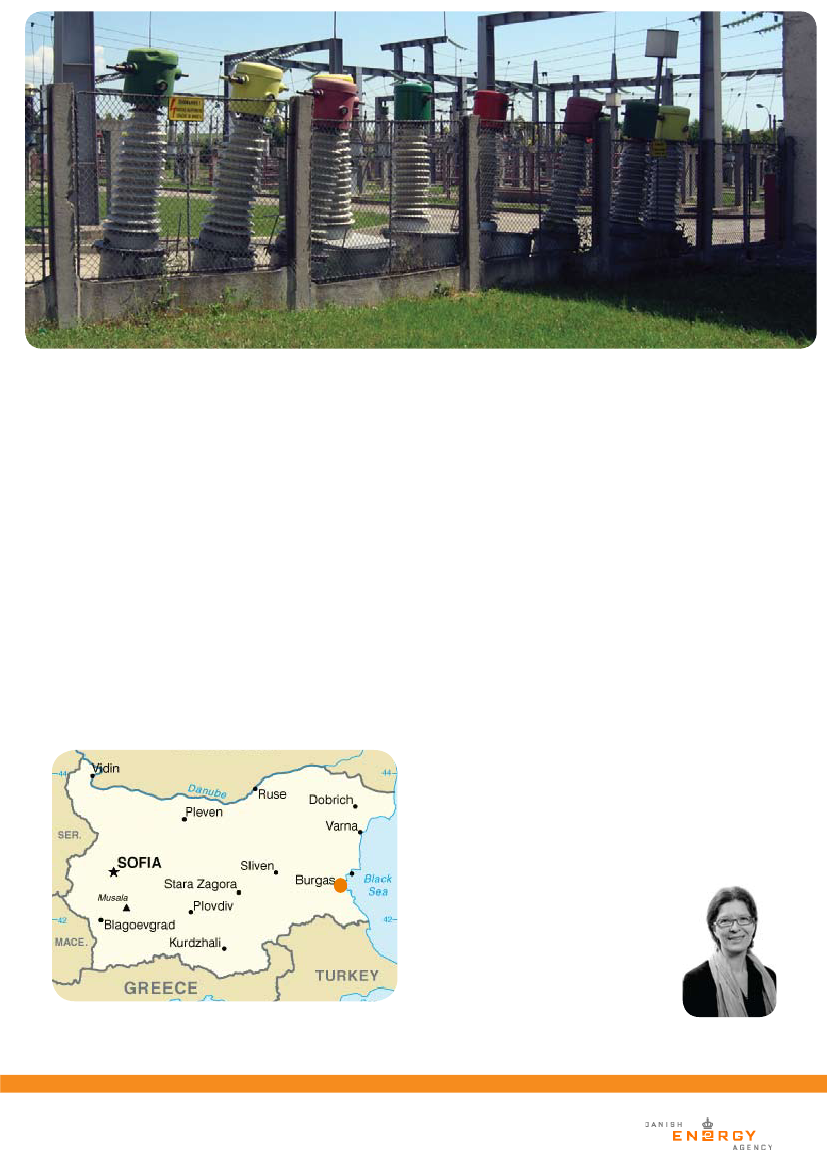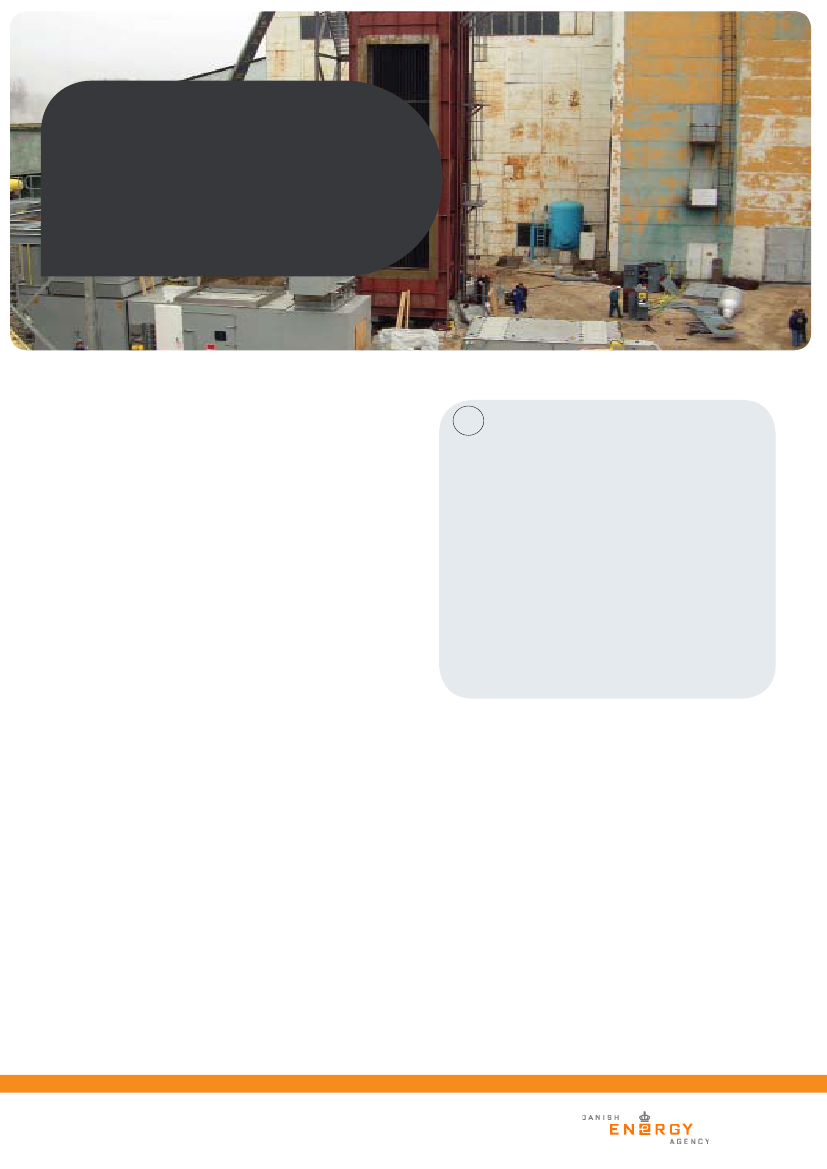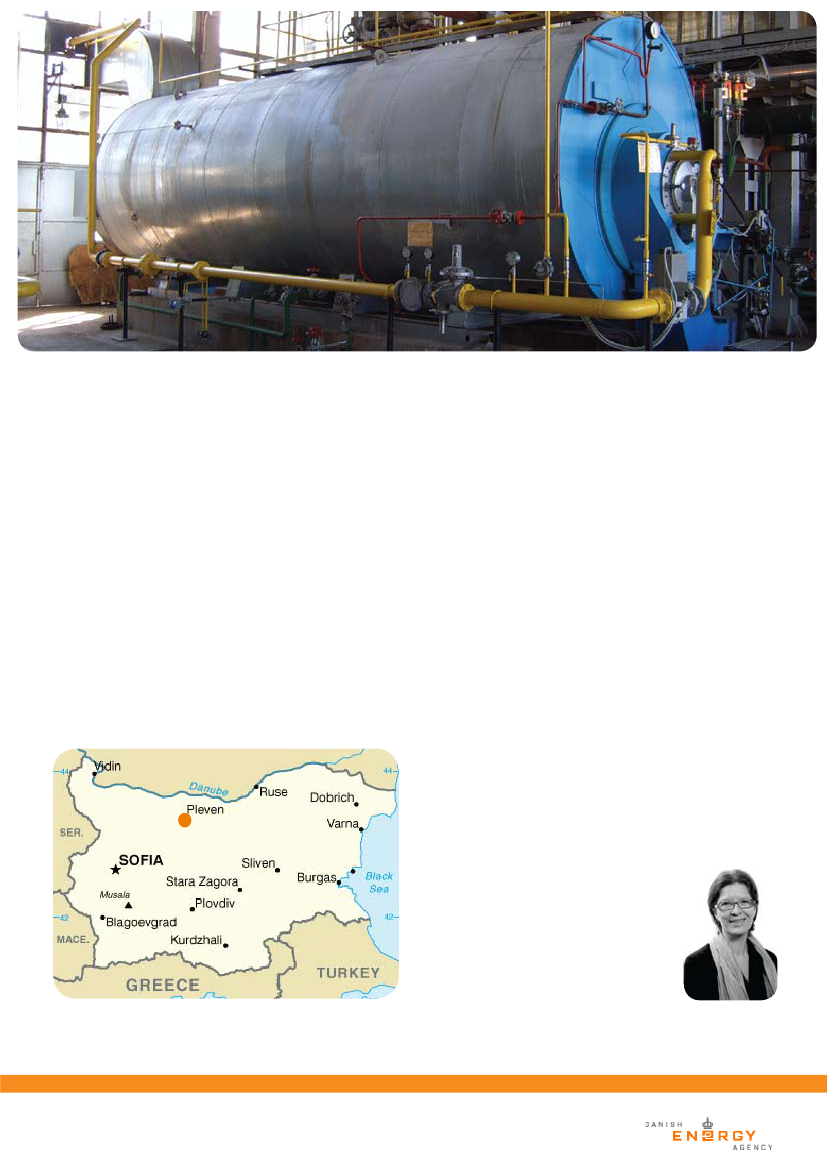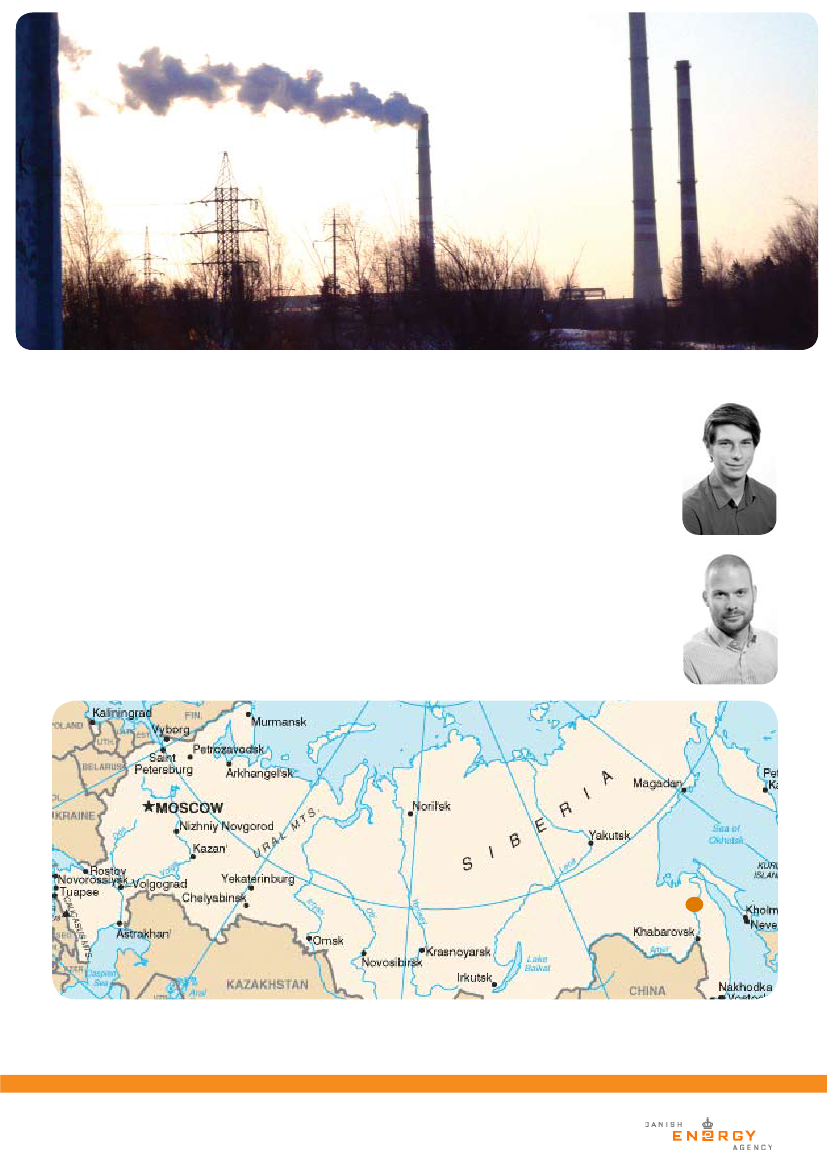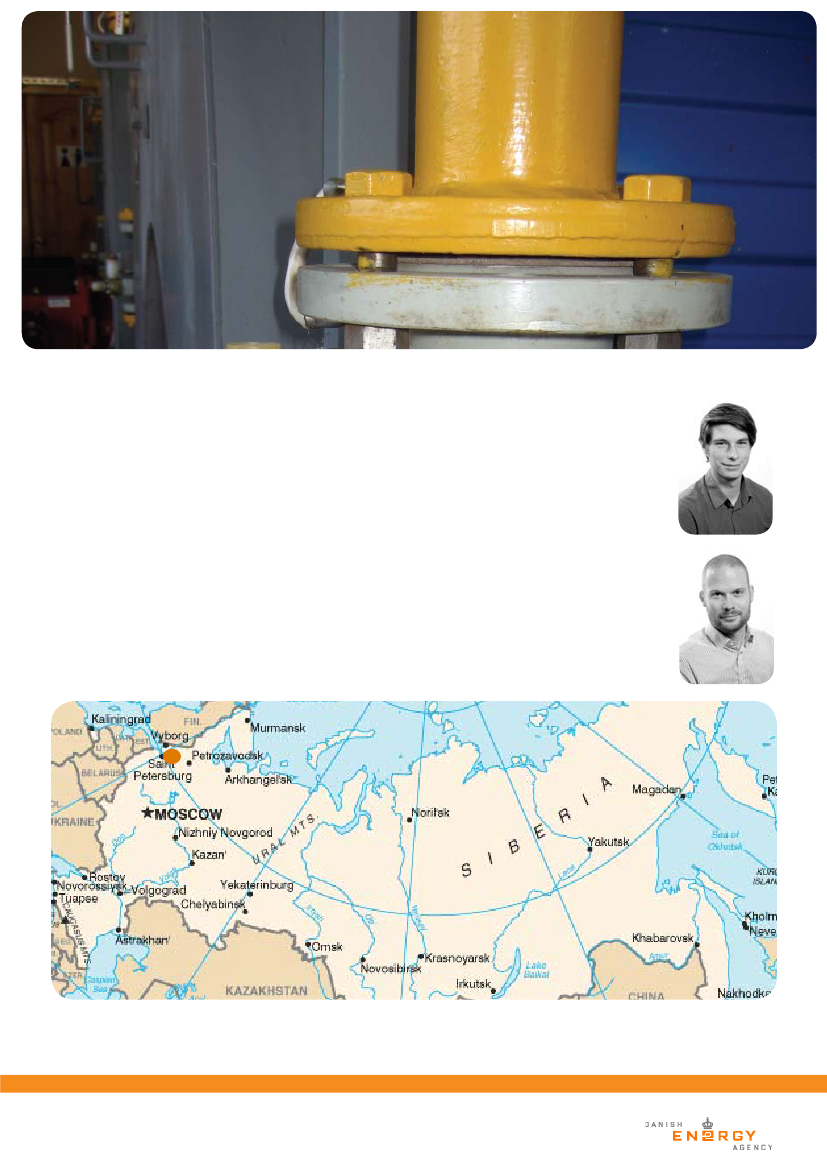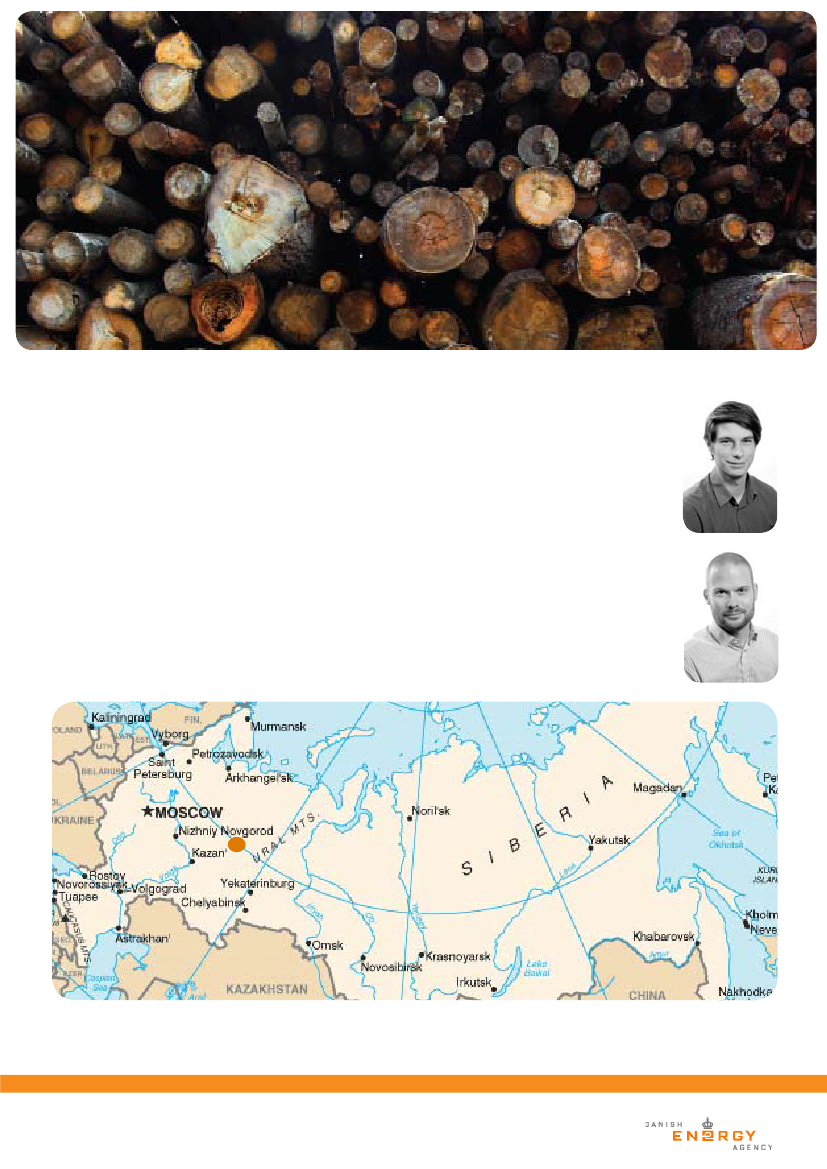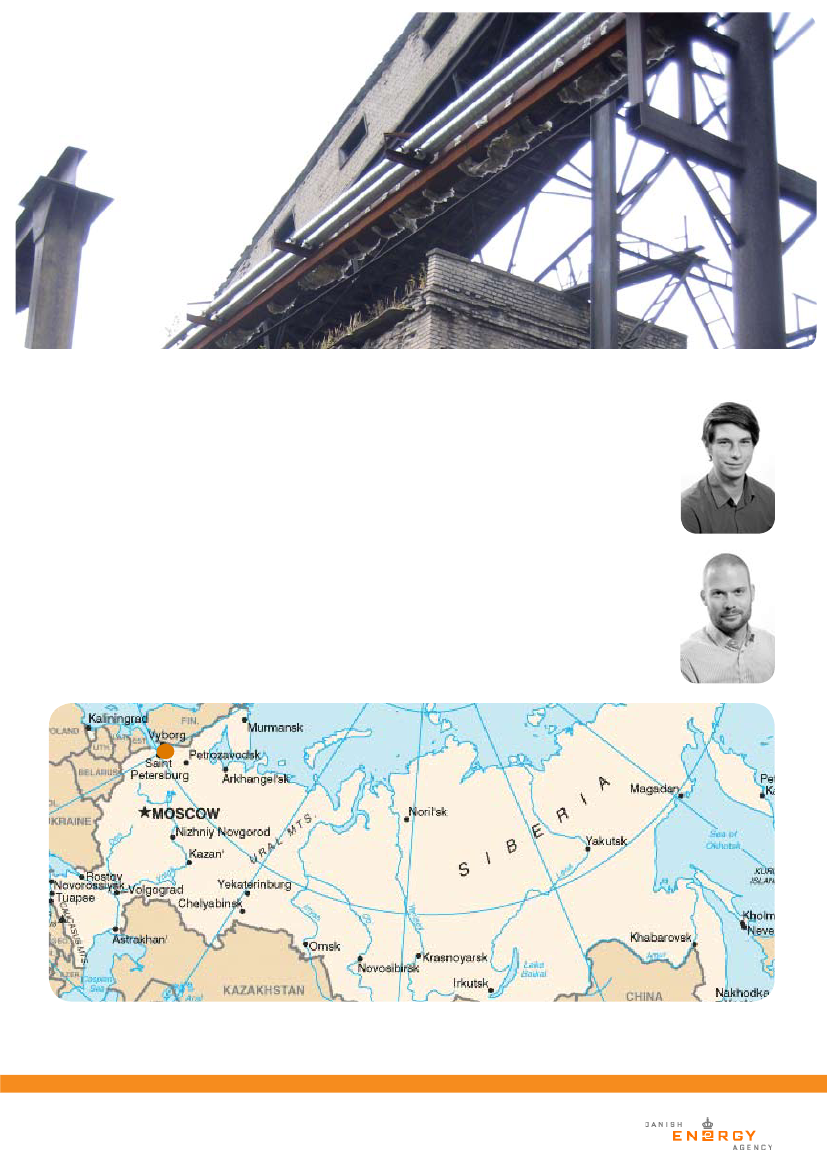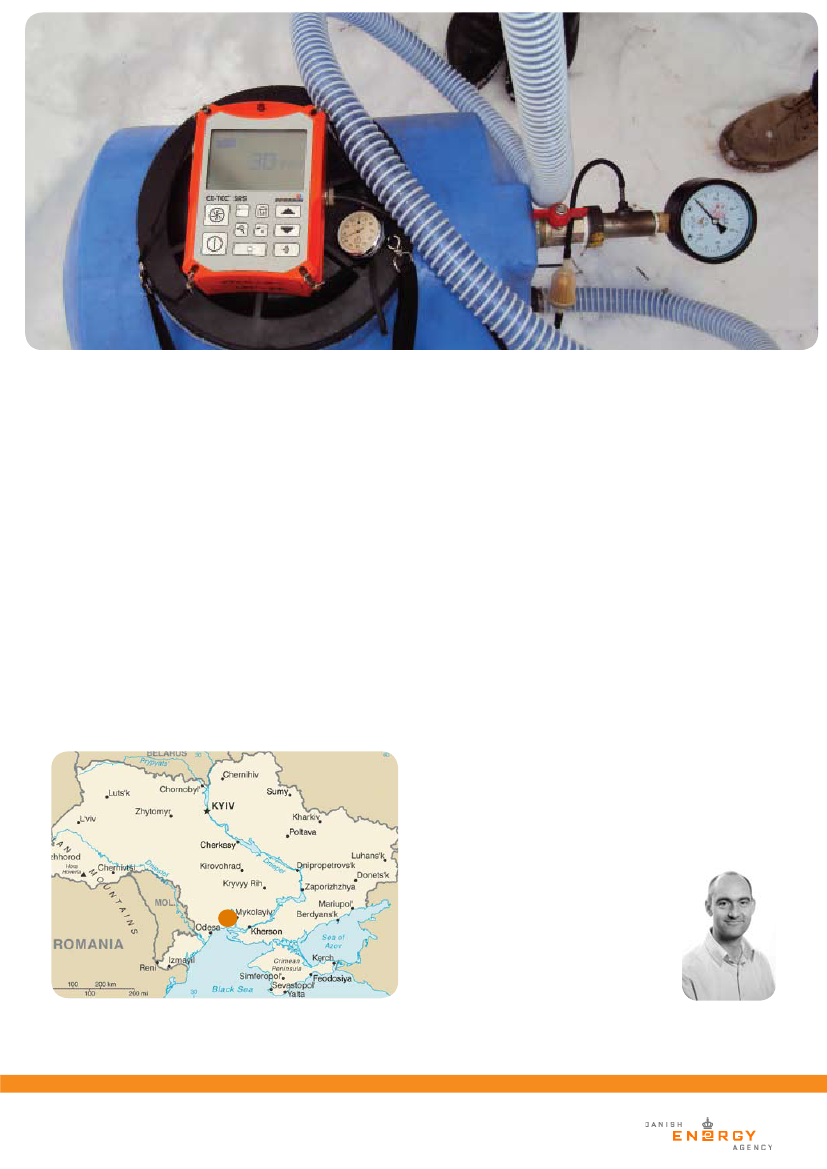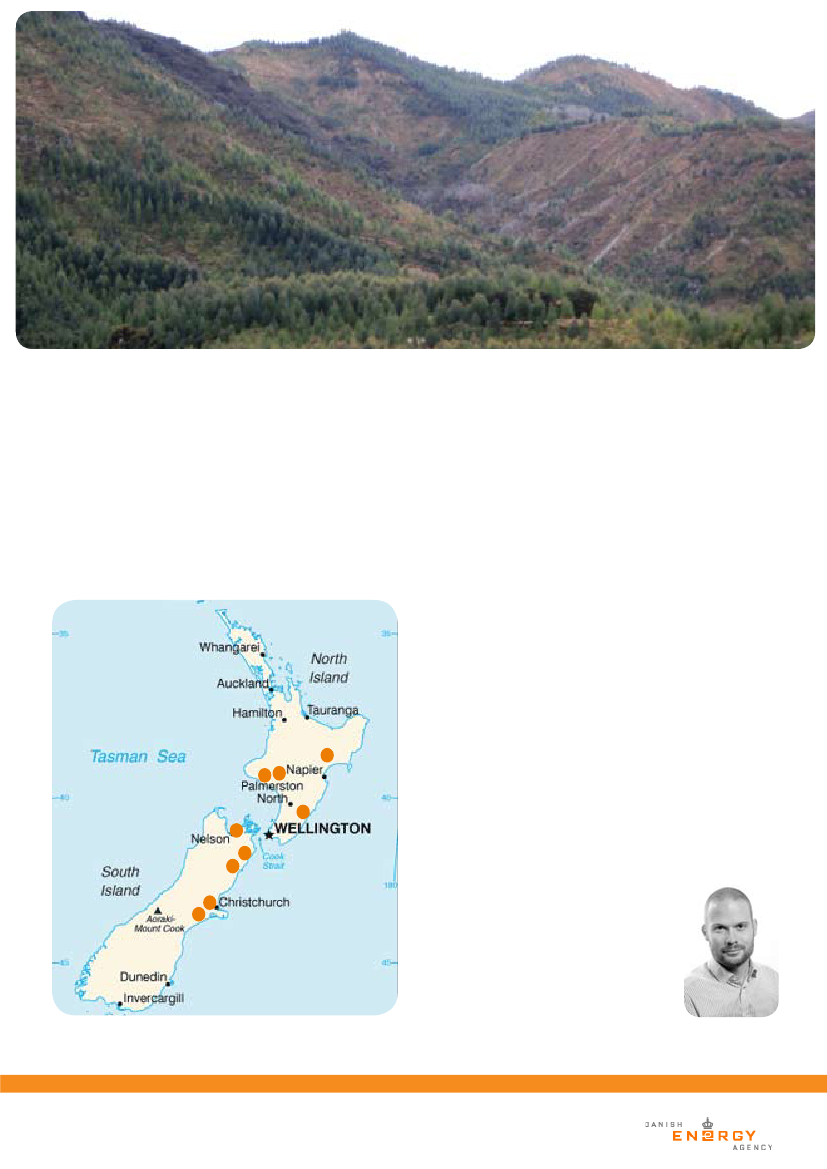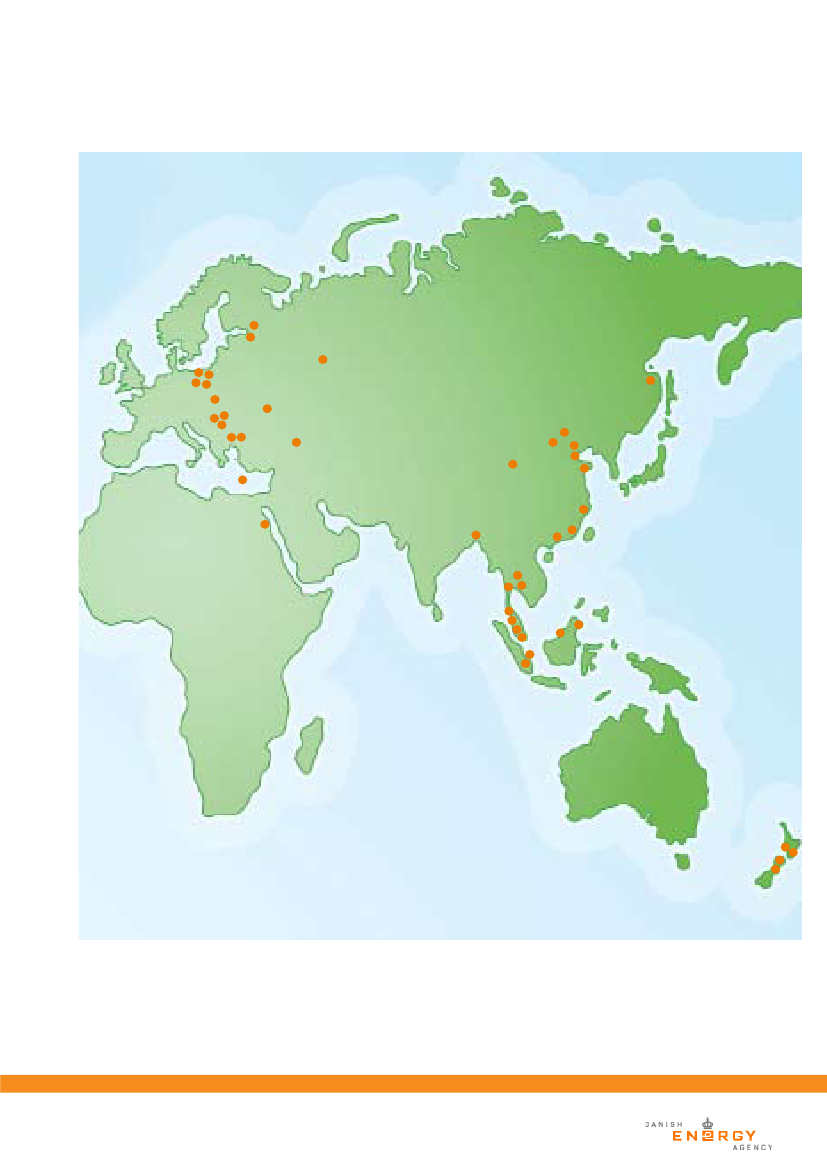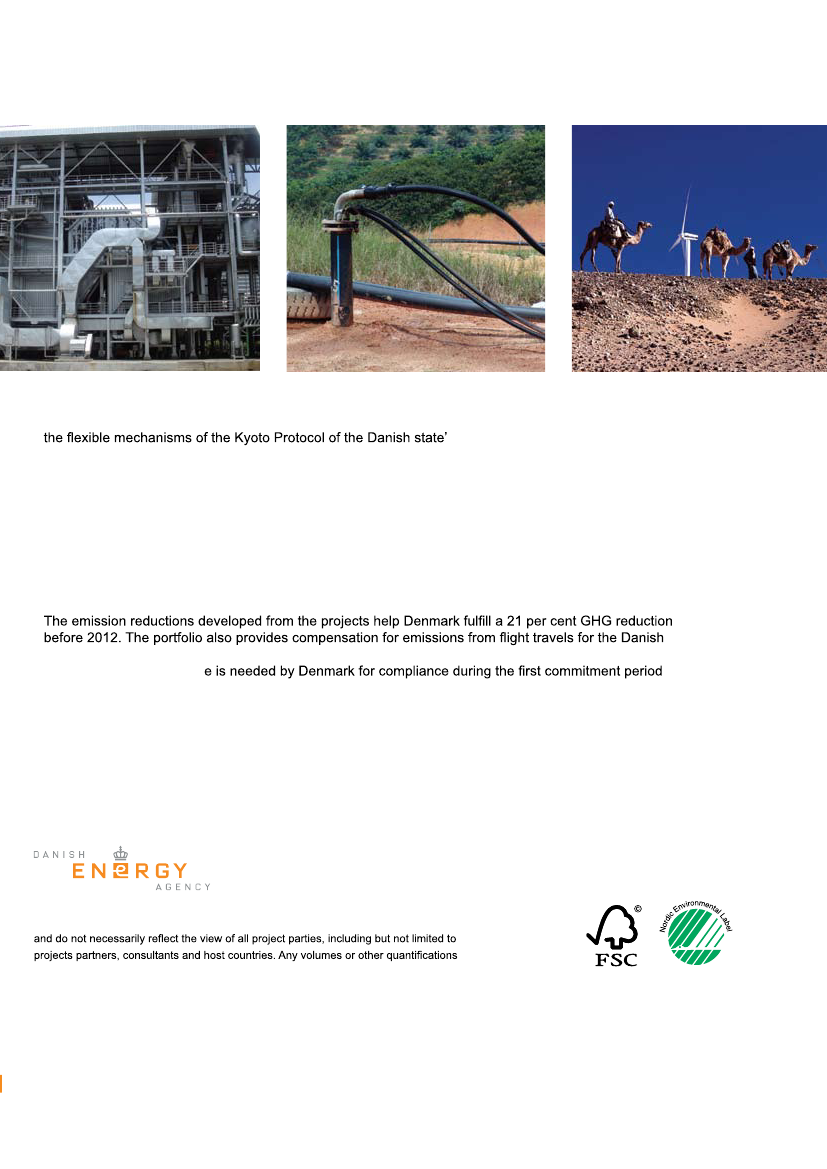Det Energipolitiske Udvalg 2010-11 (1. samling)
EPU Alm.del Bilag 30
Offentligt
The Danish JI andCDM ProgramSeven years experience with climate projectsaround the world
|Danish Energy Agency, Amaliegade 44, DK 1256 Copenhagen K, Tel: +45 33 92 67 00, Fax: 33 11 47 43
In 2003, Denmark was one of the first countries globally to enter the emerging climate project arena in developing JI/CDM-projects in Eastern Europe and developing countries. With an ambitious strategy, focused at cost efficient project developments combined with long term sustainability, close partnerships and social responsibility, we engaged in a new challenge, determined to become one of the leaders in pushing forward and developing a global market for GHG-reduction. Not only seeking to provide cost efficient reductions for Denmark, but for our globe as such. Based on the advanced Danish energy solutions we had a special opportunity engaging in the JI/CDM project development to transfer our experiences in combining support for CO2 reductions with sustainable industrial development and transfer of modern know-how, technology and capital to foreigncountries within the framework of the Kyoto Protocol. Now, having passed half way to the mile stone of the first Kyoto commitment period, we can look back and see that JI/CDM has become important mechanisms, appreciated by the many host countries, and that Denmark has a well-performing and well-founded portfolio of projects with significant environmental and social benefits for the local communities where the projects are located. The Danish way has proved that sustainability and close partnerships may go hand in hand with high performance and cost-efficiency. Through our close collaboration with project partners, our own local representatives, experiences with capacity building and support of many experts and consultants we have built a diverse and solid project pipeline in many countries with a wide range of technologies – focusing among others on biomass, fuel switch, energy efficiency and wind. Based on this partnership model, it has been possible to navigate the often complex JI/CDM processes in an efficient and cost-efficient way, whether involved in wind farm projects in China, biogas in Malaysia, biomass in Romania or district heating in Russia. In recent external reviews, the portfolio projects of the Danish State got fine ratings above average, and I believe Denmark can be very proud of our international climate projects. Recently the JI/CDM market has reached a more mature stage, where other tasks than capacity building and market development have gained importance. Thus, based on all the good experiences from the many years of dedicated work with internationalJI/CDM projects, we have launched a domestic Joint Implementation initiative with the aim of realising the many good ideas and initiatives of Danish grassroots and green-tech industries. This book presents the status of our portfolio after seven years of dedicated work in support of JI/CDM projects. The 75 projects are presented in pictures and text, representing individual stories of sustainability, collaboration and CSR in practice in Eastern Europe, Asia and Africa. I hope that the reader - when reading this book - will have the full picture of the Danish JI/CDM approach during this period to proactively engaging in the development of sustainable, climate projects - based on close partnerships with project participants. And that our experiences can be seen as a good example that the flexible mechanisms of the Kyoto Protocol in fact have made a valuable contribution to global CO2 reductions as well as social and economic wellbeing of the host countries and local communities.
Foto: Anders Birch
Lykke Friis, Danish Minister for Climate and Energy
|Danish Energy Agency, Amaliegade 44, DK 1256 Copenhagen K, Tel: +45 33 92 67 00, Fax: 33 11 47 43
BackgroundProject Overview
Page.......................................47
Description of the JI/CDM programme
...................................................................................
CDM
The Danish Energy Agency44 AmaliegadeDK-1256 Copenhagen KTelephone:+45 33 92 67 00Fax:+45 33 11 47 43Website: www.ens.dkPublished: Number printed: September 2010400 copies
ThailandMalaysia
...................................................................................................
1024405862646668
...................................................................................................China.........................................................................................................Indonesia..................................................................................................Bangladesh.............................................................................................Egypt.........................................................................................................Armenia....................................................................................................Cyprus......................................................................................................
JI Projects
Photos:Front and back page: Collage of project photos.”Top right front and back photos from Vestas.Project photos by the DEA team, LPCs and project hosts.Editor:Asger Olesen, the DEAGraphics: Elisabeth Rasmusen and Andreas W. Karlsen, the DEAPrint: Cool GrayPrinted on: Cover: 400g; content: 130gLayout: Antistandardand the DEAISBN: 978-87-7844-869-9This report went to press August 2010.and tables, is also available at the DEA’s website, www.ens.dk.ISBN www: 978-87-7844-871-2
Romania....................................................................................................Poland.......................................................................................................Bulgaria....................................................................................................Russia
728292
........................................................................................................96......................................................................................106Czech RepublicUkraine......................................................................................................108NewZealand...........................................................................................110
Local Project CoordinatorsMap of project locations
...............................................112
.......................................................113
The project briefs describe the positive climate impact of the JI/CDM projects in the Danish Energy Agency’s (DEA) portfolio, theirwith the impact of the projects on everyday lives, rather than the technical side of the projects. For further information and details pleasesee the individual Project Design Document (PDD) for each project, which can be downloaded from the DEA homepage www.ens.dk,
The project briefs follow a template so that the same issues are covered for all projects, including an introduction, a short description ofconsistent and easy to overview. However, individual project conditions mean that every story is unique and may divert from the template. Each project brief contains a map, showing the location of the project, as well as pictures taken by the DEA during site visits or by the project proponent or local project consultants.The In brief box inserted in every project brief provides an overview of the project, including the total emission reductions for the project’sbut is the best estimate of the total greenhouse gas emission reduction of the individual project. In The index the total expectedemissionreduction amount is listed alongside the amount contracted by the DEA.Please also note that the full name of the project, as it is described in its PDD may not correspond to the title of the project briefs.For the complete name see the index.
|Danish Energy Agency, Amaliegade 44, DK 1256 Copenhagen K, Tel: +45 33 92 67 00, Fax: 33 11 47 43
Denmark’s Joint Implementation/Clean Development Mechanism (JI/CDM) programme
Background
Denmark’s public JI/CDM programme supports climate-related projects in Eastern Europe and developing countries. Denmark initiated its JI programme in 2003 by redefining and building upon the Danish support programme for environmental projects in Eastern Europe, which was phased out as countries became members of the EU. The JI programme was administrated by the Danish Environmental Protection Agency. The CDM programme was initiated in 2004 with a focus on capacity building of national CDM institutions as well as support for project development. A specific budget was allocated for entering into contractual agreements for purchasing CDM credits. As with the JI programme, the new CDM programme built on the environmental support programme for developing countries with a focus on South-East Asia, and was administrated by the Ministry of Foreign Affairs. Since 2008, both programmes have been administered by the Danish Energy Agency.
JI/CDM Strategy
The Cost Efficient Climate Strategy was adopted by the Danish parliament in 2003, setting out the overall guidelines for prioritizing domestic versus international action to meet the Danish Kyoto target of reducing emissions in 2012 to 21 per cent below their level in 1990. Initially, in 2003, funds were allocated for Government procurement of JI credits, while CDM was included from 2004 and onwards. The quantity of credits to be purchased was set out in the national Allocation Plan defining the credit limits both for ETS operators and the Danish state based on the Commissions interpretation of the principle of supplementarity. Following the allocation plan, a common strategy for implementing the JI/CDM programme was published in 2007 and relates to the first Kyoto commitment period 2008-12. The Danish JI/ CDM programme is based on the overall aim to make a cost-efficient contribution to fulfillment of Denmark’s Kyoto obligations, through acquisition of GHG emission reductions from JI/CDM projects, combined with four strategic goals: • To contribute to global climate protection through sustainable climate-related projects in Eastern Europe and developing countries• To promote sustainable development in developing countries and Eastern Europe via transfer of technology and capital, social development and capacity building• To compensate for CO2emissions related to COP-15 and government flights• To support Danish industry in the form of facilitating JI/CDM credit purchases by companies covered by the EU ETS, and to promote the export of Danish technology and know-how to JI/CDM projects.The JI/CDM programme has been based on the government’s participation early on during project development through a close cooperation with project participants, local and national authorities, etc. The Danish government has refrained from purchasing secondary credits in order to ensure compliance with sustainability criteria for carbon credits and inclusion of Corporate Social Responsibility criteria in the carbon contracts.
|Danish Energy Agency, Amaliegade 44, DK 1256 Copenhagen K, Tel: +45 33 92 67 00, Fax: 33 11 47 43
An important aspect of the Danish JI/CDM programme is to ensure long term environmental, social and financial benefits for communities hosting the projects. From the initial project screening to the actual project implementation the programme aims at providing all-round solutions in the Danish tradition of social responsibility. The JI/CDM projects in the Government’s portfolio often create positive spin-offs, such as reducing air pollution, new jobs, better land use, improved water quality, improved health and safety and reliable, cost-effective energy supply. When engaging in projects the Danish Energy Agency prioritises the long-term sustainability of JI/CDM projects, and most activities are planned to last beyond the JI/CDM lifespan. In practice, this means that apart from the sales of CO2 credits, additional forms of income are built into most of the projects.
Sustainability
About the portfolio
Sourcing of new projects has changed significantly during the last 1-2 years, as we are closing in on 2012. Until recently, the DEA predominantly developed its own projects using consultants for the PDD work and based on the Danish Government’s extensive network in a number of host countries, as well as proposals received through tenders and an open door policy. Today almost all new projects are acquired through brokers and intermediaries who offer projects that have been developed to a more advanced stage or by bidding on projects that are on offer in the market. The reason for this shift is obvious: there is no longer time to develop new projects from scratch if credits should be issued before 2012. However, it is still a prerequisite for DEA to be able to track the projects and perform own due diligence before contract signing, checking that they are in compliance with important portfolio criteria:• Projects must be consistent with UNFCCC guidelines, modalities and procedures and be consistent with relevant national criteria and laws of the host country• Projects must be eligible under the EU ETS, which with one exception has excluded forestry projects from the portfolio• Priority is given to projects in Asia, Africa and Eastern Europe• Preference is given to renewable energy and energy efficiency projects but projects are not limited to these sectors• Projects must make use of proven technology. The use of Danish technology is not compulsory, but where Danish equipment or know-how can make a cost-effective difference to a project, DEA will advise on its use• Projects should meet standard viability criteria and adhere to the 10 principles of the UN Global Compact• Payments for ERUs/CERs are predominantly made against delivery in the Danish registry, with up-front payment to a maximum of 50 per cent being possible on a case by case basis and against a bank guarantee from a bank acceptable to DEA• Generally, DEA requires seniority on generated credits, the ERPAs include a sweeping clause, and DEA should have the option to buy any additional credits that may be generated from the projects• Preference is given to projects that deliver above 100,000 pre-2012 creditsAlso the DEA programme does not include HFC and large hydro. N2O projects need to include a greening element demonstrating that the proceeds from sales of carbon credits are invested in environmental improvements at the industry. Also, DEA does not buy AAUs except if these are backed by one to one verifiable emissions reductions in the form of early credits from JI projects from which DEA also buys ERUs or in the stand-alone case of the New Zealand permanent forestry scheme.
|Danish Energy Agency, Amaliegade 44, DK 1256 Copenhagen K, Tel: +45 33 92 67 00, Fax: 33 11 47 43
The history of environmental support explains the geographical focus of the DEA programme, South-East Asia and Eastern Europe, which is atypical to the average global distribution of projects. So far the DEA has had no presence in Latin America, a comparatively low presence in India, but a number of projects in China and relatively many JI/European projects. This tendency is, however, changing as DEA is now buying mature projects from project developers; India is among the new focus areas. Almost 75 per cent of the JI /CDM projects in DEAs portfolio are from renewable energy projects, especially wind, biomass and biogas reflecting Danish technological expertise. Another 14 per cent of the projects are energy efficiency and fuel switch projects. It should be noted that when looking at contracted volumes instead of number of projects, only 68 per cent come from these three sectors, as the industrial gas projects are usually very large projects. This is also the case on a global scale. Via the JI/CDM programme, the Danish state offsets all air-travelling of government employees. A credit amount corresponding to 130,000 tonnes CO2 will be cancelled in order to compensate for the emissions from air-travelling in the period 2008-2011. Also the Danish state has decided to compensate the emissions caused by the transport of COP15 delegates. This is done through a project in the Bangladeshi brick sector where new efficient and environmentally friendly brick kilns are build, and thereby replacing the traditional and highly polluting technology. The project will cut 100,000 tonnes of CO2 emissions each year and improve air quality in one of the world’s most polluted cities. Also investments in fundsDEA participates in the Danish Carbon Fund (DCF) together with private investors. The fund is administrated by the World Bank. Funding criteria mitigate climate change and promote sustainable development. A share of 3.8 per cent of the funds capital is invested in the Community Development Carbon Fund (CDCF) with the aim of supporting carbon finance to projects in the poorer areas of the developing world that combine community development with emission reductions. Also the DEA participates in the two Nordic funds run by NEFCO: the Testing Ground Facility focusing on projects in Eastern Europe and Russia, and the NEFCO Carbon Fund with a broader geographical scope.
Organization and cooperation
The Danish Energy Agency is responsible for the implementation of the Danish credit programme under the authority of the Ministry of Climate and Energy. Currently, the programme employs team project managers in the Danish Energy Agency comprisingeconomists, legal experts and engineers supplemented by local project co-ordinators normally based at the Danish embassies in the main host countries. This approach ensures that DEA has a day-to-day contact with project owners, relevant authorities, validators and other stakeholders. The vast majority of time and responsibilities are directly related to procurement (from initial project development and ERPA signing, through validation to monitoring, verification and issuance of credits); however the JI/CDM team in the DEA is also involved in policy development, service to theparliament, EU issues and international negotiations which have a direct link to the carbon market and other related issues.
|Danish Energy Agency, Amaliegade 44, DK 1256 Copenhagen K, Tel: +45 33 92 67 00, Fax: 33 11 47 43
CountryProject NameCDMThailandThailandThailandThailandThailandThailandThailandMalaysiaMalaysiaMalaysiaMalaysiaMalaysiaMalaysiaMalaysiaMalaysiaChinaChinaAdvance Bio PowerBua YaiNatural Palm Oil Company LimitedNortheastern StarchRatchaburiSima 1-5South Thailand biogas no. 1 - 5Brite TechGolden HopeLumutMalaysian Newpaper IndustriesSouthern Waste SeelongUnited Plantations 1 - JendarataUnited Plantations 2 - BerhadUnited Plantations 3 and 4Gansu GuazhouHebei Weichang Yangshugou,Hebei Zhangbei Baimiaotan,Hebei Weichang DishuihuFujian Putian Nanri Phase IIIShandong Haiyang QiuershanShandong ShanxianShenyang DaxinSongshan Waste Heat RecoveryZhejiang Zhoushan CengangYantai Dongyuan LaizhouKencanaPinagoBrick KilnZafaranaLusakertPig farms
Total estimated emissionreduction due to project activity inpresent registration period (tonnesCO2e)TechnologyBiomassBiomassBiomassBiomassBiogasBiogasBiomassBiomassBiomassBiomassBiomassLandfill gasBiomassBiomassBiomassWind powerWind powerWind powerWind powerWind powerBiomassLanfill gasEnergy efficiencyWind powerWind powerBiomassBiomassEnergy efficiencyWind powerBiogasBiogas230,000195,000115,000150,000345,0001,000,000765,000800,000700,000199,000740,000750,00062,000175,000330,0004,400,0002,250,000
Contracted be-fore 2013by the DEA(tonnes CO2e)
112,00094,00038,00064,000251,000763,000292,000150,000227,000199,000160,000233,00052,000130,00070,000800,000400,000
ChinaChinaChinaChinaChinaChinaChinaIndonesiaIndonesiaBangladeshEgyptArmeniaCyprusJI ProjectsRomaniaRomaniaRomaniaRomaniaRomaniaPolandPolandPolandPolandPolandBulgariaBulgariaBulgariaRussiaRussiaRussiaRussiaCzech RepublicUkraineNew Zealand
810,000218,000890,0001,050,000999,000522,000664,000569,000676,000930,0001,468,000377,000405,000
165,00095,000630,000330,000200,000105,000300,000102,000135,00060,000600,00070,000151,000
Holboca CET II IasiTargu MuresSawdust 2000Oradea and BeiusTurnu-SeverinLubnaMazurskiePoldanorZagorzeZakopaneAgropolychimBourgasPleven and Veliko TarnovoAmurskSouthwest Leningrad OblastKirov RegionPriozerskLovochemieOdessa GasPermanent Forest
Energy efficiencyLandfill gasBiomassGeothermal energyEnergy distributionLandfill gasLandfill gasBiogasWind powerLandfill gasEnergy efficiencyEnergy efficiencyEnergy efficiencyEnergy efficiencyEnergy efficiencyBiomassEnergy efficiencyEnergy efficiencyEnergy efficiencyAfforestation/Reforestation
131,00078,000456,000191,000335,000622,000598,000750,000477,000127,0002,300,000470,000977,000400,000340,0001,400,000150,0004,300,0007,100,00022,000
132,00078,000456,000191,000335,000400,000598,000708,000405,000127,0002,300,000470,000977,000400,000145,000320,00081,0001,700,0001,260,00022,000
|Danish Energy Agency, Amaliegade 44, DK 1256 Copenhagen K, Tel: +45 33 92 67 00, Fax: 33 11 47 43
Clean DevelopmentMechanism (CDM)“The CDM allows emission-reduction (or emission removal) projectsin developing countries to earn certified emission reduction (CER)credits, each equivalent to one tonne of CO2. These CERs can betraded and sold, and used by industrialized countries to a meet apart of their emission reduction targets under the Kyoto Protocol”
UNFCCC homepage – about CDM
|Danish Energy Agency, Amaliegade 44, DK 1256 Copenhagen K, Tel: +45 33 92 67 00, Fax: 33 11 47 43
|Danish Energy Agency, Amaliegade 44, DK 1256 Copenhagen K, Tel: +45 33 92 67 00, Fax: 33 11 47 43
Advance Bio-PowerGreen electricity fromeucalyptus bark in Thailand
Electricity generation from eucalyptus bark residues contribute a small but important step in the struggle against climate change.
The long tradition for cooperation betweenThailand and Denmark also includes climatemitigation. A bio power project using residuefrom Eucalyptus trees, presents a new waytowards green electricity andsustainability.
i• • •
Advance BioPower in Brief:
The Idea
The eucalyptus tree grows quickly and it is well known as a source of fuel and oil. It is often used to drain swamps to reduce the risk of malaria. In Thailand, the tree is also used by the paper industry as a source of cellulose and for the production of bio fuel. As early as 1969, Danida assisted an eucalyptus plantation project in Thailand. The Danish involvement in Advance BioPower marks yet another offshoot in longterm Danish - Thai development cooperation andclimate change mitigation.
of 230,000 tonnes of CO2 equivalents
fuels • Introduces a new green technology in Thailand• Reduces GHG emissions by an estimated total
Became one of the first electricity plants in Thailand to use eucalyptus bark residuesUses residues in the form of wood chips and barkGenerates electricity for the Thai power grid where it displaces electricity produced by fossil
drives a turbine - it is difficult to control the combustion. So support to facilitate technology and knowledge transfer as well as financial security was needed to promote investment in the green technology and tocapitalise CO2 reductions.This assistance was provided by the CDM mechanism, which generates the additional revenue for investors, convincing them to accept the greater risk associatedwith installing equipment which only few local technicians can repair and which even fewer have theexperience to operate. Therefore, the implementation of the project leads to a need for training and capacitybuilding amongst local engineers and tradesmen making the process more expensive. In this, the Advance BioPower project is a true pioneer and demonstrates a way to accelerate transfer of newgreen technology and knowhow to countries such as Thailand.
The Project
The Advance BioPower project involves the construction of a new power station for carbon-neutral electricity production to supply the people of Thailand’s eastern provinces. The tree-processing industry of the Burirum province is located in northeastern Thailand between forest-covered, extinct volcanoes. A large share of factories in the area has bark and wood chips as residue products. Collecting these residues provides fuel to produce green electricity at the new power station. Green energy can be a risky investment. Although the method is well-known - a boiler combusts wood chips to produce heat which
|Danish Energy Agency, Amaliegade 44, DK 1256 Copenhagen K, Tel: +45 33 92 67 00, Fax: 33 11 47 43
Wood chips and bark residue from eucalyptus trees is now used for electricity generation.
Everyday Benefits
About 36,000 hectares of Thailand’s 94,000 hectares The project provides a number of advantages for the eucalyptus forest is in northeastern Thailand and many environment and the local community: The transfer of the trees are used for paper pulp. Thepotential forof skills to the local workforce and the environmentalusing wood chips and other wood residues for green gainsas a result of the substitution of fossil fuels, energy production is therefore substantial, provided the namely lower SO2 and NOx emission and less soot and technology gains a firm foothold. Hopefully, this CDM ash around power plants. project will work as inspiration for similar initiativesthroughout Thailand.
Future Prospects
The introduction of electricity generation from biomass using eucalyptus bark residues will contribute to a small but important step towards climate mitigation. It will supply Thailand with domestically produced green energy, thereby strengthening Thailand’s energy independence and reduce energy imports.
For further information, please contact:Bo Riisgaard PedersenEmail: [email protected]Telephone: +45 3392 6788The tree-processing industry of the Burirum province is located in North-eastern Thailand between forest-covered, extinct volcanoes.
|Danish Energy Agency, Amaliegade 44, DK 1256 Copenhagen K, Tel: +45 33 92 67 00, Fax: 33 11 47 43
Bua Yai
From rice to clean,climate-friendly energy
The Bua Yai Bio Power project utilises rice husks as a fuel to generate electricity in a biomass-fired steam power plant.
Rice is essential for the Thai society. Forcenturies the rhythm of rice production hasdominated the rhythm of society, not leastfeasts and celebrations. Today, rice is animportant industry. At Bua Yai Bio Power innortheastern Thailand, the CDM system hasmade use of rice husks to produce greenelectricity possible. Rice husks are a wasteproduct from rice processing, and an abundantsource of biomass. The project illustrates theenormous potential for biomass energy inThailand and how the CDM system can helpfinance it.
i
Bua Yai in Brief:
• Utilises rice husks, a residual product of rice production• Generates up to 6.7 MW green electricity for the Thai power grid• Launches innovative use of a waste product from Thailand’s most important export sector• Assists Thailand to become less dependent on fossil fuels• Demonstrates the potential of the CDM system• Reduces GHG emissions by an estimated total of 195,000 tonnes of CO2 equivalents
The Idea
Historically, rice has been the dominant source of food in both Thailand and the rest of Asia. Rice is a basic ingredient in a plenitude of dishes and is used in many innovative ways. However, a small part of the fully ripened rice, the husk protecting the individual grain, has not previously been utilized.The Bua Yai Bio Power project utilises rice husks as a fuel to generate electricity in a biomass-fired steam power plant. The rice husks mainly come from local rice mills.
gasses are reduced by utilising a waste product from rice processing as green fuel.
Everyday Benefits
The factory treats water for use at the power plant, and treated surplus water is donated to monasteries and others without access to clean drinking water.The ashes from the rice husks combustion contain silica. Silica is a natural product, that can be used as input in cement production as substitute for other energy demanding inputs.
The Project
The plant at Bua Yai consumes 220 tonnes of rice husk a day, and the electricity produced displaces electricity based on fossil fuels. The majority of the electricity pro-duced at the power plant is sold to the national electricity grid. In this way, emissions of greenhouse
Future Prospects
Thailand’s rice production is enormous. Around nine million hectares of paddy-fields produced around 30 million tonnes of rice, primarily jasmine, in 2006. With a production of this size, and as the world market leader,
|Danish Energy Agency, Amaliegade 44, DK 1256 Copenhagen K, Tel: +45 33 92 67 00, Fax: 33 11 47 43
The plant at Bua Yai consumes 220 tonnes of rice husks a day, and the electricity produced displaces electricity based on fossil fuels.
Thailand is centre in making rice production more environmentally sustainable. Harnessing energy from rice husks requires the installation of an entirely new and expensive biomass plant which rice mill owners have no experience inmanaging and operating. In this project, the CDM system provided additional financing, secured by the Danish purchase of carbon credits generated from GHG emission reductions. Thus, the potential of the CDM system for overcoming financial barriers to implement green but costly technology, is demonstrated. Hopefully, this will inspire
similar initiatives in Thailand and the wider region. Thailand’s goal is to have eight per cent of its energyconsumption covered by renewable sources in 2011, and to develop an economy which is less dependenton expensive and polluting fossil fuels. With Danish assistance Thailand is a step closer towards this goal.
For further information, please contact:Bo Riisgaard PedersenEmail: [email protected]Telephone: +45 3392 6788The Bua Yai project is located in the eastern part of Thailand.
|Danish Energy Agency, Amaliegade 44, DK 1256 Copenhagen K, Tel: +45 33 92 67 00, Fax: 33 11 47 43
Natural Palm OilSun, power and palm oil- the green way
Wastewater from a palm oil production plant is now treated with new technology.
A small CDM project in the same regionas many popular tourist destinations inThailand provides greener palm oil for localsand tourists, as well as for green electricityproduction. The foul odour from the palm oilmill has been removed, residual products arereused and Denmark is proud to assist themitigation of climate change.
i• • • • • • •
Natural Palm Oil in Brief:
The Idea
Southern Thailand is a popular destination for many tourists. The sun and the beaches draw tourists as well as adventure-seeking back-packers, travelling through the Surat Thani province. In the centre of this province, away from well-known and picturesque destinations such as Ao Nang Beach and Koh Lanta, is one of the Danish government’s smaller climate projects, theNatural Palm Oil project, situated in the midst of large plantations. Palm oil is an essential ingredient in Asian cuisine, both for the local communities and at the tourist resorts along the coast. However, palm oil is also being used increasingly as a nutritionally correct ingredient in many European food products.The production of palm oil has traditionally resulted in large quantities of wastewater in open lagoons, where the decomposed organic plant residues emitted substantial amounts of methane to the atmosphere. However, with Danish assistance the emissions have been heavily reduced, to the benefit of the environment, climate-change mitigation and the local community.
Replaces large foul-smelling lagoons with modern CSTR technologyUses methane from wastewater for electricityproduction replacing coal-based electricityTreats and reuses sludge and wastewaterFurthers Thailand’s move toward sustainable energy supply Introduces climate-friendly technology to the rapidly growing palm oil sectorIs one of the very first biogas projects in the Thai Palm Oil sector Reduces GHG emissions by an estimated total of 115,000 tonnes of CO2 equivalents
The Project
A new Complete Stirred Tank Reactor (CSTR) system is now installed at the palm oil mill. The system consists of five parts: a biogas tank, a compressor unit, a gas storage unit, a desulphurisation plant, and a 1MW gas generator. When the wastewater is sent through the CSTR system, the methane is collected in a controled environment and combusted to generate electricity. The reduction of GHGs equals 115,000 tonnes of CO2equivalents replacing fossil fuels with green and carbon neutral electricity.
Everyday Benefits
The CSTR system improves the quality of the wastewater, which is reused in the mill. The
|Danish Energy Agency, Amaliegade 44, DK 1256 Copenhagen K, Tel: +45 33 92 67 00, Fax: 33 11 47 43
Palm oil plantation in southern Thailand.
closed lagoons have removed a breeding ground for flies and insects reducing health risks. This is combined with a reduction of foul odours in the surrounding community. In addition, the project assists Thailand in reachingits ambition of a sustainable palm oil sector and eight procent more renewable energy by 2011.
system. Sensible and climate-friendly development of Thailand’s palm oil sector is important to enhance thecountry’s future sustainability.The project demonstrates how climate-friendlytechnology and methods can be furthered by successful international cooperation. The use of the CDM system with Danish assistance has great potential in Thailandand the wider region.
Future Prospects
The Thai palm oil industry produced six million tonnes of oil in 2005, with annual growth rates of almost 10 per cent. However, fitting the palm oil mills with the CSTR technology means overcoming technological barriers and is still expensive, which emphasises the needfor the additional finance available through the CDM
For further information, please contact:Bo Riisgaard PedersenEmail: [email protected]Telephone: +45 3392 6788Away from well known and picturesque destinations such as Ao Nang Beach and Koh Lanta, is one of the Danish government’s smaller climate projects, theNatural Palm Oil project.
|Danish Energy Agency, Amaliegade 44, DK 1256 Copenhagen K, Tel: +45 33 92 67 00, Fax: 33 11 47 43
Northeastern StarchOne project, three companiesand a lot less methane
Today the wastewater from the starch plant is treated before it enters the open lagoons that used to store untreated, foul-smelling wastewater.
At a Thai starch factory, foul-smellingwastewater is now utilised for production ofheat and electricity while emissions of methanegas is reduced. Danish-Thai CDM collaborationhas made it financially viable to apply a newand energy-efficient technology, demonstratingthat energy improvements and climate changemitigation are complementary and goodbusiness.
i• • • • • •
Northeastern Starch in Brief:
The Idea
Nakhon Ratchasima is one of Thailand’s largest and most populous provinces. Agriculture provides jobs for most of the population and fields characterise the flat landscape. In addition to sugar cane and fruit, farmers cultivate large quantities of tapioca plants, the roots of which are used in starch production. And numerous starch factories are dotted around the region making Thailand the world’s largest exporter of tapioca starch, which isused in food products such as wine gums, cakes and beers. Starch production requires substantial amounts of water and North Eastern Starch (NES) discharges 2,200 m3of wastewater every day containing high concentrationsof organic material which releases methane as itdecomposes. Methane is a powerful greenhouse gas and was previously emitted to the atmosphere from large open lagoons around the factory. Today the wastewater is treated in modern tanks filled with plastic media on which a consortium of bacteria attach and grow as a slime layer or “biofilm”. The
Integrates a starch factory and two factories thatproduce activated carbon in a simple form of industrial symbiosis Treats and extracts methane from 2,200 m3wastewater per dayConverts methane to electricity, which displaceselectricity based on fossil fuelsSupports climate change mitigation measures in an essential and large industry Eliminates obnoxious odours and health problems originating from wastewaterReduces GHG emissions by an estimated total of 150,000 tonnes of CO2 equivalents
bacteria digest the organic content in the waste water and convert it into biogas. The methane content in the biogas is then collected and utilized.
The Project
The CDM project at the tapioca root factory in Thailandinvolves three factories. The NES starch factory uses electricity from two generators which combust the methane recovered from the wastewater. This substitutes electricity from the power grid, which is produced using fossil fuels. The process also produces heat, which is used by the the neighbouring factory Calgon Carbon Co., Ltd. to manufacture activated carbon: heat which the factory previously had to generate itself by burning fossil fuels with resulting emissions of greenhouse gases. Finally,
|Danish Energy Agency, Amaliegade 44, DK 1256 Copenhagen K, Tel: +45 33 92 67 00, Fax: 33 11 47 43
One of the tanks where bacteria digest the organic content in the wastewater and convert it to biogas.
part of the biogas produced at NES is also utilized by Gigantic Carbon Co., Ltd. in their co-generation power plant. The collaboration on heat and gas supply is a very simple form of industrial symbiosis, and will reduce GHG emissions by a total of nearly 150,000 tonnes of CO2equivalents over a ten-year period.
technology, the project has provided many new jobs for the local community.
Future Prospects
Everyday Benefit
As a result of the new method of managing wastewater, the large lagoons are no longer necessary and theodour problems for the workers at the factory, and the people living around it, have disappeared. The swarms of flies and insects attracted by the energy-rich stagnant water in the lagoons are also gone, as is the associatedhealth risk from the germs they carried. Building on local
Starch from the tapioca root is an ingredient in manyfood products, while more recent developed products include degradable plastic bags, indicating diverse future usage. This emphasises the need to make integration of energy saving and carbon mitigating solutions in starch production more common.The Thai government is well-aware of this and it issupporting the initiative, but it still requires CDM projects and assistance to make the investment possible for the numerous rural factories in Thailand. This CDM project is an excellent example of simple industrial symbiosis and works as a showcase for future climate-friendly projects.
For further information, please contact:Bo Riisgaard PedersenEmail: [email protected]Telephone: +45 3392 6788
The project is located in the Eastern part of Thailand.
|Danish Energy Agency, Amaliegade 44, DK 1256 Copenhagen K, Tel: +45 33 92 67 00, Fax: 33 11 47 43
RatchaburiClimate-friendly improvementsat Thai pig farms
The Ratchaburi project involves three Thai pig farms with a total stock of 255,000 pigs, the pigs originate from a Danish breed.
At three Thai pig farms, Denmark has co-financed a slurry-biomass CDM project whichexploits methane gas for electricity production,recycles water and produces organic fertilizer.The project is an example of how intelligentindustrial conversion can promote climatechange mitigation and stop environmentaldegradation.
i
Ratchaburi in Brief:
The Idea
The Ratchaburi project involves three Thai pig farms with a total stock of 255,000 pigs. Wastewater from the slurry-sluicing pig sheds is treated in new biogas-recovery systems which capture methane gas from the organic material. Previously, the wastewater was stored in large open lagoons from which methane evaporated into theatmosphere. Using the new technology, the gas is now captured and burned in gas motors, which generate electricity for the pig farms.
• Is one of the first Asian Clean Development Mechanism (CDM) pig farm projects in Thailand• Uses an original Danish pig breed• Reduces the consumption of electricity from the primarily fossil fuel-based Thai electricity grid• Eliminates methane gas emissions• Generates organic fertilizer to replace chemical fertilizer• Treats and reuses wastewater for keeping the pigs cool using sprinklers• Reduces foul odour and fly nuisance in the area• Reduces GHG emissions by an estimated total of 345,000 tonnes of CO2equivalents
The project will benefit from Danish financial support through the CDM system without which the efficiency improvements would not have taken place. In this way, the project is a text-book example of how successful climate-friendly integrated industrial solutions are made possible through international cooperation.
The Project
The electricity generated from the biogas replaces electricity that otherwise would have been produced by burning fossil fuels, thereby reducing CO2 emissions. Moreover, electricity consumption is reduced as treated wastewater is sprayed into the sheds to cool downthe pigs in hot weather replacing energy intensiveaircondition. The wastewater is also reused to clean out the sludge from the sheds. Once the gas has been recovered, drained dry-matter from the wastewater isused as fertilizer by local farmers thereby reducing the consumption of chemical fertilizers.
Everyday Benefits
The project provides several advantages for theenvironment and the local community: treatment and reuse of wastewater, extraction of biogas for electricity production and production of inexpensive organic fertilizer for local farmers. Local farmers save money as the dry-matter fertilizerfrom the pig-farms is much cheaper than the chemical
|Danish Energy Agency, Amaliegade 44, DK 1256 Copenhagen K, Tel: +45 33 92 67 00, Fax: 33 11 47 43
The pig farms are situated in the Ratchaburi Province, where local farmers benefit from inexpensive fertilizer that is a by-product from treating the wastewater.
fertilizers, they previously used. Some of the fertilizer is also given to local schools, and used to grow vegetables for the children.
Future Prospects
The project is an example of how the CDM mechanismtrough international financial assistance and technology transfer can overcome barriers for climate-friendly interventions.It is expected that the technology will have anoperational life of 20 years. During this period the
pig farmers will become familiar with the application of biogas technology. Hopefully, this knowledge and experience will contribute to the wider integration of biogas technology on pig farms and in other sectors throughout Thailand. Integrating electricity production from waste products may very well become a key competition parameter for Thailand’s agricultural and industrial sectors in the future. For now, a showcase example of Danish-Thai CDM collaboration to mitigate climate change and environmental degradation is on display in theRatchaburi province.
For further information, please contact:Bo Riisgaard PedersenEmail: [email protected]Telephone: +45 3392 6788The Ratchaburi project is located about 100 km west of Bangkok.
|Danish Energy Agency, Amaliegade 44, DK 1256 Copenhagen K, Tel: +45 33 92 67 00, Fax: 33 11 47 43
Sima 1-5
Great perspectives for climate-related projects in the Thaistarch industry
When starch decomposes in the open lagoons, it produces and emits methane, a potent greenhouse gas, to the atmosphere.
Thailand is the world’s biggest exporter ofstarch from cassava and tapioca roots. Thecountry also has an ambition for renewableenergy to make-up eight per cent of total ener-gy supply by 2011. At the starch factories (SimaInterproducts) five biogas-from-wastewaterprojects in eastern Thailand have been imple-mented with Danish assistance.
i
Sima 1-5 in Brief:
The Idea
Thailand is the world’s biggest exporter of starch from cassava and tapioca roots. Used in a wide range of products such as snacks, baby food, alcohol and noodles, the starch is a part of everyone’s life. It is extracted from the roots through a process which results in large amounts of wastewater with high concentrations of organic residues. When decomposing in large open lagoons, the residues produce and emit methane, a potent greenhouse gas, to the atmosphere. In a number of starch factories east and northeast of Bangkok, the Sima project developer,a local business man, has been the driving force behind five Danish assisted biogas-from-wastewater CDM projects.
• Consists of five small projects but similar projects• Introduces Upflow Anaerobic Sludge Blanket and Anaerobic Fixed Film Reactor technologies • Produces ‘green’ climate-friendly energy• Removes foul odours from open wastewater lagoons• Uses residue from the treated wastewater from the factories as fertilizer on neighbouring fields• Reduces GHG emissions by an estimated total of 1 million tonnes of CO2 equivalents
generators which produce heat and electricity. The electricity is partly used on site and partly sold on to the Thai electricity grid. In this way the projects secure GHG emission reductions in two ways. First, by removing the open lagoons from which large quantities of methane gas were emitted and, second, by replacing fossil fuel based electricity with bio-power. The visionary developer discovered early that the CDMsystem can be used to overcome the financial barriers that stop implementation of new, climate-friendlytechnologies in the Thai starch industry. As the main driver behind the five Sima projects, the developer is a living example of local capacity building and knowledge transfer. During the project development phase, assistance was also received from Denmark, which willacquire the generated CDM carbon credits.
The Projects
The five project starch factories are fitted with new technology which by recycling their bio-waste increases energy-efficiency and mitigates climate change. Thousands of cubic metres of wastewater is collected in new closed tanks where methane is degasified under controlled conditions. The methane is led to gas
|Danish Energy Agency, Amaliegade 44, DK 1256 Copenhagen K, Tel: +45 33 92 67 00, Fax: 33 11 47 43
One of the factories is situated amongst vast tapioca fields.
Everyday Benefits
The five projects have had significant positive impacts on the surrounding communities. By installing closed tanks for wastewater treatment, the large, open,foul-smelling and gas-leaking waste water lagoons, which used to be breading grounds for disease-carrying insects, have been drained. This has also reduced the risk of fire and explosions as the flammable gases are now treated in a secure environment. The new technology, which has partially been developed locally, required training of a great number of local factory employees. This has increased the
local knowledge-base on climate-friendly wastewater treatment.
Future Prospects
The projects will generate CDM carbon credits over a ten-year period: however the installed technology has alifespan of at least 20 years. Through the five projects, Sima Interproducts business group has gained valuable experience in using the CDM system to overcome financial barriers to installation of new green technology. Inspired by the Sima projects, others factories will hopefully implement similar improvements to increase energy-efficiency and mitigate climate change.
For further information, please contact:Bo Riisgaard PedersenEmail: [email protected]Telephone: +45 3392 6788The starch factories in the Sima projects are located in the eastern part ofThailand.
|Danish Energy Agency, Amaliegade 44, DK 1256 Copenhagen K, Tel: +45 33 92 67 00, Fax: 33 11 47 43
South ThailandBiogasSmall-size palm oil mills madeclimate-friendly
New technology provides small size palm oil mills with independent electricity generation.
A number of small palm oil mills, mostly fa-mily run, have become more climate-friendlythrough the use of new technology. The tech-nology would have been too expensive forthe small mills, without the income from CDMcarbon credits. Denmark plays a key role inproject development and by contracting CDMcredits.
i
South Thailand Biogas in Brief:
The Idea
The rainforest spreads out between well-known holiday destinations such as Krabi, Phuket and Phi Phi on the Malacca peninsula which makes up the southern part of Thailand. Inland, palm trees are cultivated in plantations for palm oil production.This production generates large quantities of wastewa-ter. Previously, the wastewater decomposed in open lagoons under oxygen-free conditions creating methane - a potent greenhouse gas which escaped into the at-mosphere adding to the global climate change. Although there are actually several small individual (but similar) projects, they are described here as one.
• Reduces large amounts of methane emissions - a potent greenhouse gas• Provides the mills with an independent electricity generation• Using the CDM mechanism to make investments in new technology feasible• Assists Thailand in achieving their goal of 8 per cent renewable energy by 2011• Reduces GHG emissions by an estimated total of 765,000 tonnes of CO2 equivalents
The new technology is partly the result of years of research at Thai universities. With a growing agroindustry much research has been targeted at improving wastewater treatment. As a result, tested methods and technology on sustainable wastewater treatment are now available. But significant financial barriers stop many palm oil mills from implementing the methane utilization technology. A majority of palm oil mills in southern Thailand are small, some family run. They do not have the capital to finance new, expensive technology. This project, however, presents a solution to the lack of financing. Through Danish assistance, the CDM system has made it financially feasible to implement the technology at the mills involved. The project generates carbon credits by reducing CO2 emissions. These credits are then sold to Denmark creating additionalincome to secure financing of the climate-friendly technology.
The Projects
Newly introduced technology now capture the methane gas in an enclosed balloon and a stirring tank reactor. The collected gas is then combusted in generators producing electricity which is used as a stable and sustainable energy source at the mills ensuring higher income for the small firms and families and green, climate-friendly palm-oil production. Excess electricity is sold to the power grid, where it replaces fossil fuel-based electricity.
|Danish Energy Agency, Amaliegade 44, DK 1256 Copenhagen K, Tel: +45 33 92 67 00, Fax: 33 11 47 43
The membrane captures the methane gas produced from the wastewater used at the palm oil mill.
Everyday Benefits
Collecting the methane from the lagoons ensures better air quality by removing the methane-generated stench which used to pester the mills’ surroundings. In addition, bacteria and disease-carrying insects have lost a habitat and have been greatly reduced. Also the generated electricity reduces the electricity bill and supply the mills with their own independent eco-friendly clean energy.
but as this project demonstrates, the emissions can be significantly reduced by introducing new methods and technology. The project functions as a showcase for other palm oil mills on how to apply energy efficiency technology to the benefit of sustainable development, climate change mitigation and the mill owners themselves. Initially, the project will generate credits for ten years,but the technology and methane mitigation have a lifespan far beyond this.
Future Prospects
Palm oil is the most commonly used cooking oil globally, and most of it is produced in South-East Asia. The traditional production methods cause large quantities of greenhouse gases to be emitted in the atmosphere,
For further information, please contact:Bo Riisgaard PedersenEmail: [email protected]Telephone: +45 3392 6788The five projects are located in the southern part of Thailand.
|Danish Energy Agency, Amaliegade 44, DK 1256 Copenhagen K, Tel: +45 33 92 67 00, Fax: 33 11 47 43
Danish knowledge kick startsgreen technology development inMalaysian business sector
Brite Tech
Palm oil production produces large amounts of plant residues, which the CDM project will utilize to make natural fertilizers.
Denmark has assisted in financing projectsat three palm oil mills in Malaysia, in whichcutting-edge wastewater technology isbenefitting the local environment and alsosaving the atmosphere from greenhousegases.
i• • •
Brite Tech in Brief:
The Idea
Extracting palm oil from the fresh palm oil fruits creates a large amount of organic wastewater. Wastewater which is commonly treated in large lagoons, releasinglarge quantities of the potent greenhouse gas, methane, into the atmosphere. By removing most of the water content in the waste-water by using AVC technology, the Brite Tech projects will be able to use the wastewater in a co-composting process together with other organic residues from the extraction process. This will create a high nutrient organic fertilizer while drastically reducing methane leakage from the wastewater.
Business to Business collaboration between the Danish Simon Moos A/S and local companiesAquakimia Sdn and Brite Tech SdnIntroduces new technology for wastewater treatment to the palm oil industryReduces GHG emissions by an estimated total of 800,000 tonnes of CO2 equivalents
Traditionally wastewater from palm oil mills isdecomposed over time in large and deep lagoons. This means the organic material is broken down by bacteria under oxygen-free conditions. Bacteria kept without oxygen, and the anaerobic process, produces methane, which leaks through the foul-smelling stagnant wastewater and disappears into the atmosphere. The great achievement of the Brite Tech project is thatmethane production and odour nuisance are reduced, while land use and environmental impacts will be improved.
The Project
The AVC technique used in the Brite Tech project is entirely new to Malaysia. It was developed by the Danish company Simon Moos A/S and has been in use in Denmark for several years. AVC is an innovative way of seperating the solid material from the large quantities of organic wastewater from palm oil production. The wastewater has a high concentration of organicmaterial and can, therefore, be used as fertilizer if drained and dried correctly. To achieve the right result, the leaps of accumulated composted material must be turned-over regularly and monitored throughout the process.
Everyday Benefits
The project will present several benefits for the local community, not least for the workers at the mills.The large foul-smelling lagoons with rotten water will be replaced by odour-free compost heaps leading to substantially improved air quality at the mill and its surroundings. Flies and mosquitoes breed in open lagoons, and they carry diseases such as dengue-fever and malaria. With less water surface to lay eggs on, the number of disease-carrying insects, and thus the prevalence of diseases, decreases.
|Danish Energy Agency, Amaliegade 44, DK 1256 Copenhagen K, Tel: +45 33 92 67 00, Fax: 33 11 47 43
The open lagoons, with decomposing residues are emitting methane into the atmosphere. The new cdm project will reduce emissions and produce high quality organic feritilizers instead.
The new composting process will produce organic fertilizer which will replace the chemical fertilizer used in the plantations, thereby improving the soil quality significantly.
Future Prospects
With future prospects for an ever increasing demand for food in the world, palm oil could prove an even more important industry for Malaysia in the years to come. It is thus important to quickly modernise the country’s many palm oil mills and make them more climate friendly. The Brite Tech project shows that the CDM mechanism and thetransfer of Danish technology can play an important part inthis.
The Brite Tech has two biomass projects on Melaka and one in the north of Borneo.
|Danish Energy Agency, Amaliegade 44, DK 1256 Copenhagen K, Tel: +45 33 92 67 00, Fax: 33 11 47 43
Golden Hope
Innovation in waste processesmitigate climate change andbenefits the environment
When producing palm oil the mill is left with a large amount of plant residues, which is turned into high quality organic fertilizer.
Danish knowhow has assisted optimising wa-ste processes on five Malaysian industrial palmoil plantations. The processes benefit the env-ironment, the employees and mitigate climatechange.
i
Golden Hope in Brief:
The Idea
Malaysia is a major producer of palm oil. Project partner SIME DARBY owns and operates 22 large industrial palm oil plantations throughout Malaysia, where there is a high output of purely organic waste products. The wastewater from the oil extraction process, so-calledPOME, is treated in large open lagoons where the organic residues are decomposed under anaerobic conditions. The process results in large amounts of methane, a greenhouse gas 21 times more harmful than CO2, being released into the atmosphere. To produce organic compost with a high nutritional content, the POME is sprinkled on another waste product from the process – the empty fruit bunches (EFB) - and turned regularly. This process requires a stable flow of POME and lots of oxygen, hence the procedure is carefully controlled and monitored. The whole process takes around two months after which the organic waste has been converted into a nutrition rich fertilizer that can be used in the plantations.
• Comprises five plantations• Emissions of methane, a potent greenhouse gas, are almost eliminated• Improved quality of wastewater• Odour and health risks linked to open wastewater lagoons eliminated• Consumption of chemical fertilizers reduced• Improves soil quality in the plantations by using organic fertilizer thereby making production more sustainable• Reduce GHG emissions by an estimated total of 700,000 tonnes of CO2 equivalents
plantations themselves. Most importantly, methane gas emissions have been eliminated and Malaysian GHG emissions have thereby been reduced.
Everyday Benefits
In addition to the climate change mitigation, localenvironment and health and safety conditions at theplantations have been considerably improved. The decomposition process in the old open lagoonshad an extremely obnoxious smell, attracted flies and was a breeding ground for mosquitoes. Effects that the new waste handling process have reduced dramatically.Furthermore, the local environment has been improved due to the reduced discharge of organic waste to the recipient watershed.
The Project
So far five of SIME DARBY’s plantations have used the innovative waste process to produce organic fertilizer. This has resulted in several improvements for climate change mitigation, the environment, employees and the
|Danish Energy Agency, Amaliegade 44, DK 1256 Copenhagen K, Tel: +45 33 92 67 00, Fax: 33 11 47 43
During the composting process the compost is turned regularly in order to keep the proces aerob.
Future Prospects
The composted POME is good fertilizer which can replace chemical fertilizers. This improves profitability for the plantation and improves soil quality at the plantations. All in all, the project is a clever solution to an everyday problem, which may find wide future application in an important sector for Malaysia and thewider region.Credits from the project will be earned by Denmark up to 2012, but the technology will continue to work after this and the solution will be useful elsewhere.
The Golden Hope projects are located on Borneo and on the Malaysian peninsula.
|Danish Energy Agency, Amaliegade 44, DK 1256 Copenhagen K, Tel: +45 33 92 67 00, Fax: 33 11 47 43
LumutPalm biomass turned intogreen energy
The project will contribute to the use of sustainable renewable energy sources in a highly efficient manner and is in line with the country’s development policy of renewable energy as a fifth primary fuel.
In a small harbour town in the Malaysian part ofthe Malacca peninsula, simple industrial sym-biosis using palm biomass is bringing greenenergy to a booming area and country. Den-mark is playing its part with design, knowhowand financial security.
i• • • •
Lumut in Brief:
The Idea
The area around Lumut is experiencing dramatic development. Not so long ago Lumut was a sleepy fishing harbour with just one main street. About 15 years ago the government expanded the town’s shipyard andthe Navy base. Guests, sailors, engineers and tourists followed as the town became a local traffic hub. The town still has just one main street, but now it is vibrant with life and not least job opportunities, which have arrived with new industries shooting up by the harbour.
Uses residues from production of palm oil as fuelUses Danish-designed biomass boilers manufac tured under licence by local businesses Brings jobs and knowhow to harbour townRegistered as first Malaysian CDM project and has already inspired other projects• Reduces emissions by an estimated total of 199,000 tonnes of CO2 equivalents The bioenergy plant in Lumut is an example of a project emerged from an existing relationship between a Danish company (B&W Vølund) and a local producer (ENCO). Contact between ENCO and what was then called Ansaldo Vølund had already been established in the early 1990s. However, the refinery itself had no motive to replace its oil-fired boiler, and without revenues from carbon credits, the financial risk involved in development, construction and operation of the bio-energy plant would have been too high.In addition to the reduction of greenhouse gas emissions and introduction of more efficient waste treatment, the biomass project has overcome barriers for implementing a new and untried technology. Today many similar biomass boilers have been installed in Malaysia. This ‘domino effect’ is one of the great strengths of the CDM mechanism.
The Project
Previously, the biomass waste from local palm oil mills was dumped around the production sites. Today, the biomass waste is being incinerated at a combined heat and power plant, which supplies steam and electricity to a palm oil refinery.The renewable production is replacing energy which earlier was produced with the use of fossil fuel. The biomass plant is thereby reducing the Malaysian greenhouse gas emissions with approximately 20,000 tonnes of CO2 annually.The Danish Energy Agency has in a close cooperationwith the authorities, the Danish company B&W Vølund and local businesses assisted in establishing the biomass project in Lumut. The project is supported by Denmark through purchases of carbon credits under the Clean Development Mechanism (CDM).
Everyday Benefits
The installation process created jobs for local people, but operation of the new plant also requires personnel and not least training. At national scale the effect is small, but locally it is extremely important.
|Danish Energy Agency, Amaliegade 44, DK 1256 Copenhagen K, Tel: +45 33 92 67 00, Fax: 33 11 47 43
The project activity will be able to reduce emissions in two ways. By displacing fuel oil, which is used to generate 15 t/h steam. And by displacing electricity from the national grid.
Future Prospects
The project has already inspired two other projectsand there may be more on the way. The SEO biomass project in Sandakan, Sabah and the LDEO biomass project in Lahad Datu are both a direct result of the success at Lumut.Malaysia’s declared ambition is to make biomass a primary fuel before 2020, and projects like the Lumut project are important steps on the way. The country has enormous potential for biomass-based energy production at its many factories and plantations. The project is an example of how Danish knowhow,the CDM mechanism and local businesses can be combined to secure a greener and more climate-friendly Malaysia.
The project is located in Lumut on the west coast of Malacca.
|Danish Energy Agency, Amaliegade 44, DK 1256 Copenhagen K, Tel: +45 33 92 67 00, Fax: 33 11 47 43
MalaysianNewsprint IndustriesGrowing appetite for newscovered by recycled paper andenergy from biomass
The MNI paper mill owns and operates a combined heat and power plant to produce steam and electricity for the mill’s own consumption. The installed biomass boiler is replacing the use of fossil fuels with biomass.
In Malaysia, the paper mill at MalaysianNewssprint Industries not only recycles paper,but also utilizes residue biomass from localpalm oil production as its main source ofenergy. A brilliant way to improve sustainabilityand climate change mitigation in a small butenergy demanding industry.
i• • • • •
MNI in Brief:
The Idea
Malaysian Newsprint Industries (MNI) has signed up for a nationwide public-private recycling initiative calledIt’s all about recycling. Other participants include Shell, WWF, consumer organizations, Buddhist temples and the legendary Petronas Towers of Kuala Lumpur. Through information material, a homepage, 1000 recycling containers and 65 recycling stationsnationwide, the initiative aims to improve recyclinghabits in Malaysia. Everything from electronic devices over glassware to paper are included. MNI’s involvement is part of the company’s strive to use solely recycled paper. By recycling paper the need for paper fabrication is reduced and less paper ends-up at the local landfills, where it is often burned due to capacity constraints.In addition to the recycling of paper, MNI wished to make the energy hungry newspaper production processes more energy-efficient by ‘recycling’ residue biomass to produce electricity. Financially assisted by Denmark through the CDM mechanism. MNI has implemented an innovative and energy efficient but also rather costly improvement, which is not common practice in southeast Asia.
Supports the Malaysian government’s goal to position biomass as the fifth primary fuel by 2010Substitutes fossil fuel boiler with optimized biomass boilerPuts a value on former residue material, thus eliminating a waste problemIs a showcase for other energy demandingindustries, because it shows that a modern biomass boiler is just as stable as a traditional fossil fuel boilerReduces GHG emissions by an estimated total of 740,000 tonnes of CO2equivalents
The Project
Implemented in late 2009, the project introduce a renewable energy solution though installation of a 66 t/hr, 42 bar biomass boiler. The energy supply is thus turned sustainable – substituting a large oil fired boiler. The new boiler produce steam for the paper process and is furthermore able to produce up to 7 MW of electricity for own consumption.The biomass boiler uses excess biomass residue from nearby palm oil mills, which typically consists of empty fruit bunches, fibres and palm kernel shells. Apart from palm residues, the boiler is also able to use wood waste from nearby wood industry when available.The project secures carbon neutral energy production by supporting the switch from fossil fuel to biomass.
|Danish Energy Agency, Amaliegade 44, DK 1256 Copenhagen K, Tel: +45 33 92 67 00, Fax: 33 11 47 43
The biomass will be sourced from palm oil mills in Malaysia, which benefit from the sale of the biomass for extra revenue.
This reduces the CO2 emissions from the MNI production significantly. The transportation and handling of biomass cause small emissions of green house gas, but these are included in the overall emission reduction calculation.
farmers, while eliminating a waste problem.As an experiment the dry ash from the combustion of biomass is ’recycled’ to the biomass-delivering plantations as cheap and organic fertilizers.
Everyday Benefits
Future Prospects
Apart from reducing the Malaysian climate change impact, the project has a range of positive spillovereffects on the community and the wider public.Showing the other industries that energy from a biomass boiler is at least as reliable as a conventional boiler using fossil fuel will improve the demand for excess biomass. A demand which will put a value on the surplus biomass and thereby improve the economy for local
The installed technology has an expected lifespan of12 years, in which it will reduce carbon emissions and mitigate climate change. Hopefully, the idea of multi-recycling can gain more ground and support through this project. It is a show case and inspiration for more widespread industrial symbiosis, and is a very good example on how the CDM can assist overcoming barriers for innovative climate change mitigation and sustainable energy solutions.
For further information, please contact:Ole Emmik SørensenEmail: [email protected]Telephone: +45 33926772orAnette NorlingEmail: [email protected]Telephone: +45 33926669The MNI plant is located in the central Melaka.
|Danish Energy Agency, Amaliegade 44, DK 1256 Copenhagen K, Tel: +45 33 92 67 00, Fax: 33 11 47 43
Southern WasteManagement atSeelong Landfill
Green electricity from waste
The project introduces a landfill gas recovery system, flaring equipment and a gas engine power plant, to be implemented in steps as the landfill site is expanded.
The population in Malaysia is growing, and sois the amount of waste produced. The SeelongLandfill project uses modern waste handlingtechnology to help the environment andreduce GHG emissions in Malaysia. The CDMmechanism is providing financial security for avisionary project.
i
Southern Waste in Brief:
The Idea
The burgeoning populations of Asia and simultaneous development of a middle class with increasingly westernconsumption patterns, presents great challenges for future waste management systems. The project is using modern waste technology to make a landfill environmentally safe and to collect gas from the waste to generate electricity. The project is developed in collaboration with the local company operating the landfill and is estimated to save the atmosphere from 750,000 tonnes of CO2 equivalents.
• Handles waste from 1 million people • Reduces odours and fire risks from the landfill• Installed as one of the first landfill projects in Malaysia• Implemented with assistance from the Danish company GasCon Aps• Will be in operation up to at least 2023• Reduces GHG emissions by an estimated total of 750,000 tonnes CO2 equivalents
the surface and through a treatment system, ending up in a generator to produce electricity. Although the electricity is used for internal consumption and thereby displaces electricity produced using fossil fuel, the carbon reduction calculated for this project is only based on the amount of avoided methane release. Methane is a potent greenhouse gas, 21 times more potent than CO2.The project uses knowledge and technology new to Malaysia. The Danish company GasCon Aps has provided consultancy assistance during the process and is still involved in the daily operation of the landfill. Hopefully, the knowledge transfer will pave the way for similar projects. The potential is great, but the framework is not always present and new projects willrequire risk mitigation through, for example, additional finance from the CDM system.
The Project
The Seelong landfill is brand new and is expected to be in operation up to 2023. The whole landfill is sealed with membranes, which prevent pollutant liquids from seeping into nearby water sources. Instead, the wastewater is collected and treated both mechanically and through reverse osmosis - making sure that no pollutants are discharged into the environment.In the landfill, gas wells are drilled into the waste to collect the methane, which develops naturally when waste is decomposed anaerobically i.e. under oxygen-free conditions. A pressure difference pulls the gas up to
|Danish Energy Agency, Amaliegade 44, DK 1256 Copenhagen K, Tel: +45 33 92 67 00, Fax: 33 11 47 43
Gaspipes extracting gas from the landfill.
Everyday Benefits
In addition to green electricity and reduced carbon emissions, the CDM project offers several benefits for the environment and the local residents.All wastewater is captured from the landfill and all pollutants are removed before discharge to the environment. Capturing of methane gas reduces the foul odour as well as the risk of fires and explosions. Also, all waste is sorted at the transfer stations, which thereby improves health and safety conditions for the localscavengers.
Future Prospects
There is a great potential in Malaysia and the restof Asia for waste management, but there are also technological, financial and knowledge barriers to overcome. In this regard, the Seelong project may serve as inspiration for future environment and climate-friendly initiatives at the region’s landfills.
For further information, please contact:Ole Emmik SørensenEmail: [email protected]Telephone: +45 33926772orAnette NorlingEmail: [email protected]Telephone: +45 33926669Seelong Landfill is located in a rural area 26 km north of Johor Bahru City.
|Danish Energy Agency, Amaliegade 44, DK 1256 Copenhagen K, Tel: +45 33 92 67 00, Fax: 33 11 47 43
United Plantations 1CDM project integrated insustainable palm oil productionin Jendarata in Malaysia
The project replaced the existing, low efficient biomass fired, fire-tube boilers with a more efficient biomass boiler in the palm oil mill.
Use of biomass for energy production on acertified sustainable plantation is the backboneof this CDM project. The project is the first ina string of four projects assisted by Denmarkon efficiency improvements at the UP palm oilplantation.
i• • • •
UP1 in Brief
The Idea
The origin of United Plantations (UP) stem from an immigrated Danish officer named Aage Westenholz, who started a rubber plantation in Malaysia around 1900. Much has happened since, but the business is still run by Danes; the Bek-Nielsen family. Sustainability and corporate responsibility are high on the family’s agenda, and they apply these concepts actively ontheir mills and plantations. The Jendarata plantation has recently been certified by the Roundtable on Sustainable Palm Oil (RSPO). The RSPO aims at setting targets for sustainability and corporate responsibility throughout the entire palm oil lifecycle. RSPO is an international non-profit-making organisation supported by NGOs, palm oil producers and banks (www.rspo.org). In light of the enormous importance of sales and exports of palm oil for many Asian economies, the RSPO has set up best practice guidelines for producing palm oil. The RSPO certification serves as an endorsement and guarantee for the state-of-the-art environmentally-friendly, andsocially responsible operation.During the RSPO approval process at UP, 180 local and international stakeholders were consulted, and all aspects of the production were investigated. In May 2008, UP was the first palm oil mill in the world to be awarded the RSPO certification.
Is the first palm oil producer to be certified sustainable by the RSPO (Roundtable on Sustainable Palm Oil) in the worldInaugurated in 2006 by the Danish Princess BenedikteImplements a joint steam turbine for the plantation and refinery, with a capacity of 2MW Reduces GHG emissions by an estimated total of 62,000 tonnes of CO2 equivalents
The Project
The project installed a new boiler to combust solid waste from the palm oil production. The waste consists of palm fibres, shells and empty fruit bunches. The boiler can handle 40 tonnes of biomass per hour and produces steam at a higher pressure than the old inefficient boiler. In order to handle the high steam pressure generated a new and energy efficient steam turbine has been installed as well.The carbon neutral energy generated at UP is applied at the neighbouring refinery, thereby replacing energy produced from fossil fuel.By the optimized utilization of solid residues from the palm oil extraction, large quantities of carbon emissionsare reduced. Danish assistance and cooperation through the CDM mechanism has enabled these modern improvements to happen.
Everyday Benefits
The RSPO certification and the implemented CDM project are just two out of several initiatives launched by the Bek-Nielsen family.
|Danish Energy Agency, Amaliegade 44, DK 1256 Copenhagen K, Tel: +45 33 92 67 00, Fax: 33 11 47 43
New high yield palm trees coming to life at the UP nursery.
When Danish Princess Benedikte inaugurated the CDM project in 2006, she also handed over the keys to anumber of new and modern homes for the employees and their families near the factory. Employees are assisted by a foundation, which supports them in their old age and provides scholarships for theirchildren. The Bek-Nielsen family has also supported the building of a school, churches and mosques in the neighbouring area, and on the property itself there is a research centre and museum of palm oil production.
the Malaysian government’s 2020 ambition to secure biomass as the country’s fifth most applied fuel. The ambition requires huge reorganisation and many similar biomass projects at Malaysia’s innumerable plantations and refineries. In this respect, experience and principles from the UP1 Jendarata project will be a great help and inspiration.The CDM project will generate carbon credits to the end of 2012, but the installed technology has a service life of 20 years, and will therefore benefit the environment for many years to come.
Future Prospects
By introducing new technology and integrating the training of local employees, the project is assisting
For further information, please contact:Ole Emmik SørensenEmail: [email protected]Telephone: +45 33926772orAnette NorlingEmail: [email protected]Telephone: +45 33926669The UP1 CDM project is located at the northern part of Malaysia.
|Danish Energy Agency, Amaliegade 44, DK 1256 Copenhagen K, Tel: +45 33 92 67 00, Fax: 33 11 47 43
United Plantations 2Sustainable palm oil, renewableenergy and Greenhouse gasreductions at Malaysian plantations
Through the CDM mechanism Denmark has assisted UP to make a number of improvements on the plantations
Close to the town of Ipoh in Malaysia, a CDMproject has introduced new technology to palmoil plantations, which utilizes methane gas forgreen electricity production. The project isthe second CDM cooperation between UnitedPlantations and Denmark in a string of fourprojects.
i• • • •
UP2 in Brief:
The Idea
In Malaysia there are more than 390 palm oil mills.The current production process at many of these mills leaves highly organic residues in large lagoons, where a significant amount of methane, a potent greenhouse gas, develops. From the lagoons, the gas seeps into the atmosphere where it exacerbates global warming. Through the CDM mechanism Denmark has assisted UP to make a number of improvements on the plantations.The introduced technology captures and utilizes the methane and thereby reduces emissions from the palm oil production, which nationally make up a sizable proportion of Malaysian carbon emissions.
• •
Is RSPO certified Secures sustainable energy production from a renewable green energy sourceIntroduces technology and knowhow new to MalaysiaRemoves of odour nuisance and improves public health conditionsOperated since 2007 Reduces GHG emissions by an estimated total of 175,000 tonnes of CO2 equivalents
By providing the needed additional income, Denmarkhas, through the CDM mechanism, made the project possible and thereby assisting UP to overcome barriers to invest in new, efficient and more environmentally friendly technologies.
Everyday Benefits
The Project
The technology is a closed continuous-flow stirred tank reactor (CSTR). In a large metal tank, highly organic wastewater from the palm oil extraction is decomposedand gasified into methane. The gas is then incinerated and used to generate energy for the palm oil production. Any surplus gas is flared for safety and environmental reasons. A small number of open, aerobic lagoons are involved in the process which, together with theCSTR tank, removes about 99,8 per cent of the organic material in the wastewater.
The improvements stemming from the project include lower emissions of methane, cleaner and lessobnoxious-smelling air around the plantation, less pollution in the local watercourses and fewer flies and mosquitoes. Thus working and living conditions on and around the plantations are improved, while the climate impact has been reduced. A large part of UP’s business strategies are focused on social and environmental sustainability. Preservation of the rainforest is one such initiative, and, among other things, results in conservation of mobility and breeding locations for wildlife.
|Danish Energy Agency, Amaliegade 44, DK 1256 Copenhagen K, Tel: +45 33 92 67 00, Fax: 33 11 47 43
The project activity involves the installation of a closed continuous-flow stirred tank reactor (CSTR) anaerobic digester plant for the treatment of palm oil mill effluent at United Plantations.
Future Prospects
The project will generate 175,000 credits by 2012, but the technology will continue to mitigate climate change for many years to come. With continued implementation of the technology at an increasing number of palm oil plantations, Malaysia will reduce its carbon emissions and mitigate climate change. The CDM mechanism is an important instrument to raise investment for climate-friendly initiatives. Danish experience and knowhow has proven to be a good foundation to realise the great potential for climate-friendly projects in Malaysia.
The UP2 project activity is situated at UP Jendarata Palm Oil Mill on Jendarata Estate, close to the town of Ipoh.
|Danish Energy Agency, Amaliegade 44, DK 1256 Copenhagen K, Tel: +45 33 92 67 00, Fax: 33 11 47 43
United Plantation 3 and 4Methane capture andutilization at two sustainablepalm oil mills in Malaysia
Before the project, methane and traces of hydrogen sulfide (H2S) were emitted from the open anaerobic lagoons. .
In the western part of Malaysia, Denmarkis assisting climate change mitigation andenvironmental improvements through twoCDM projects at palm oil mills. The projects arenumber three and four in a string of four withUnited Plantations.
i• • • •
UP 3 and 4 in Brief:
The Idea
Since establishment of the first palm oil plantation in 1906, the Danish founded company United Plantations (UP) has had an extensive focus on reducing the environmental impact such as careful selection of palm trees species and sustainable cultivation. UP runs the leading research and development centre for palmtree cultivation in Malaysia. As a result of continuous research, UP has developed a series of high yield palm trees which stimulate output, and thereby improves the use of the agricultural land.Another distinctive focus is on climate change mitigation in which Denmark has assisted UP with knowhow and financial support to the projects through the CDM mechanism. Palm oil production entails large methane emissions, if the organic residuals are left in open lagoons to decompose as is the current practice in Malaysia and Southeast Asia.
Secures sustainable energy production from a renewable green energy sourceIs RSPO certifiedRemoves odour nuisance and health risksReduces GHG emissions by an estimated total of 330,000 tonnes of CO2 equivalents
Excess methane is flared in a closed system for safety and environmental reasons. Beside the climate friendly improvements, the closeddigester system improves the waste water treatmentand thereby reduces the impact that the wastewater has on the watersources. Furthermore, the closed tanks eliminate the foul smell and reduce the breeding grounds for mosquitoes, which lower the risk of malaria.
Everyday Benefits
The working conditions for the mills’ employees havebeen significantly improved, through the elimination of foul odours and the breeding grounds for mosquitoes. The projects have created construction and maintenance jobs, as well as on-the-job training in the operation of the new technology for the existingstaff. These initiatives have caused a ‘brain gain’ and dynamic growth in the local communities hosting the two projects.
The Project
In these two projects, methane is captured and utilized for the generation of carbon neutral energy. The technology is similar to the UP2 – Berhad project, which applies the installation of a closed anaerobic digester system to replace the existing open anaerobic lagoons for the treatment of organic residuals. Biogas generated in the process is captured and utilized in biomass boilers, where it produces renewable energy.
Future Prospects
The project will generate a total of 330,000 carbon credits by 2013, but the applied technology has an operational lifespan of 20 years, and will thereforeserve the environment, the atmosphere and the local
|Danish Energy Agency, Amaliegade 44, DK 1256 Copenhagen K, Tel: +45 33 92 67 00, Fax: 33 11 47 43
The project activity involves the installation of a closed anaerobic digester system to replace the existing open anaerobic lagoons for the treatment of wastewater from the palm oil extraction process.
communities for years to come. Capturing and utilization of methane is not common practice in Malaysia. But it is expected that the UP projects will inspire other plantations to implementsimilar improvements. The projects demonstrate how the CDM system is an important mechanism to raisefinancial assistance and stimulate technology transfer for climate change mitigation in countries like Malaysia. Danish collaboration, experience and knowhow have proven to be a good foundation for realising the great potential for renewable energy and climate change mitigation activities in Malaysia.For further information, please contact:Ole Emmik SørensenEmail: [email protected]Telephone: +45 33926772orAnette NorlingEmail: [email protected]Telephone: +45 33926669
The UP 3 and 4 projects are located on the west coast of Malaysia.
|Danish Energy Agency, Amaliegade 44, DK 1256 Copenhagen K, Tel: +45 33 92 67 00, Fax: 33 11 47 43
Large wind farm developedin a remote area of Chinathrough CDM financing
Gansu Guazhou
In total 200 sets of 1,500 kW wind turbines will be installed, providing a total capacity of 300 MW and an average annual generation of 670,870 MWh connected into Northwest China Power Grid.
By use of CDM financing, the world’s largestcoal user can speed up its transformationinto renewable energy production. Danishinvolvement in the Gansu Guazhou projectassists not only this transformation but alsobenefits the environment, local business andclimate change mitigation.
i
Gansu Guazhou in Brief:
The Idea
Gansu province is a long stretch of land south of Mongolia. The north is dominated by deserts, and the south by mountains. Many minerals are found here, together with oil, but the area is earthquake-prone. Gansu is rough terrain.The western part of the great wall runs through Gansu and, together with parts of the old silk road, supports a slowly growing tourism industry, but the province mainly relies on heavy industry and mining. Yet the province has two great resources that can support energy supply: Hydropower and wind.There are currently 29 hydro stations with a capacity of 30 GW of energy. But the ever blowing winds in the desert regions have not yet been fully exploited. With Denmark co-financing CDM development costs for the Gansu Guazhou project, a part of Gansu’s and China’s potential for wind power will be realized.The ambitions laid out for a sustainable future in China’s National Climate Change programme from 2007 are far reaching and ambitious. The sheer size of China’s challenge of transforming its energy production from predominantly coal to 15 per cent renewable by 2020 is being implemented fast and the CDM is used as tool to facilitate and catalyze this transformation.
• Replaces fossil fuel based energy production with renewable green wind energy• Is in accordance with Chinese governmentsenergy policy• Improves air quality, job opportunities, local economy and increases Chinaswind power capacity• Generates credits not only from CO2emission reduction, but also N2O and CH4emission is reduced as a result of the CDM project• Reduces GHG emissions by an estimated total of 4.4 million tonnes of CO2 equivalents
The project will involve the installation of 200 setsof 1,500 kW wind turbines produced by a Chinese manufacturer totaling a capacity of 300 MW and estimated to deliver 623,000 tonnes CO2emissionreductions annually. The wind park is expected to be in full operation in late 2010, and is expected to produce 4.4 million tonnes of CO2 emission reductions over the following seven years. The project development is run by a local subsidiary of the nationwide China Longyuan Electric Power Group, which is Chinas largest wind power producer.
The Project
Everyday Benefits
Construction of the wind farms creates jobs and improves the local economy, in accordance with thepriorities of the Chinese government and the Danishstate’s policy of developing sustainable projects with additional benefits.
|Danish Energy Agency, Amaliegade 44, DK 1256 Copenhagen K, Tel: +45 33 92 67 00, Fax: 33 11 47 43
As an environmentally sound energy supply technology, wind power is a priority development project in China.
Erecting wind turbines to produce electricity to the grid, has several benefits over electricity from coal fired power plants; there is no release of health threatening aerosols, no demand for transportation of coal, no fuel expenses and no emission of greenhouse gases. Also wind turbines do not need to be placed near harbours or major roads. These and other reasons make wind energy a more climate, environment, andresource friendly alternative to fossil fuel based energy production.
least 20 years. Wind power in China can become even bigger, and in many provinces it has only just begun. The country will need many wind turbines in the years to come, and this project, together with the 500 otherwind projects, proves that it is indeed possible to invest in development, and at the same time mitigate climatechange.For further information, please contact:Søren Mensal KristensenEmail: [email protected]Telephone: +45 33926671
Future Prospects
The projects will generate credits until 2017, but the wind turbines will produce renewable energy for at
The project is located in the Gansu province south of Mongolia. The area is rich in natural resources but deserted and in rough terrain.
|Danish Energy Agency, Amaliegade 44, DK 1256 Copenhagen K, Tel: +45 33 92 67 00, Fax: 33 11 47 43
Three new wind farmprojects near the GreatWall in China
Hebei
The Hebei project is a cooperation of three wind turbines sites with an expected total number of 106 turbines. The total annual production will be 337,712 MWh of carbon neutral electricity.
By use of the CDM mechanism, 106 windturbines will speed up the renewable energyproduction in China. Danish involvementin three wind power projects in the Hebeiprovince assists not only sustainable energyproduction, but also benefits the environment,and local business. Moreover it mitigatesclimate change.
,
i
Hebei in Brief:
• Connects renewable energy through the grid to electricity production
The Idea
Hebei province surrounds the capital Beijing and the major city Tianjin, which consists mainly of flat plains circled by a rim of mountains to the north and west. These mountains have been vital for the defense of Beijing. The historic importance is documented in stone as the great wall of China crosses through the province north of Beijing. Today Hebei’s 70 million people and its mainly agricultural production together with large coal, oil and iron resources provide ’fuel’ for the growing region. Ensuring Hebei is developing in a sustainable way is essential for successful fulfillment of China’s climate ambitions.
• Is in accordance with Chinese governmentsenergy policy• Improves air quality, job opportunities, local economy and increases Chinas windpower capacity• Generates credits from CO2 emissions reduction and reduces N2O and CH4emissions• Reduces GHG emissions by an estimated total of 2.2 million tonnes of CO2 equivalentsDishuihu is located northeast of Beijing in the Northern part of Hebei. It will consist of 33 sets of 1,500 kW wind turbines, and will annually produce 114,250 MWh over the next 20 years.Yangshugou is situated close to Dishuihu, and will also contain 33 sets of 1,500 kW wind turbines, with a generation of 113,850 MWh. These turbines are also locally produced.The three wind farms are expected to be in full operation by late 2010.
The Project
The three projects are geographically separated but all developed by Longyuan Wind Power Company, Ltd., through its local offices. Baimiaotan is located northwest of Beijing, not far fromthe city Zhangjiakou. The wind farm will include 40 wind turbines of either 1,500 kW or 1,000 kW, produced by Chinese manufacturers.The expected annual generation is 109,612 MWh.
Everyday Benefits
Construction of the wind farms will create jobs and improve the local economy, in accordance with thepriorities of the Chinese government, and the Danishstate’s policy of developing sustainable projects with additional benefits.
|Danish Energy Agency, Amaliegade 44, DK 1256 Copenhagen K, Tel: +45 33 92 67 00, Fax: 33 11 47 43
As an environmentally sound energy supply technology, wind power is a priority development project in China.
Erecting wind turbines to produce electricity to the grid, has several benefits over electricity from coal fired power plants; there is no release of health threatening aerosols, no demand for transportation of coal, no fuel expenses and no emission of greenhouse gases or other air pollutants. Also wind turbines do not need to be placed near ship access or major roads. These and other reasons make wind energy a more climate, environment,and resource friendly alternative.
The country will need many wind turbines in the years to come, and this project proves that it is indeed possible to invest in development, and at the same time mitigateclimate change.
Future Prospects
For further information, please contact:Søren Mensal KristensenEmail: [email protected]Telephone: +45 33926671
The projects will generate carbon credits until 2017, but the wind turbines will produce renewable energy for at least 20 years. Wind power in China can become even bigger, and in many provinces it has still only just begun.
The three sites are located near Beijing, where energy demand is increasing, and the needs for sustainable energy sources are significant.
|Danish Energy Agency, Amaliegade 44, DK 1256 Copenhagen K, Tel: +45 33 92 67 00, Fax: 33 11 47 43
Fujian NanriDenmark engaged in windpower in a booming area ofsouth China
57 wind turbines will have a nominal capacity of 850 kW and the diameter of the three blades is 52 meters.
By use of the CDM mechanism, theworld’s largest coal user can speed upits transformation to renewable energyproduction. Danish involvement in the FujianPutian Nanri wind power project will not onlyassist this transformation but also benefitthe environment, local business and climatechange mitigation.
i
Fujian in Brief:
The Idea
In Fujian Province, on the South China coastline Denmark will provide co-financing for the implementation of a 48.45 MW wind park. In return, 115,000 emission reductions will be generated annually and wind will substitute fossil fuel.
• Connects a renewable energy source to the local grid• Is in accordance with Chinese governments’energy policy• Improves air quality, job opportunities, local economy and increases Chinas wind powercapacity• Generates credits from CO2 emission eduction r and reduces N2O and CH4emissions• Reduces GHG emission by an estimated total of 810,000 tonnes CO2
The Project
The wind park will consist of 57 wind turbines, and will be built on the island of Nanri, close to mainland China. The island is one of numerous small islands off the coastline of the mountainous and lush forested province where tourism provides most of the income.Until recently the province was poor, but has gained significantly from the opening of direct trade with nearby Taiwan in 2008, and business life as well as the main cities such as Fuzhou and Xiamen are now booming. This growth, as in many other parts of China, increasesdemand for power, resources and hence investments in infrastructure. The ambitions laid out for a sustainable future in China’s National Climate Change programme from 2007 is far reaching. The sheer size of China’s challenge of transforming its energy production from predominantly coal to 15 per cent renewable by 2020 is implemented fast and the CDM is used as tool to facilitate and
catalyze this transformation. There are 500 Chinese wind power CDM projects in the pipeline, yet coal based power plants account for 69 per cents of all Chinese energy production. The 500 wind power projects will through their lifetime reduce emissions by 215 million tonnes of CO2, or approximately four times Denmark’s yearly emissions. The scale of power production, and thereby the need and potential for renewable energy sources is enormous in China. Longyuan (Fujian) Wind Power is responsible for the project development. The wind park is expected to be in full operation by late 2010.
Everyday Benefits
The building of the wind park will create jobs and improve the local economy, in accordance with thepriorities of the Chinese government, and the Danishstate’s policy of developing sustainable projects with additional benefits.
|Danish Energy Agency, Amaliegade 44, DK 1256 Copenhagen K, Tel: +45 33 92 67 00, Fax: 33 11 47 43
Presentation of the new installed equipment. The project is expected to be at full operation and capacity ultimo 2010.
Erecting wind turbines to produce electricity, has several benefits over electricity from coal fired power plants; there is no release of health threatening aerosols, no demand for transportation of coal, nofuel expenses and no emission of greenhouse gases, or other air pollutants. Wind turbines do not need to be placed near harbours or major roads. These and other reasons make wind energy a more climate,environment, and resource friendly alternative. The project will generate carbon credits until 2017, but the wind turbines will produce renewable energy for even longer. Wind power in China can become even bigger, and in many provinces it is still at an early stage.The country will need many wind turbines in the years
to come, and this project, together with the 500 otherwind projects, proves that it is indeed possible to invest in development, and at the same time mitigate climatechange.
Future Prospects
For further information, please contact:Søren Mensal KristensenEmail: [email protected]Telephone: +45 33926671
The project is to build and operate a 48.45 MW grid connected wind farm, located on the island of Nanri in the south-east of China.
|Danish Energy Agency, Amaliegade 44, DK 1256 Copenhagen K, Tel: +45 33 92 67 00, Fax: 33 11 47 43
HaiyangChinese wind-turbine projectsupported by Denmark
Wind turbines on a hill in Haiyang.
China takes further steps towards sustainableenergy production from wind turbines withassistance from Denmark. Construction of awind farm in a remote mountain area in theShandong province is showing the way for thedeveloper.
i• • • • •
Haiyang in Brief:
The Idea
One of the Chinese government’s objectives is to increase renewable energy capacity. This is necessary as the country is experiencing massive growth with consequential rises in fossil-fuel consumption. Every region in China has to contribute to this capacity, and coastal regions such as Shandong provide an obvious opportunity for wind turbines. On this background, the Haiyang project with its 20 wind turbines is an example of how international collaboration can assist in achieving national objectives. China comes closer to fulfilling the country’s renewable energy targets and Denmark purchases CO2emissioncredits generated by the project through the CDM system. Without this additional income, the project would not have been possible as constructing a wind farm is too expensive.
Is a wind farm project in ChinaContributes to China’s target of greater sustainable energy capacityComprises 20 wind turbines with a capacity of 15 MW situated in a deserted mountain area where wind turbines are the obvious choiceIncludes the Danish firm Mita Teknik as technology supplierReduces GHG emissions by an estimated total of 218,000 tonnes of CO2 equivalents
Wind turbines are often considered dangerous to birdlife, but the report concluded that there was only limited birdlife and no great bird migration in the area.
Everyday Benefits
CDM projects must always be sent to hearings by local residents, authorities, businesses and NGOs. At a prolonged afternoon hearing in the nearby town, about 100 people discussed the Haiyang project. The hearing revealed great faith in the project and fewconcerns. Several people mentioned that they were pleased that the area could contribute with greener energy production, and some even said that local tourism could benefit from the wind turbines. The hearing showed widespread backing for the project. Citizens and businesses could see the opportunities in the Haiyang wind farm project.
The Project
Once a wind turbine has been manufactured, transported and erected, it does not emit GHG to the atmosphere. Wind turbines generate no waste products, and an environmental impact assessment report recommended building the turbines, as the only concerns related to noise levels, which were clearlyirrelevant as no one lives near the wind farm.
|Danish Energy Agency, Amaliegade 44, DK 1256 Copenhagen K, Tel: +45 33 92 67 00, Fax: 33 11 47 43
An environmental impact assessment report finds no significant impact on the surrounding areas.
Future Prospects
As a pilot project, the Haiyang project has inspired another wind-turbine initiative. The larger “Yantai Dongyuan Laizhou 48.5 MW Wind Farm Project Phase I”, that also is supported by Denmark, has benefitted from the Haiyang project experience.
For further information, please contact:Søren Mensal KristensenEmail: [email protected]Telephone: +45 33926671
Coastal regions such as Shandong provide an obvious opportunity for wind turbines.
|Danish Energy Agency, Amaliegade 44, DK 1256 Copenhagen K, Tel: +45 33 92 67 00, Fax: 33 11 47 43
Shanxian
Danish innovative biomasspower plant in China withgreat potential
The 25 MW biomass boiler power plant in Shanxian.
Danish designed boilers convert agriculturalresidues into sustainable electricity, createjobs and combat poverty. With this project inShanxian, Denmark has assisted in the launchof biomass-based energy production in Chinato reduce fossil-fuel dependency.
i
Shanxian in Brief:
The Idea
The project takes advantage of the Shanxian region’splentiful but unexploited biomass resources, which the local farmers used to burn off or leave in the fields to decompose. The farmers are paid a good price for straw and otherplant residues, generating additional income for the community. The farmers bring the residues from their fields to one of the eight collection stations in the local area and are paid in cash. The plant residues are subsequently transported to the power plant. When the biomass is incinerated, carbon-neutral electricity is generated, as emissions of CO2 during incineration are equal the amount of CO2absorbed while the crops were growing in the field. 15 per cent of the electricity generated is consumed by the plant, while the rest, approximately 130 GWh, replaces primarily coal-based electricity in the North China power grid. The incineration process yields ashes which are packed and used as fertilizer on local fields.
• Introduces biomass-based electricity production to one of the world’s fastest growing economies• Increases income of local farmers in a poor rural district by enabling them to earn on a residue product: biomass• Collects and uses ashes from electricity production as fertilizer on local fields• Puts the spotlight on Danish technology in China• Reduces China’s dependence on coal• Can be expanded to include heat production once a supply grid has been established• Has received great backing in legislation from the government• Reduces GHG emissions by an estimated total of 890,000 tonnes of CO2 equivalents
Everyday Benefits
Poverty abatement is achieved with the purchase of agricultural residues which previously offered no income to farmers. Furthermore, the ashes from electricity generation can reduce the need for investment in chemical fertilizer, thus giving farmers more financial leeway. Shanxian has been designated as a special development area by the Chinese government, and the project promotes sustainable development by providing extra income and jobs at the plant and local collection stations. When siting the plant, steps were taken to ensure that it was not placed near any special natural assets or historical monuments. The plant was also sited with potential room for future expansion.
The Project
The technology is Danish. Incineration of the biomass takes place in boilers designed by Burmeister & Wain Energy, and the Danish knowhow ensures minimal pollution from the production process.
|Danish Energy Agency, Amaliegade 44, DK 1256 Copenhagen K, Tel: +45 33 92 67 00, Fax: 33 11 47 43
Biomass is delivered to the power plant.
Infrastructure considerations were incorporated in order to ensure easy access for delivering biomass.At this stage, only electricity is produced when biomass is incinerated. Although the plant is designed to produce district heating as well, this feature is not used currently as no local supply grid for such heating exists. With time, the plan is to expand the project to include district heating which will reduce consumption of fossil fuels for heating.
Shanxian plant. The project is being backed by Chinese legislation, which aims at ensuring that 15 per cent of China’s energy production will be from renewable sources in 2020.
For further information, please contact:Søren Mensal KristensenEmail: [email protected]Telephone: +45 33926671
Future Prospects
The Shanxian biomass plant is the first of its kind in China, and a great number of plants have since been established or are under development, inspired by the
The biomass plant is placed 3 km east from the center of Shanxian with a total site-area of 6,667 m2.
|Danish Energy Agency, Amaliegade 44, DK 1256 Copenhagen K, Tel: +45 33 92 67 00, Fax: 33 11 47 43
Shenyang
Enterprising environmentallyconscious businessmen lead theway in cooperation with Denmark
The collected gas is processed and fed into the generator.
A group of enterprising people sawopportunities in sustainable electricityproduction and environmental improvements ina large landfill in North-east China. With Danishfinancial assistance, a showcase project forresponsible waste management improved localenvironment and carbon-neutral electricityproduction.
i
Shenyang in Brief:
The Idea
Shenyang with more than seven million inhabitants produces massive amounts of waste, which can be converted into electricity, if managed correctly. This can even be done in a way that protects the climate from the potent greenhouse gas methane. The landfill receives 2,800 tonnes of waste daily and has the potential toproduce 20,000-30,000 MWh electricity from the waste every year.A few years ago a number of local businessmen initiated a project, which later became a CDM project in partnership with Denmark. They realised that the production of electricity from a residual product, domestic waste, could improve local conditions around the landfill and also become a financially viable development project. The project has removed obnoxious odours from the waste, and huge amounts of gas are no longer accumulated in the soil, reducing explosion risks. The project is financed from the sale of sustainable electricity to the electricity grid in Northeast China, where it replaces electricity produced from traditional oil, gas and coal. Danish purchases of carbon credits
• Is a private initiative• Collects methane gas from decomposingdomestic waste• Applies state-of-the-art technology• Supplies green electricity for Chinese power grid• Protects the atmosphere from greenhouse gases through methane collection and electricity production• Has great future prospects• Reduces obnoxious odours and hygiene problems at the landfill• Reduces GHG emissions by an estimated total of 1,05 million tons of CO2 equivalents
assists the project by providing needed additional financing. Technically, the project is based on collecting and burning the greenhouse gas methane. In the dense heaps of waste there is very little oxygen and regular heavy rainfall reduces oxygen even further. Methane is produced,when organic material in the wastedecomposes under anaerobic conditions. Methane has a great impact on the atmosphere whenit is emitted. By drilling a metal pipe into the waste and making a weak vacuum, the system extracts the gas from the waste while it is decomposing. The gas is led through the pipes and into a generator, where it
The Project
|Danish Energy Agency, Amaliegade 44, DK 1256 Copenhagen K, Tel: +45 33 92 67 00, Fax: 33 11 47 43
The landfill receives 2,800 tonnes of waste daily and has the potential to produce 20,000 - 30,000 MWh electricity from the waste every year.
is ignited to generate electricity. This process can be applied in many places throughout the world, but it requires the right equipment. This has been prioritised by the project owners so the project can be an inspiration for other landfill projects in China.
and the stench of rot no longer cloud the area. This cleaner, smell-free air increases the quality of life for people living in the area.
Future Prospects
Everyday Benefits
The Shenyang project has many important advantagesfor the local area and it’s inhabitants. It is reassuring for the local community to know that there is a reduced risk of explosion.The danger of explosion is known from other landfills and is one of the reasons why similar initiatives can be taken at other landfills.Another benefit is that obnoxious odours from the gas
Project equipment has an expected 21-year operational life. There is plenty of waste to utilize and the green electricity produced can feed into China’s ambition to become a country with more sustainable development. For further information, please contact:Søren Mensal KristensenEmail: [email protected]Telephone: +45 33926671
The Shanyang project is located in the northeast of China.
|Danish Energy Agency, Amaliegade 44, DK 1256 Copenhagen K, Tel: +45 33 92 67 00, Fax: 33 11 47 43
Making steel productionin China more sustainablethrough CDM financing
Songshan
The project will utilize waste heat produced in the process of sintering for power generation, replacing an equivalent amount of electricity supplied fromthe South China Power Grid, which is dominated by fossil fuel fired power plants.
In China’s booming southern provincesdevelopment and construction havecontributed to an increasing steel demand.Emission of GHGs is reduced due to a newwaste heat recovery project financed throughthe Clean Development Mechanism,in cooperation with Denmark.
i• • • • •
Songshan in Brief:
The Idea
For many years both Macau and Hong Kong have been established as bridgeheads for Chinese trade. They later developed into islands of prosperity, whilesurrounding provinces remained relatively undeveloped. In 1978, Deng Xiaoping’s open door policy allowed the now renamed Guangdong province to make full use of its proximity to the ocean and the trade centers, andGuangdong developed into the strongest provincial economy in China. An increasingly prosperous population of more than 100 million people requires housing, offices, factories, and infrastructure. All this boosts steel demand. Songshan, in northern Guangdong, is one of the world’s top 100 steel companies, and has approximately 15,000employees.Producing steel is an energy intensive process. Traditionally it produces large emissions of greenhouse gases such as CO2 and NOx, but new techniques have enabled the installation of four waste heat power generation units which significantly decrease energy consumption. This does not render steel production climate friendly overnight, but reduces the carbon emissions of a necessary product.
Situated in Guangdong province not far from Macau and Hong KongWithin the steel production industryIncludes installation of a waste heat recovery boiler, a steam turbine and a generator systemReduces GHG emission through partial substitution of electricity from primarily fossil-fuel based gridReduces GHG emissions by an estimated total of 999,000 tonnes of CO2equivalents
The present project shows that progressive distribution of new energy saving technologies takes place inChina when financially attractive. Through the CDM mechanism, a non-financially attractive, but climate-friendly investment can be ensured.Two CDM financed climate mitigating projects are under implementation at the plant. 1) Two plants that use gas from coke. 2) A Waste Heat Recovery boiler and a power generation system. Denmark receives emission reduction units from the latter.Next to the sintering complex, a new power plant will be built to house the boiler, a steam turbine and a generator. Sintering is a preparational part of steel manufacturing and releases substantial amounts of steam. The steam is now used for power generation in a 25 MW power generator that will generate 140,417 MWh
The Project
|Danish Energy Agency, Amaliegade 44, DK 1256 Copenhagen K, Tel: +45 33 92 67 00, Fax: 33 11 47 43
The applied improvement at the factory site would not be implemented without the use of the CDM mechanism.
annually to substitute electricity from the South China Power Grid. This prevents almost 100,000 tonnes of CO2 being released into the atmosphere every year.The resulting emission reductions total almost one million tonnes of CO2 over the next ten years. Apart from CO2, methane and N2O emissions and other health threatening aerosols are reduced. This provides not only for climate change mitigation but also better air quality for the local communities.
Everyday Benefits
these projects will make waste heat recovery andpower generation from the sintering process a morecommon practice, and contribute to a more sustainable development of China, with the current demand for steel in China, the potential for emission reductions at steel plants is significant, and potential projects abound.
For further information, please contact:Søren Mensal KristensenEmail: [email protected]Telephone: +45 33926671
Future Prospects
While the used technology is still at an early stage in China, similar projects are under way. Hopefully,
The project is located in Maba Town in the Guangdong Province north of Hong Kong.
|Danish Energy Agency, Amaliegade 44, DK 1256 Copenhagen K, Tel: +45 33 92 67 00, Fax: 33 11 47 43
Zheijang ZhoushanWindy island south of Shanghaigenerates sustainable energythrough CDM project
The project involves installation of 30 sets of 1500 kW wind turbines produced by a Chinese manufacturer, with a total capacity of 45 MW.
Through the use of CDM financing,Chinacan speed up its transformation renewableenergy production. Danish involvement inthe Zheijiang Zhoushan wind power projecton an island south of Shanghai will not onlyassist this transformation but also benefit theenvironment, local business and the climate.
i
Zheijang Zhaushan in Brief:
The Idea
Just south of the Yangtze delta and Shanghai lies Zheijiang province with its mountains, plains and ragged coastline with numerous islands. The province has long been poor, living mainly from agriculture and fishery products. But since the introduction of the market economy to China, the 52 million inhabitants have shown profound talent for private businesses and entrepreneurship. Today, Zheijiang province is the only Chinese provincethat has officially eradicated poverty, and is one of the country’s richest provinces. Near Cengang town on the Zhoushan Island, Denmark is participating in the financing of a CDM wind farm project, which can produce sustainable power to the East China Power Grid. In return Denmark will receive the carbon emission reductions that are generated.
• Connects a renewable energy source through the grid to electricity production• Is in accordance with Chinese governmentsenergy policy• Improves air quality, job opportunities, local econ-omy and increases Chinas wind powercapacity• Generates credits from CO2emission reduction alone, and reduces N2O and CH4emission• Reduces GHG emissions by an estimated total of 522,000 tonnes of CO2equivalents
The wind park is expected to be in full operation in late 2010, and is expected to produce 74,512 tonnes of CO2 emission reductions annually or a total of 522,000 tonnes over the following seven years.
Everyday Benefits
The Project
The construction of the wind park will create jobs and improve the local economy, in accordance with thepriorities of the Chinese government, and the Danishstate’s policy of developing sustainable projects with additional benefits.Erecting wind turbines to produce electricity to the grid has several benefits over electricity from coal fired power plants; there is no release of health threatening aerosols, no demand for transportation of coal, no fuel expenses and no emission of greenhouse gases or other pollutants. These and other reasons make wind
The project involves installation of 30 sets of 1,500 kW wind turbines produced by a chinese manufacturer, totalling a capacity of 45 MW. The project development is provided by a local subsidiary of the nationwide China Longyuan Electric Power Group, which is Chinas largest wind power producer.
|Danish Energy Agency, Amaliegade 44, DK 1256 Copenhagen K, Tel: +45 33 92 67 00, Fax: 33 11 47 43
The construction of the wind park will create jobs and improve the local economy, all in accordance with the priorities of the Chinese government.
turbines a more climate, environment, and resource friendly alternative.
Future Prospects
The project will generate credits until 2017, but the wind turbines will produce renewable energy for even longer. Wind power in China has great potential, and in many provinces it has only just begun. The country will need many wind turbines in the years to come, and this project, together with the roughly 500 other wind projects, will demonstrate that it is indeedpossible to invest in development and at the same time mitigate climate change.
Forfurther information, please contact:Søren Mensal KristensenEmail: [email protected]Telephone: +45 33926671
The project is located in the coastal region of Zhejiang Province south of Shanghai.
|Danish Energy Agency, Amaliegade 44, DK 1256 Copenhagen K, Tel: +45 33 92 67 00, Fax: 33 11 47 43
Green winds blow Chinesecity towards a moresustainable future
Yantai
39 wind turbines with a total capacity of 48.5 MW are erected in the Shandong region.
Just outside the tourist attractions andindustrial estates of the city of Yantai, Denmarkhas assisted the development of a wind farmwhich will contribute to ensuring that Chinacan meet its ambitions for more sustainabledevelopment.
i
Yantai in Brief:
The Idea
The Yantai region is undergoing explosive growth. Attracted by the mild climate and long stretches of coastline, tourism is growing, while industry and commerce have enjoyed special focus since the 1980s. The skyline of the city is dominated by modern glass office buildings and exciting architecture. The Beijing government has decided to continue this development, but without harming the local environment and the climate. Therefore, in 2006 the first plans for the Yantai wind farm were drawn up. Denmark assisted by securing financing for the wind farm through purchasing of generated CO2 reduction credits through the CDM mechanism.The project’s 39 wind turbines have been erected on an almost barren piece of land on the coast inside Laizhou Bay. The turbines produce approximately 100,000 MWh carbon-neutral electricity annually, replacing electricity produced using oil or coal, thereby reducing CO2emissions from the dramatic growth in the area. The project is expected to provide a total emissionreduction of 664,000 tonnes of CO2 equivalents during
• Installs 39 new wind turbines with a total capacity of 48.5 MW to supply the North-Chinese electricity grid• Secures green input in a region undergoing explosive development• Is located on the coast with year-round stable wind conditions• Reduces GHG emissions by an estimated total of 664,000 tonnes of CO2 equivalents
the project lifetime as the electricity from the windturbines replaces electricity from fossil fuel based power stations.
Everyday Benefits
An environmental impact assessment conducted before implementation concluded the project would only have a minimal impact on the deserted coastal landscape. All construction waste was collected during erection of the wind farm, and vehicle movements were kept to aminimum in special areas. There are no immediate neighbours in the vicinity so noise from the wind turbines was not deemed to be a problem. Finally, the animal life in the area is dominated by wading birds, which rarely fly at heights where the turbine wings could present a danger.
The Project
|Danish Energy Agency, Amaliegade 44, DK 1256 Copenhagen K, Tel: +45 33 92 67 00, Fax: 33 11 47 43
According to the environmental impact assessment report there are only minor impacts on the surrounding areas.
Future Prospects
The expected lifetime of the turbines is 20 years, and will therefore supply green electricity to the year 2029. Wind power in China has great potential, and in many provinces it has only just begun. The country will need many wind turbines in the years to come, and this project, together with the roughly 500 other wind projects, will demonstrate that it is indeedpossible to invest in development and at the same time mitigate climate change.
For further information, please contact:Søren Mensal KristensenEmail: [email protected]Telephone: +45 33926671
Coastal regions such as Shandong provide an obvious opportunity for wind turbines.
|Danish Energy Agency, Amaliegade 44, DK 1256 Copenhagen K, Tel: +45 33 92 67 00, Fax: 33 11 47 43
Kencana
Biomass for green electricitygeneration on two smallislands in Indonesia
The project is the first to provide electricity from renewable sources to the Bangka and Belitung electricity grid. The grids are currently in critical condition as demand surpasses the capacity of the current diesel generators, hindering development on the islands.
Biomass from palm oil residuals used forelectricity generation in a Danish assistedCDM project covering two small Indonesianislands. This early project is pioneering greenelectricity for the Indonesian power grid.
i• • •
Kencana in Brief:
The Idea
The islands of Bangka and Belitung are located southeast of Sumatra. This pioneer project within green electricity generation for the islands’ power grids isrealised for the benefit of the community, environment and climate change mitigation.The islands used to rely solely on diesel generated electricity. This causes large amounts of carbon emissions and air pollution from diesel particles. Often, the generators are not able to meet electricity demand from the islands’ inhabitants, resulting in frequent blackouts. One of the main commercial activities on the islands is palm oil production, which generates large quantities of empty fruit bunches and palm kernel shells as residuals. Traditionally, the biomass residuals are left for natural decomposing, which generate large amounts of methane, a potent greenhouse gas.
Generates electricity from palm oil residuals Substitutes power from diesel generators with green electricity from biomassContributes to Indonesia’s sustainable development by providing green electricity to isolated areas• Promotes growth of the local economy through improving access to electricity• Reduces GHG emissions by an estimated total of 569,000 tonnes of CO2 equivalents
can in total deliver 20 MW of green, carbon neutral electricity. The project mitigates climate change in two ways. Firstly, by stopping emission of methane gas, and secondly, by substituting diesel oil with biomass power.Without the Danish assistance via the CDM mechanism, the project would not have been realised due to the remote locations of the islands combined with a relative low population density compared to mainland Indonesia, making investment in climate-friendly technologyunfeasible without additional income.
The Project
With financial assistance from Denmark through the CDM mechanism, PT Sawindo Kencana, an Indonesian palm oil producer, has now made the biomass an integrated part of the islands’ energy production.The palm residuals are combusted in newly installed biomass boilers and steam generators. The turbines
Everyday Benefits
The project carries a number of positive spinoff effects for the people of the islands. A more reliable electricity supply benefits people and businesses on the islands. The fuel-substitution to biomass from diesel further reduces air pollution and health hazards for people living by the generators.
|Danish Energy Agency, Amaliegade 44, DK 1256 Copenhagen K, Tel: +45 33 92 67 00, Fax: 33 11 47 43
The Project will utilize agricultural residues including empty fruit bunch and palm kernel shell as primary fuels. The utilization of organic residuals prevents the material from being left to decay which would lead to uncontrolled methane emissions.
Future Prospects
Technology for utilisation of biomass for non-grid connected electricity generation is not new toIndonesia. But biomass power has never served as a main input to the electricity grid. This makes the project unique. Hopefully it will pioneer the usage of biomass power throughout Indonesia to the benefit of climate change mitigation. Denmark has purchased carbon credits from the project until 2013, but the applied technology will have a much longer service life, thereby reducing Indonesian GHG emissions and increasing the living conditions for the citizens of the islands for many years to come.
For further information, please contact:Torsten MalmdorfEmail: [email protected]Telephone: +45 33926779orOle Emmik SørensenEmail: [email protected]Telephone: +45 33926772
Both Bangka and Belitung are located southeast of Sumatra.
|Danish Energy Agency, Amaliegade 44, DK 1256 Copenhagen K, Tel: +45 33 92 67 00, Fax: 33 11 47 43
Pinago 1 + 2Sustainable palm oilproduction in Indonesia
Construction of the covered platform to be used by the composting project.
Collection of methane gas and use of residualfruit bunches from palm oil production in In-donesia not only mitigates climate change butcreates jobs, green electricity and a better localenvironment.
i
Pinago 1 and 2 in Brief:
The Idea
Palm oil production is a rapid growing industry in Indonesia, and has become the main activity and source of income for many farmers and plantation owners allover the archipelago. In 2006, Indonesia surpassed Malaysia as the world largest producer of palm oil and accounted for 44 per cent of the world production. The palm trees are cultivated in large plantations, and the palm oil is mainly used as a saturated vegetable fat for small scale cooking. But the cheap palm oil is also increasingly used in the commercial food industry.Residues from palm oil production consist of solid waste which traditionally are left for natural decay, as well as organic wastewater which is kept in open lagoons fordecomposing. Under anaerobic conditions, bacteria produce methane gas which is emitted directly to the atmosphere.
• Reduces carbon emissions by capturing methane gas from organic waste and by avoidance of methane emission from decay oforganic material• Utilizes the methane gas for fossil fuel substitution• Produces organic fertilizer that substitute chemical fertilizer• Creates job and technology transfer• The CDM system secures financial viability.• Reduces GHG emissions by an estimated total of 676,000 CO2 equivalentsat a nearby rubber factory. Any excess methane gas will be flared for safety and environmental reasons.As the other project activity, a co-composting plantfor the treatment of empty fruit bunches and effluent is implemented. The co-composting plant produces organic fertilizer from the treated residuals, which is applied in the local plantation. This process re-uses the organic content and replace chemical fertilizers. Altogether the CDM projects contribute to climate change mitigation in two ways: capure of methane gases and avoidance of methane emitted from decay oforganic waste.
The Project
At the project site, two separate CDM projects havebeen developed, a methane recovery project and a composting project. The former includes introduction and implementation of a closed continuous-flow stirred tank reactor that substitutes the open lagoons. The effluent from the production will be kept in the enclosed anaerobic digester tank which capture the methane gas from the decay process. The gas is then combusted in an on-site gas generator to produce ‘green’ electricity, which substitutes fossil fuel consumption at the mill and
Everyday Benefit
The CDM projects have several benefits for the employees and local communities surrounding the plant. By treating the wastwater in a closed processunpleasant odors have been significantly reduced.
|Danish Energy Agency, Amaliegade 44, DK 1256 Copenhagen K, Tel: +45 33 92 67 00, Fax: 33 11 47 43
Biogas tanks at the Pinago plant. Methane recovery and utilization through the implementation of the project activ-ity contributes to significant greenhouse gases emission reductions.
Enclosure of the wastewater also removes a natural breeding habitat for mosquitoes, thereby reducing the prevalence of malaria and dengue fever in the area.The project technologies are not common practicein Indonesia. The employees at the plant have, therefore, been trained in the installation, handling and maintenance of the new equipment increasing their competences within clean technology. The projects also create job opportunities during the construction and operation periods of the project. The increasing demand for palm oil createsopportunities for Indonesia, which have the capacity for large scale production. However, increased production should be sustainable and energy efficient to mitigate local environmental degradation and climate change.
The Danish assistance through the CDM system facilitates and supports a more sustainable palm oil industry.
For further information, please contact:Ole Emmik SørensenEmail: [email protected]Telephone: +45 33926772orTorsten MalmdorfEmail: [email protected]Telephone: +45 33926779
Future Prospects
The Pinago CDM project is located at Babat Toman, Musi Banyuasin, Suma-tra Selatan at the south of Sumatra.
|Danish Energy Agency, Amaliegade 44, DK 1256 Copenhagen K, Tel: +45 33 92 67 00, Fax: 33 11 47 43
Brick Kilns
Reducing carbon emissionsfrom brickwork makings inBangladesh
In a prime example on how the CDMmechanism can benefit poor developingcountries, Denmark has supportedimplementation of innovative technology at20 brickworks in and around the Bangladeshicapital, Dhaka. The new technology reducescoal consumption and emissions of coalparticles and fly ash.
i• • • • • • •
Brick Kilns in Brief:
The Idea
More than 6000 traditional brickworks in Bangladesh are heavily polluting, and they are a major reason why Dhaka is holding the sad record as one of the world’smost polluted cities. Therefore there is acute need for a more environmental friendly brick production, as it will happen for the first time with the implementation of thisproject.
Improves the air quality in one of the world’s most polluted citiesBuilds 20 new energy-efficient brickworksImplements new technology which mixespulverised coal with clayProvides permanent work and higher pay for workers at the brickworks.Fullfills standards for sustainability and social responsibilityIncludes sanitary facilities, showers, toilet, safety equipment and medical helpReduces GHG emissions by an estimated total of 930,000 tonnes of CO2 equivalents
The Project
The Brick Kilns project will establish 20 new energy-efficient brick units in and around Dhaka, and the new Hybrid Hoffman Kiln technology from China will reducecoal usage by almost 50 %. Altogether the project will save the atmosphere per cent from 100,000 tonnes ofCO2 annually, and just as important, the emission of other air pollutants including particulate matter will be significantly reduced. The project replaces old heavily polluting kilns, the chimneys of which dominate the cityscape. The technology involves mixing pulverised coal with wet clay, after which the wet bricks are dried using surplus heat from firing. The dried bricks are then transferred to the kiln itself, where the coal within thebricks helps igniting and burning the bricks from the
inside. The combination of using surplus heat and internal firing means that coal consumption is reduced by approximately 50 per cent and emissions of coal particles and fly ash are minimised.
Everyday Benefit
The project is conducted in collaboration with the Community Development Carbon Fund (CDCF) under the World Bank and a local financal institution (Industrial and Infrastructure Development Finance Company Ltd, IIDFC), both granting loans to the 20 brickworks. Special focus is on sustainability and social responsibility. With these new kilns, the brick making production in Bangladesh is transferred from a seasonal activity toan all year round activity. Hence, the employees are
|Danish Energy Agency, Amaliegade 44, DK 1256 Copenhagen K, Tel: +45 33 92 67 00, Fax: 33 11 47 43
From one of the 20 new brickworks involved in the CDM project. Emissions of coal particles and fly ash have been minimised to a level so low that chimneys are no longer necessary. Furthermore, coal consumption and therefore CO2 emissions, from brick production have been halved.
also shifted into a permanent workforce with higherpermanent salaries and better conditions. Furthermore, the project involves a community benefits plan ensuring social improvement for the employees in the newbrickworks. The plan includes access to first aid with regular visits by a medical practitioner, sanitary facilities and access to safety gear.The Brick Kilns project is an excellent example ofhow CDM can contribute to social responsibility and sustainable development, as well as paving the way for a significantly improved local air quality in one of theworld’s most polluted metropolitan cities.
Future Perspectives
The project is an innovative improvement of 20 Bengalibrickworks. The technology is new to Bangladesh but could be used to establish more new brickworks and spread the technology to other areas in Bangladesh andto other countries as well. In the future, the experience from this project may be seen as a competition parameter for the Bengali brick industry.
For further information, please contact:Torsten MalmdorfEmail:[email protected]Telephone: +45 33926779orChristian van MaarschalkerweerdEmail: [email protected]Telephone:+45 33926737The project is located in and around Dhaka the capital of Bangladesh.
|Danish Energy Agency, Amaliegade 44, DK 1256 Copenhagen K, Tel: +45 33 92 67 00, Fax: 33 11 47 43
Zafarana 8
The desert wind feeds greenpower and economic growthin Egypt
Wind turbines from the Zafarana project are located in the Sahara desert. Once the wind turbines have been built and erected they leave no residues or carbon emissions.
We are in the Sahara desert about three hoursdrive south of the Egyptian capital, Cairo. Thenearest small village is ten kilometers away.The landscape is flat and the only thing thatcatches one’s attention is some huge windturbines. Egypt has in cooperation with Den-mark developed one of the largest wind farmsin the country. The project transforms dry de-sert wind into renewable energy and economicgrowth to the benefit of both the Egyptians andthe global climate.
i
Zafarana in Brief
• Developed in collaboration with Danish International Development Assistance (Danida)mixed credit programme• Expands Egypt’s renewable energy capacity • Is a part of a larger wind-turbine system in the area• Building the wind turbines leave no residues and result in no carbon emissions• Reduces GHG emissions by an estimated total of 1.47 million tonnes of CO2equivalents
The Idea
Green energy expansion is a great priority in Egypt and Egypt’s National Renewable Energy Agency was established as early as 1986. Focus has long been on hydropower plants on the Nile, but the Zafarana 8 project introduces a new renewable source - wind. The turbines turn the ever-lasting resource of wind into renewable energy now and well into the future. Once the wind turbines are erected they leave no residues or carbon emissions. Therefore, the Zafarana project is making energy production in Egypt more climate-friendly. The project was developed collaboratively between Egypt’s National Renewable Energy Agency, Danida and the Danish Energy Agency.
plenty of wind. With establishment of the wind farm, value is being added to this barren area, as the soaring desert winds are exploited.In total 142 turbines (850 kW) are erected resulting in an expected net production of 399,456 MWh of electricity annually, reducing emissions by 1.47 mill. tonnes of CO2equivalents during the seven year crediting period. The wind turbines are produced by Spain’s Gamesa Eolica and have an expected lifetime of 21 years.Danida’s mixed credit programme has assistedby providing finance for the project and technical assistance during the development phase. They have promoted economic development in a country where Denmark has a long tradition for cooperation.
The Project
The project is located in an isolated desert landscape. Here the rainfall is only a few millimeters per year. Besides the tall wind turbines one can only see a few crooked trees and some prickly bushes. The area has had no financial value in modern times, but there is
Everyday Benefits
The direct benefits from the wind turbines to the local community are limited. But an environmental impact
|Danish Energy Agency, Amaliegade 44, DK 1256 Copenhagen K, Tel: +45 33 92 67 00, Fax: 33 11 47 43
assessment study conducted before the construction of the wind farm, found that the biggest and almost only environmental concern is the possible effect on fragile desert plants that may be damaged under construction. Therefore, small plant communities were fenced and protected during construction of the turbines, and left unharmed. Yet a survey of local residents and tourist resorts in the area shows that they support the project because of its contribution to a greener Egypt and people believe that wind turbines have a positive branding effect for the small region.
Future Prospects
The CO2 reductions from the project are contributing to Denmark’s Kyoto obligations up to 2012. But the wind turbines have an expected life span of 21 years, so they will be supplying Egyptians with green power until at least 2030.Zafarana 8 is a part of a larger wind-turbine system in the area. Desert winds are common in large parts of Egypt and North Africa. The project shows the way to economic growth for other desert nations in the region. The scope of the wind-turbine system could help sharpen Egyptians’ awareness of the potential of windturbines, and thus create a basis for future collaboration and Danish export, as well as a more energy secure and sustainable Egypt.
For further informa-tion, please contact:Søren Mensal KristensenEmail: [email protected]Telephone: +45 33926671The project Zafarana is located where the enormous Sahara desert meets the Red Sea.
|Danish Energy Agency, Amaliegade 44, DK 1256 Copenhagen K, Tel: +45 33 92 67 00, Fax: 33 11 47 43
Lusakert
Sustainable industrialdevelopment project with localinvolvement in Armenia
The power plant at Lusakert receives manure from 15,000 – 20,000 chickens and converts the methane to carbon neutral electricity.
Environmental improvements have been madethrough collaboration with local businesses inthis showcase CDM project in Armenia. Manurefrom chicken farms is utilized to generateelectricity.
i
Lusakert in Brief
The Idea
The Lusakert project is a good example of cooperation between local businesses in the project host country and Danish suppliers. The project company is co-owned with a local company as the majorshareholder and foreign investors providing theremaining capital. A mixed credit loan from Danida and support from IFU and Vekst, a Norwegian fund, gave the Armenian developers the financial security to launch the biogas project. Without the assistance and the use of the CDM mechanism, the project would not have been financially viable. As the deployed biogas technology was not available in Armenia, collaboration with Bigadan has implied technology transfer in its most tangible form. The project demonstrates that climate efforts, developmentassistance, technology transfer and sustainability can be merged towards carbon emission mitigation in Armenia.
• Promotes local growth• Reduces emissions of methane• Reduces odour nuisance in the local environment• Applies Danish technology to assist Armenia’s climate change mitigation through the CDM system• Establishes knowledge sharing and technology transfer• Reduces GHG emissions by an estimated total of 377,000 tonnes of CO2 equivalents
manure. This practise is still very common at many chicken farms in Armenia. The introduced technology captures the methane in two large degasification tanks before the manure is transported to the storage basins. The methane is then combusted in a gas engine generator, which produces electricity for the Armenian power grid. The technology supplier, Bigadan, has extensive experience in implementing biogas plants from Denmark, where the technology is widespread.
The Project
The manure from the 15-20,000 chickens at the industrial chicken farm generates methane gas. Previously, the methane leaked directly into the atmosphere from large open lagoons containing the
Everyday Benefits
During the project development phase, the Danish technology supplier trained employees on location. This process has been sustained with continuous training of the Armenian workforce at the project site.
|Danish Energy Agency, Amaliegade 44, DK 1256 Copenhagen K, Tel: +45 33 92 67 00, Fax: 33 11 47 43
The embedded biogas technology is delivered by Denmark’s Bigadan, and financed through the CDM mechanism.
The odour nuisance stemming from methane gas seeping from the lagoons has been significantly reduced, increasing the air quality in the surrounding environment.
Future Prospects
The project has paved the way and set up the network and knowledge base in Armenia for further climate friendly initiatives. The Lusakert project is an inspirational showcase project for the large number of chicken farms in the country.
The project is expected to deliver 70,000 tonnes ofCO2 equivalents to Denmark, in the contracted period of 2008 to 2012. However, the lifespan of the applied technology goes beyond 2012, mitigating climate change for many years to come.
For further information, please contact:Søren Mensal KristensenEmail: [email protected]Telephone: +45 33926671The Lusakert project is situated approximately 25 km southeast from the Armenian capital Yerevan.
|Danish Energy Agency, Amaliegade 44, DK 1256 Copenhagen K, Tel: +45 33 92 67 00, Fax: 33 11 47 43
Cyprus Biogas ProjectBiogas project with climatechange mitigation and localenvironmental improvements
Denmark, in close cooperation with a Dutchconsultancy firm, is assisting Cyprus inreducing methane gas emissions andenhancing climate change mitigation.This is done by purchasing carbon credits fromthree biogas projects utilising methane gas forenergy purposes.
i
Cyprus pig farm in Brief:
The Idea
The CDM project is bringing new knowhow and technology to Cyprus, while reducing the island’s carbon emissions and improving the local environment. Investments needed to implement biogas technology are substantial and here the CDM mechanism is providing an important source of revenue and hence enabling the introduction of biogas technology to Cyprus.
• Produces electricity and heat on biogas • Replaces existing open lagoon wastewater treatment• Collects and treats slurry from around 20 pig farms• Removes obnoxious odours and health hazards through new waste practices• Recovers dry matter from the slurry which can be reused as organic fertiliser • Reduces seepage of toxic wastewater• Is a CDM showcase for waste and renewable energy technology in Cyprus• Reduces GHG emissions by an estimated total of 405,000 tonnes of CO2 equivalents
The Project
Slurry treatment on pig farms has traditionally caused large emissions of methane gas to the atmosphere,when the slurry is stored in large open lagoons and is decomposing under anaerobic conditions. The biogas technology directs the slurry through an oxygen-free tank from which concentrated methane iscaptured and combusted in a gas generator to produce electricity. The residual dry matter is drained for ammonia in a special system and then reused as organic fertilizer. While the liquid residues are still directed into large
lagoons, they are now less polluting because the methane has been captured.
Everyday Benefits
The project primarily benefits the local community by removing odour nuisances and decreasing hygiene problems arising from the open lagoons. The lagoons are now filled with treated wastewater, with a much lower content of organic material. This has removed the habitat for bacteria-carrying flies and insects. The cleaner waste water in the slurry lagoons furthermore minimizes seepage of toxic substances into groundwater and local watercourses.
|Danish Energy Agency, Amaliegade 44, DK 1256 Copenhagen K, Tel: +45 33 92 67 00, Fax: 33 11 47 43
The project contains the installation of one digester and three combined heat and power plants where the methane is burned and used to produce electricity and heat. The manure is treated in a nitrification unit and aerobic lagoons.
Future Prospects
The CDM project functions as a showcase for energy production, climate change mitigation and local environmental improvements.The three projects are located across Cyprus and have a cooperation, which will ensure that the awareness of biogas technology will be spread and may promote other biogas-initiatives and make Cypriot pig farms even more energy efficient, climate friendly and environmentally ‘green’. The project will sell carbon credits to Denmark up to 2012 while generating carbon credits up to 2018.
For further information, please contact:Kamilla Kristensen RaiEmail: [email protected]Telephone: +45 33927556,The Cyprus pig farm project is located on the east coast of Cyprus.
|Danish Energy Agency, Amaliegade 44, DK 1256 Copenhagen K, Tel: +45 33 92 67 00, Fax: 33 11 47 43
New insolation on boilerhouse in Russia
|Danish Energy Agency, Amaliegade 44, DK 1256 Copenhagen K, Tel: +45 33 92 67 00, Fax: 33 11 47 43
Joint Implementation (JI)“The mechanism known as “joint implementation,” defined in Article 6 of theKyoto Protocol, allows a country with an emission reduction or limitationcommitment under the Kyoto Protocol (Annex B Party) to earn emissionreduction units (ERUs) from an emission-reduction or emission removalproject in another Annex B Party, each equivalent to one tonne of CO2,which can be counted towards meeting its Kyoto target.”
UNFCCC homepage – flexible mechanisms
|Danish Energy Agency, Amaliegade 44, DK 1256 Copenhagen K, Tel: +45 33 92 67 00, Fax: 33 11 47 43
Iasi II-HolbocaJI accelerates greenhouseemission reductions inRomania
The Iasi II project reduces the emission of CO2from the thermal power plant Holboca. By applying the Therma Chem FS12 fireside treatment technology the efficiency of the two existing steam boilers increases.
In an ancient Romanian university city, a JIproject with Danish participation demonstrateshow a constructive collaboration can achievelarge greenhouse gas emission reductions.
i
Iasi II - Holboca in Brief:
The Idea
Iasi was once Romania’s capital, and the city still holds an important position in the country, not least by virtue of its universities and with a history-laden, rich cultural life.The city’s many squares and plazas, its old castles, serving as university buildings today, and the old districts on the seven hills encircling the city, just as in Rome, are now home for many of Romania’s future engineers, doctors and experts.Iasi has in a collaboration with the Danish Energy Agency demonstrated how the Joint Implementationmechanism can promote the utilization of advanced green technology, mitigating climate change andimproving the local environment.
• Improves the efficiency of two boilers at a power plant in Iasi, in north-eastern Romania near the border to Moldova• Reduces fuel consumption • Launched in 2006 • Improves ash treatment at the plant to the benefit of the local environment• Reduces emissions of SOx, NOx and dust particles due to greater efficiency• Reduces emissions by an estimated total of 131,000 tonnes CO2
combustion process. The Iasi project makes it possible to prevent sooting, as well as the formation of slagdeposits in boilers, pipes, heat exchangers and filters.The applied technology also features a number of direct improvements for the plant, the local environmentand the climate. By reducing sooting in the pipes and boilers, the frequency of maintaining and cleaning the plant is reduced, thereby minimizing the energy-demanding close-down and start-up processes. More importantly, fuel consumption is reduced, as efficiency is enhanced. In addition to the introduction of the new Therma Chem FS12, the project also includes a waste system for the ashes. Ash and slag treatment outside the boilers is optimized as well, thereby reducing a negative environmental impact. The overall reduction by the project is expected to be 131,000 tonnes of CO2 equivalents by the year 2013.
The Project
Ashes are an almost inevitable residue product from combined heat and power production. It poses problems both as a waste product and because it accumulates soot and slag deposits in the pipes and boilers. Soot deposits reduce the plant’s efficiency and increase consumption of hard coal and heavy fuel oil combined with a potential risk of spreading the light weightedashes in the local environment. The boiler’s efficiency will increase by applying the Therma Chem FS12 fireside treatment technology to the
|Danish Energy Agency, Amaliegade 44, DK 1256 Copenhagen K, Tel: +45 33 92 67 00, Fax: 33 11 47 43
The Holboca CET Iasi II factory site is located between the two cities Iasi and Holboca.
Everyday Benefits
The total efficiency improvement is extensive, but there are still considerable financial barriers, which require the assistance of the Joint Implementation system. The Romanian combined heat and power sector is considerably worn down. The small operating profits are spent on maintenance of the old installations. Due to a long tradition of state subsidies, low fuel prices, and state-regulated low consumer prices, Romanian combined heat and power plants like in Iasi, have very limited financial capacity. Thus, the collaboration between Romania, Denmark and the Iasi power plant is very constructive, and benefits all parties, but most of all it reduces large quantities of carbon emission.Furthermore, the spread of ashes to the surrounding environment is significantly reduced, which benefits the flora, fauna and people surrounding Iasi.
Future Prospects
The financial situation for the recently privatized energy sector in Romania means that the improvements made possible by JI financing through Denmark’s purchase of carbon credits would otherwise have been given little priority and postponed for years by the plant management and owners. By demonstrating the treatment technology andmethods, the Iasi project will act as a showcase forsimilar efficiency improvements, and thereby, hopefully, have a dynamic effect on the Romanian energy sector. By applying the JI mechanism, countries like Denmark, can make Romania more climate-friendly, support the local economy and improve the environment now andin the future.
For further informationplease contact:Inge Gerhardt-PedersenEmail: [email protected]Telephone: +45 33926729The Holboca CET Iasi II factory site is located between the two cities Iasi and Holboca
|Danish Energy Agency, Amaliegade 44, DK 1256 Copenhagen K, Tel: +45 33 92 67 00, Fax: 33 11 47 43
Oradea & BeiusTwo Romanian citiesuse geothermal heat
The geothermal activity in the area near Oradea is so great that hot springs can serve as swimming pools. With this JI project the same geothermal energy is utilized to supply heat for the district heating system.
In the western part of Romania, there is alarge potential for using the thermal heat fromthe underground for energy. In this JI project,Denmark is supporting Romania to utilize thecountry’s large geothermal resources. Thedistrict heating system in the provincial citiesof Oradea and Beius has been renovated andimproved, benefitting both the local environmentand mitigating global climate change.
i
Oradea & Beius in Brief:
The Idea
In western Romania near the border to Hungary, lies one of the country’s most important cities with universities, tourism and a proud history. Oradea and the smaller neighbouring city of Beius lie in a region of Romania which also offers coal and oil resources - not to mention geothermal heat. The easy access to oil and coal in the area meansthat geothermal heating is only reluctantly accepted as a cost-effective alternative source for electricity and heating to households and factories. Oradea’s district heating system has, for example, been based on low-energy content lignite since the 1960s.
• Makes use of the large potential for geothermal heat in the western part of Romania• Renovates and improves the district heating system in the provincial cities of Oradea and Beius• Using the JI mechanism in this JI project,Denmark is supporting two Romanian cities in safeguarding both the local environment and the global climate • Reduces GHG emissions by an estimated total of 191,000 tonnes of CO2
Geothermal energy originates from radioactive decay of minerals. The temperature below Oradea is as high as 70-110 degrees Celsius only 2,200 meters below the surface, an advantageous depth for utilizing the fossil-fuel-free energy source. Romania has had the relevant knowledge about the subsurface in the Oradea region for decades, but it was never exploited.In some areas, geothermal energy has already supplied heat to district heating systems for years, but further exploration of the geothermal source is limited because of technical and financial barriers. The assistance, collaboration and financing though the JI mechanism, has provided possibilities for further use of geothermal energy and environmental improvements.
The Project
Through the JI system, Denmark supports financing of the geothermal energy project, which has provided thecitizens of Oradea and Beius with a green local district heating supply since 2005. The geothermal energy supply improves the air quality in the local area and mitigates global climate change.
|Danish Energy Agency, Amaliegade 44, DK 1256 Copenhagen K, Tel: +45 33 92 67 00, Fax: 33 11 47 43
The support from Denmark secured an overall financial package for the improvements. This made it possible to replace the old, leaky distribution grid, renew five heat exchangers in the network, drill and equip a two-way well, build a receiver house with boilers at the end of the well, and improve and repair the pipes leading into theindividual housing blocks.The overall reduction by the project is expected to be 191,000 tons of CO2 equivalents by the year of 2013.
Residents, public institutions and enterprises are receiving reliable and carbon neutral heating. At the same time, fossil fuels, in particular lignite, are phased out causing less air pollution.
Future Prospects
Romania has a great geothermal potential. With the Oradea and Beius project, Denmark assists Romania to gain experience in the field. This will be useful in the future to ensure green energy solutions in Romania.
Everyday Benefits
Geothermal heating is a renewable and sustainable energy resource. Therefore, the new system provides a heat supply which is independent of fluctuating fuel prices, the instability of old boilers and unreliable fossil fuel supply.
For further informationplease contact:Inge Gerhardt-PedersenEmail: [email protected]Telephone: +45 33926729Oradea and Beius in the western part of Romania have a great geothermal potential.
|Danish Energy Agency, Amaliegade 44, DK 1256 Copenhagen K, Tel: +45 33 92 67 00, Fax: 33 11 47 43
Sawdust2000Pioneering Romanian JIproject shows the wayforward
Using wood chips and sawdust, the new biomass plant provides efficient and carbon neutral energy.
The Danish Energy Agency has supported fiveRomanian cities to become more climate-fri-endly. Local backing paired with Danish know-how has kickstarted the use of the JI mecha-nism, and these cities are now heated usinglocal sawdust and wood chips, saving oil andreducing greenhouse gas emissions.
i• • • • • •
Sawdust2000 in Brief:
The Idea
The Danish Energy Agency’s JI project, Sawdust2000, in Romania has not only reduced GHG emissions, it has also showed the way forward for international climatecooperation at several levels.The project originated as an Eastern Europe support project under the Danish Environmental Protection Agency, but was transformed into a JI project in 2003, when Denmark signed a climate agreement withRomania.
Has paved the way for the use of the JI mechanism in RomaniaIntegrates local industry, district heating, Danish and Romanian technologies, and climate considerations in a single packageMay serve as inspiration to project developers.Enhances living standards through more reliable heat supply to private residents as well as public buildings, e.g. schoolsHas helped five Romanian cities retain their populationsReduces GHG emissions by an estimated total of 456,000 tonnes of CO2 equivalents
fuel is burnt to provide the same amount of heat to the same number of houses. With these improvements, a carbon-neutral system has been created in which the amount of CO2releasedinto the atmosphere during burning of the wood chips corresponds to the amount of carbon dioxide the wood sequestered when it grew in the forest. The Danish technology used in the project raises the living standard of the local populations and reduces the cities’ greenhouse gas emissions. This makes it a popular project in the local communities.The local mayors were involved in the project from thestart. They saw an opportunity for improving the living
The Project
The project uses Danish technology based on local biomass from sawdust to provide five Romanian cities with climate-friendly district heating, displacing old, oil-based equipment.The wood chips and sawdust are residual products from local saw mills which used to be illegally dumped to decompose in forests, resulting in release of methane; a much more potent greenhouse gas than CO2. Now it is collected and burned to produce heat. Leaking pipes distributing heat to households and public buildings in the villages have been replaced. Now less
Everyday Benefits
|Danish Energy Agency, Amaliegade 44, DK 1256 Copenhagen K, Tel: +45 33 92 67 00, Fax: 33 11 47 43
The applied technology replaces fossils fuels and combust natural residuals instead.
standards of their constituents, while at the same time reducing the villages’ environmental footprints. As the mayor of the village of Vatra Dornei says: “The project has brought new life to the city - people are now moving back again, because it is now possible to keep warm during winter”.There is also an economic boon in the project. The local heat plants save money, since they no longer have tobuy expensive oil and coal.
The project is a showcase for new technology. The heating plants are frequently visited by politicians, engineers and developers stimulating more widespread interest in JI projects, not just in Romania, but in other Eastern European countries too.
Future Prospects
The Sawdust2000 project shows the many possibilities of Danish cooperation with the former Eastern Blockcountries on climate-sound development, and it confirms that technological development and increased wealth do not have to go hand in hand with increasedpollution and greater strain on the climate.
For further information please contact:Inge Gerhardt-PedersenEmail: [email protected]Telephone: +45 33926729The towns involved in the Sawdust project are spread over the forested Northern part of Romania.
|Danish Energy Agency, Amaliegade 44, DK 1256 Copenhagen K, Tel: +45 33 92 67 00, Fax: 33 11 47 43
Targu MuresLandfill heats Romaniantown
In the middle of Romania a landfill will provide heat to the nearby town of Targu Mures.
Great potential for use of landfill gas in districtheating will be demonstrated in a Romaniantown. Showing the way forward the jointintervention project uses Danish knowhow tomitigate climate change.
i• • • • • •
Targu Mures in Brief:
The Idea
In central Romania, on a plateau in the Carpati mountains, the old market town Targu Mures lies by the river. For centuries the town has been a popular destination for both Hungarians and Bulgarians.The 150,000 residents of the town have their homesheated by a district heating system based on natural gas. But the introduction of the new landfill project will decrease the consumption of natural gas, as methane gas formed by the decomposed waste will be utilised for heat production instead.
•
Will replace natural gas for district heating with gas from a landfillMakes four district heating plants CO2- neutral.Utilizes methane from the landfill for heating rather than emitting it to the atmosphereConstrucs a pipeline to transport landfill gas to the cityReduces the town’s consumption of natural gasUsing the JI mechanism, the DanishEnergy Agency with Grue & Hornstrup assists the project with, among other things, installation,training, development of project plans andcontract negotiationsReduces GHG emissions by an estimated total of 78,000 tonnes CO2 equivalents
The Project
The project involves installation of a gas extractionsystem, complete with pipes and pumps, at the local municipal landfill, as well as a distribution grid around the town.The pipes will be drilled 11.5m below the surface of the piles of waste, where the average depth is 12.5m. By applying a pressure difference, the pipes extract methane gas from the waste. Methane is formed by decomposing household and industrial waste in an oxygen-free environment. If the methane gas is not extracted by the pipes, the potent gas, some 21-times more powerful than CO2, slowly seeps up through the landfill and into the atmosphere.
Once the gas has been extracted from the landfill, it will be led to four boilers and combusted to produce heat, thus substituting natural gas.Even though natural gas is a cleaner fuel than oil and coal, and contains less CO2 per energy unit, it is still a significant environmental improvement to utilize landfill methane gas instead.
Everyday Benefits
The collection system at the landfill will quickly remove the gas, thus preventing accumulation. This lowers risk of explosion and landfill fires, as accumulated
|Danish Energy Agency, Amaliegade 44, DK 1256 Copenhagen K, Tel: +45 33 92 67 00, Fax: 33 11 47 43
The landfill for Targu Mures is located in Cristesti Municipality, which is approximately 5 km southwest of Targu Mures City.
methane is highly inflammable. Methane smells bad; this nuisance will be removed as well. Additionally, the applied system will also make it possible to monitor landfill processes and track the impact on the environment.
The JI mechanism is instrumental for realisation of the project, first by transferring Danish technology and knowhow to Romania and, second, by overcoming investment barriers. The Targu Mures project is an excellent example of how international cooperation through the JI mechanism can mitigate climate change and benefit local communities.
Future Prospects
Very few landfills in Romania utilize landfill gas, primarily because it is not yet required by legislation, and because the necessary technology is expensive and unavailable in Romania.In 2017, EU regulation will make the technology a requirement at all landfills in Romania. The project in Targu Mures will demonstrate how it is implemented and the benefits it triggers, thus function as a showcase for similar future initiatives.
For further information please contact:Inge Gerhardt-PedersenEmail: [email protected]Telephone: +45 33926729Targu Mures is located in the north of Romania.
|Danish Energy Agency, Amaliegade 44, DK 1256 Copenhagen K, Tel: +45 33 92 67 00, Fax: 33 11 47 43
Drobeta Turnu-SeverinRun-down district heatingsystem made more efficient
New improvements make the district heating system in Drobeta Turnu-Severin more efficient.
A JI project in Drobeta Turnu-Severin inRomania has provided a reliable heating supplywith a positive impact on the local environ-ment. Useful experience from this project canpave the way for similar projects throughoutEastern Europe.
i
Drobeta Turnu-Severin in Brief:
The Idea
Along the banks of the Danube and on the border toSerbia lies the city of Drobeta Turnu-Severin. An urbansprawl of three towns with about 110,000 inhabitants,situated around the remains of an old Romanfortress in south-western Romania.Here, as in many other places in Romania, district heating is wide-spread and inefficient, and large antiquated district heating systems still operate using lignite and heavy fuel oil today.In Drobeta Turnu-Severin, the district heating systemwas built between 1969 and 1981. Necessary repairs and energy-efficiency changes were not accordedmuch priority. But with this JI project, Danish support has ensured reliable heating supply in this old fortress town, combined with substantial greenhouse gas emission reductions from energy production for many years to come.
• Upgrades a system with poor fuel-efficiency and reduces the loss of heat by 90 per cent• Provides more reliable and cheaper district heating to the people of the city• Inspires improvements in other district heating systems in Eastern Europe• Provides training for employees• Creates local jobs during the repair and expansion period of the district heating system• Reduces GHG emissions by an estimated total of 335,000 tonnes of CO2 equivalents
The Project
The technical efforts of the project focus on twoelements. First, heat exchangers in the substations have been made more energy efficient. Second, old, leaking pipes in the distribution grid have been replaced.Replacing the pipes required a large construction project, which during the one year of implementation, created new jobs for the city. Installing new well-insulated pipes reduces heat loss and thereby also the energy needed to supply consumers. This is combined with a more efficient heat and power production, which utilizes new technologies. The system has alltogether been significantly optimized, to increase efficiency and reduce GHG emissions.
|Danish Energy Agency, Amaliegade 44, DK 1256 Copenhagen K, Tel: +45 33 92 67 00, Fax: 33 11 47 43
Presentation of heat exchangers in the substations.
Previously, the production provided only 20-30 per cent energy efficiency from the combusted fossil fuels, and the overall distribution system was less than 80 per cent efficient.
employees new skills and knowledge. But most of all, the project process and the subsequent monitoring have led to better and more efficient working routines.
Future prospects
Everyday Benefits
The improvements have created jobs for the city, alongside other benefits. A new and more reliabledistrict heating system entails a considerably smallerrisk of supply failure during winter when supply of heat is vital. This means better living conditions for the people. Moreover, with increased credibility, more people are signing up for district heating, avoiding the use of less climate friendly types of heating.As an added bonus, involvement of foreigncompanies have given the district heating company’s
The project is producing carbon credits over a seven-year period, but the applied technology has a lifespan of at least 20 years of operation.There still exist many old district heating systems inRomania, which will need similar efficiency improvements.The JI project in Drobeta-Turnu Severin acts as an inspiration for new projects and partners.
For further informationplease contact:Inge Gerhardt-PedersenEmail: [email protected]Telephone: +45 33926729Along the Romanian part of Danube and the border to Serbia, lies the city of Drobeta Turnu-Severin.
|Danish Energy Agency, Amaliegade 44, DK 1256 Copenhagen K, Tel: +45 33 92 67 00, Fax: 33 11 47 43
Lubna
Transforms garbage fromthree Polish landfills to localheating and electricity
In Lubna waste is now being converted to district heating and electricity.
With Danish support and local technology,methane from waste is now converted todistrict heating and electricity. The JI projectsupports Poland improve and develops wastesystems while saving the atmosphere frommore than 600,000 tonnes of CO2equivalentgreenhouse gases.
i
Lubna in Brief:
The Idea
With increasing population and consumption greater amounts of waste are generated: a challenge currently faced by the Polish authorities. In 2012, Poland has to comply with the EU landfill gas directive, implying that waste must be collected, managed, sorted and finally disposed of safely.The structure of the sector, with a lot of smallwaste collection and disposal companies, makes this agreat challenge, which Denmark is supporting Poland to meet, by the use of the JI mechanism. Waste is dumped at large landfills outside towns, where modern technology makes it possible to use the gasses from the waste for district heating and electricity. At the same time, the project reduces GHG emissions, odour nuisances from landfills and the pollution of groundwater near the sites.
• Exploits landfill gas for electricity and district heating• Comprises installation of a new gas collection system: pipes, pump stations, a gas burner and a gas-motor system• Is located at three landfills near Lubna, Sosnowiec and Legajny• Receives waste from a total of 2.5 million people• Supply electricity to about 10,000 house holds from the three landfills• Reduces GHG emissions by an estimated total of 622,000 tonnes CO2 equivalents
Methane is a potent greenhouse gas, with a global warming potential 21 times stronger than CO2, andreleases an unpleasant odour to the surroundings. But it is also a highly combustible gas and is widely used in combined heat and power production.The gas is transported from ‘wells’, as the pipes arecalled, to a new boiler house in which a generator converts it to electricity and heat.The electricity and heat are distributed to the supply grid, where it replaces heat and electricity produced from coal and oil, thus reducing Poland’s emissions of greenhouse gases. The technology is manufactured
The Project
The project replaces inadequate and ineffective gas collection systems at the three landfills. By drilling pipes into the heaps of waste, it is possible to extract methane gas by applying a pressure difference.
|Danish Energy Agency, Amaliegade 44, DK 1256 Copenhagen K, Tel: +45 33 92 67 00, Fax: 33 11 47 43
At the three landfill sites, 250,000 – 300,000 tonnes of waste are deposited annually.
in Poland by local companies, but the landfills are operated by the Danish owned company Hedeselskabet Polska.
Everyday Benefits
The reduction of methane gas emissions is providing a number of significant improvements for the local environment. Rotten-like odour from the landfill is heavily reduced, and risk of fires and explosions caused by pockets of methane at the landfill site is minimized.
projects between Denmark and Poland. The pipes, pumps and generators installed as part of the project have a lifespan of 20-30 years, and will supply the Polish people with green and sustainable energy for many years to come. The JI project will generate CO2emission creditscorresponding to a total of 622,000 tonnes of CO2.equivalents.
Future Prospects
The landfill projects are located in Lubna, Sosnowiec and Legajny and are one of several collaborative landfill
For further informationplease contact:Inge Gerhardt-PedersenEmail: [email protected]Telephone: +45 33926729The Lubna project includes three landfills in Poland: The largest is located in Lubna, just outside Warsaw, whereas Legajny is located in north Poland and Sosnowiec in the south..
|Danish Energy Agency, Amaliegade 44, DK 1256 Copenhagen K, Tel: +45 33 92 67 00, Fax: 33 11 47 43
MazurskieGreen electricity fromdecomposing waste atlandfills in Poland
This project aims to improve handling of landfill gas by using it to produce electricity.
In beautiful Mazurien in northern Poland,gas from foul-smelling heaps of waste isnow turned into electricity. A successful JIcooperation between Denmark, local Polishmunicipalities and landfill owners.
i• • • • •
Mazurskie in Brief:
The Idea
Warminsko Mazurskie is a region with numerous lakes and forests in north Poland. The Polish people come here to relax and enjoy the beautiful surroundings, and future plans for regional development involve expansion of international tourism. The region has made great ef-forts in waste management and the Mazurskie Landfill Gas Project is a part of these efforts. The majority of the project equipment has been delivered by Polish suppliers, whereas Denmark’s Aaen Consulting Engineers A/S, has been responsible for know-how and project development. When domestic waste, plant residues and industrial waste are densely packed at landfills, with rain percolation to the heaps of waste, oxygen-freeconditions arise and methane is produced by the decomposed small organisms and bacteria. Methane is a potent greenhouse gas 21 times stronger than CO2.This creates additional problems, such as unhygienic conditions from the concentration of bacteria, risk of methane concentrations high enough to cause fires and explosion, obnoxious odours and not least massive methane emissions into the atmosphere.
Is a successful example of JI cooperation between local Polish municipalities, the Danish government and landfill ownersExtracts methane gas for heat and electricityproduction using modern technologyProduces green electricity for 10,000 Polish householdsEliminates landfill-gas fires and explosions, and reduces pollution of groundwaterReduces emissions by an estimated total of 598,000 tonnes of CO2 equivalents
The project will install a system of pipes to collect andtransport the gas to gas generators for combustion. With this new technology, methane will be converted into heat and green electricity, as opposed to the previous system where it ended up in the atmosphere and contributed to global climate change. The electricity will be sold to the Polish electricity grid, where it will replace electricity produced from coal, thus making Poland a little greener. The new system will also solve other problems usually related to landfills for the local community, for example will collecting the gas reduce the risk of explosions, while the obnoxious smells and health problems will be reduced significantly. The collection of gas changes the chemical conditions in the heaps, which may lead toconsiderably less groundwater contamination.
The Project
|Danish Energy Agency, Amaliegade 44, DK 1256 Copenhagen K, Tel: +45 33 92 67 00, Fax: 33 11 47 43
Mazurskie insists on preserving a clean environment in spite of a fast development in tourism and production and the need for proper handling of waste is of high priority.
Everyday Benefits
Many landfills are located near main roads and villages in the Mazurskie lake district, which attracts tourists. Removing the obnoxious smells is therefore important. The local community is also benefiting from the improved groundwater conditions.
Experience and technology will be in great demand, which may benefit both Denmark and the Polish suppliers. The cooperation has not only been valuable in an area where Denmark is at the front, but has also improved Polish business opportunities.
Future Prospects
Collecting methane gas from landfills will become an EU statutory requirement in 2012, which means that numerous landfills must start collecting gas by implementing the same type of improvements as thoseintroduced by the project in Mazurien.
For further informationplease contact:Inge Gerhardt-PedersenEmail: [email protected]Telephone: +45 33926729The landfills in the Mazurskie project are located in the north of Polen.
|Danish Energy Agency, Amaliegade 44, DK 1256 Copenhagen K, Tel: +45 33 92 67 00, Fax: 33 11 47 43
Poldanor Pig FarmsResponsible environmentalpolicy and local commitmentin Poland
The biogas plants in the 15 Poldanor farms are the first of their kind in Poland.
At 15 Polish pig farms, the Danish governmenthas supported introduction of modern biogastechnology. The JI project demonstrates thatinvestments and environmental considerationscan be combined to the benefit of the localenvironment and the global climate.
i• • • • • • • •
Poldanor Pig in Brief:
The Idea
The thousands of pigs in the 15 Poldanor farms produce large quantities of slurry. Traditionally, the slurry was stored in large open lagoons, where natural decomposition processes emit methane gas to theatmosphere. Methane is a strong greenhouse gas when emitted directly into the atmosphere, but can also be utilized for electricity and heat generation.
Reduces the consumption of electricity based on fossil fuels Eliminates methane gas emissionsExploits residual waste from a local slaughter houseExtracts organic fertilizer which replacesresource demanding chemical fertilizerReduces odour nuisances in the surrounding areaIs among the first projects of its kind in Poland.Produces 50,000 MWh of green energy annually Reduces emissions by an estimated total of 750,000 tonnes of CO2equivalents.
The Project
The biogas plants are the first of their kind in Poland and are an integral part of the Danish-Polish company Poldanor’s investment in the local environment and regional development based on sound management principles.The type of biogas technology introduced on the farms consists of a series of tanks and a gas motor whichcollect and burn the methane.The produced electricity is primarily used at the farms but excess electricity is sold to the Polish electricity grid. At selected farms, heat is also produced and used
to heat the pig sheds, which were previously heated using electricity generated from coal. This means less electricity consumed and ultimately less global warming.Until 2013 the JI project will deliver CO2credits, andduring this period the project will reduce GHG emissions with a total of 750,000 tonnes of CO2 equivalents.
Everyday Benefits
Since Poldanor covered up the lagoons and introduced wastewater management according to Danishstandards, the disease risks and odour nuisances have been substantially reduced.
|Danish Energy Agency, Amaliegade 44, DK 1256 Copenhagen K, Tel: +45 33 92 67 00, Fax: 33 11 47 43
Poldanor biogas plant at the farm at Pawlówko. Manure and organic waste such as maize ensilage and slaughterhouse waste are mixed with slurry by which methane is produced and utilized.
After collection of the methane gas, the slurry is collected in slurry drying beds. Before wastewater could leak and contaminate the ground water. This is no longer possible. The dry matter from the treated slurry is used as fertilizer on the fields around the farms. The changes have improved the quality of life for neighbours, as well as the tourism potential of the region, which previously suffered under the odour nuisance.
these initiatives signify large reductions in greenhouse gas emissions from pig production. Poldanor Pig is a great example of the advantages of biogas technology, and it might inspire other pig farms in Poland and Eastern Europe. This knowledge and experience could contribute to integrating the use of biogas technology on other farms and in other sectors, and increase electricity production from waste products in the future.
Future Prospects
The biogas technology will be introduced on several of Poldanors farms in both Poland and Ukraine. Together
For further informationplease contact:Inge Gerhardt-PedersenEmail: [email protected]Telephone: +45 33926729The fifteen Poladanor Pig farms are located in the region of Zachodnio Pomor-skie and Pomorskie in Poland.
|Danish Energy Agency, Amaliegade 44, DK 1256 Copenhagen K, Tel: +45 33 92 67 00, Fax: 33 11 47 43
Zagorze
JI Project paving the way forgreen Danish technology inPoland
Zagorze wind farm is a successful first example of green technology transfer from Denmark to Poland.
The Polish electricity market became an areaof focus for Danish technology exports in 1999,and the Zagorze wind farm near the Baltic Seais a successful first example of green techno-logy transfer from Denmark to a Polish regionin need.
i• • • • • • • •
Zagorze in Brief:
The Idea
The idea to erect wind turbines on Wolin on the Baltic Sea came in 1999 and the process accelerated whenthe Danish energy company ELSAM, now Vattenfall, came onboard as project developer, looking at JI as a means to increase feasibility and overcome a technology barrier. The wind turbines reduce Poland’s dependence on electricity from fossil fuels. Once wind turbines have been manufactured, transported and erected, they produce electricity without emitting a single CO2molecule into the atmosphere. The ‘green’ electricity from wind substitutes fossil fuel based production.
Was a first-mover projectBroke the barrier to Danish-Polish energy col laboration before Poland joined the EUIncreased interest and knowledge about wind power in Poland Applied Danish technology to help Poland re duce its climate impactThe 15 2MW wind turbines doubled Poland’s total wind turbine capacityDeveloped by ELSAM and the Danish GovernmentProduces 65 million kWh annually Reduces emissions by an estimated total of 477,000 tonnes of CO2equivalents
The Project
near the border to Germany. When the wind turbines were first taken into use in 2003, they doubled Poland’s wind turbine capacity and became the largest wind farm in the country.
During planning and construction of the wind turbines, the project brought improvements and opportunities to the area. Several kilometres of road and electricity grid wereestablished or improved, more than 100 local workers were hired, and the nation’s eyes were on this smallnorth-western Polish municipality on the Baltic seacoast
Everyday Benefits
In 2000, the area, and its largest town Wolin, counted 13,000 inhabitants and has an unemployment rate of about 20 per cent. From the increased activity followed a rise in demand for hotels and restaurants, which were welcomed in this small community, where agriculture, forestry and tourism previously were the traditional industries.
|Danish Energy Agency, Amaliegade 44, DK 1256 Copenhagen K, Tel: +45 33 92 67 00, Fax: 33 11 47 43
Future Perspectives
The project has become a renewable energy showcase for Polish officials and investors. This has entailed regular visits to the wind farm and the opportunity for the region to promote itself nationally and to tourists.The project has been generating carbon credits since 2003 and this will continue until 2012. The wind turbines have a minimum lifespan of 20 years, and will most likely produce green electricity until the year 2023.
For further informationplease contact:Inge Gerhardt-PedersenEmail: [email protected]Telephone: +45 33926729Zagorze wind farm is located near the Baltic Sea, an area with plenty of wind.
|Danish Energy Agency, Amaliegade 44, DK 1256 Copenhagen K, Tel: +45 33 92 67 00, Fax: 33 11 47 43
Zakopane
Reduces the release of odoursand greenhouse gases fromPolish landfills
Landfill project in the beautiful landscape of southwest Poland.
Foul-smelling landfill gas becomes a sourceof green power rather than global warming,benefitting the local environment and tourismin Poland.
i
Zakopane in Brief:
The Idea
The project was initiated in Zakopane but is located in Zielona Gora and Lubin, old medieval towns. The two towns are located in southwest Poland and attract many tourists. Studies have shown that waste volumes from these towns have increased 4-5 times in only 15 years, presenting a potential hazard to the localenvironment and a threat to a future ‘green’ Poland. Through innovative technology, the project is providing solutions to several of these problems, while substantially reducing the landfills’ emission of greenhouse gases to the atmosphere. The majority of the project equipment has been delivered by Polish suppliers, whereas Aaen Consulting Engineers A/S, with its extensive experience in thistechnology, is responsible for know-how and project development.
• Discharges less and cleaner wastewater• Minimising odour nuisances• Reduces emissions of the powerful greenhouse gas methane• Produces electricity from landfill gas• Establishes a Polish cleantech industry• Reduces GHG emissions with an estimated total of 127,000 of CO2 equivalents
Now the methane is combusted and transformed into CO2 which is a weaker greenhouse gas.The electricity will be sold to the Polish electricity network, where it replaces electricity produced from coal, thus making Poland a little ‘greener’. Domestic waste, plant residues and industrial waste are densely packed at the local landfills with rain water soaking into the heaps, creating an oxygen-poorenvironment in the garbage. The lack of oxygen during the degradation process results in the production of methane, which contributes to global warming.
The Project
A system of pipes has been drilled into the landfills to collect and transport methane gas from the garbage heaps to gas generators which produce electricity.Previously the methane, a powerful greenhouse gas, was emitted directly to the atmosphere.
Everyday Benefits
The new technology will also benefit the local community by solving other problems related to landfills. When pipes collect the gas, the risk of explosions
|Danish Energy Agency, Amaliegade 44, DK 1256 Copenhagen K, Tel: +45 33 92 67 00, Fax: 33 11 47 43
A system of pipes has been drilled into the landfills to collect and transport methane gas from the garbage heaps to gas generators.
caused by methane gas concentrated in the waste is eliminated. Obnoxious smells and the threat of airborne health problems will also be reduced significantly. Many landfills are located near main roads and villages attractive to tourists. The local economy may benefit when tourists on vacation in the area can enjoy fresh air instead of an unpleasant stench.
Not only has cooperation been valuable in an area where Denmark is at the forefront, but it has also improved Polish business opportunities.
Future Prospects
Collecting methane gas from landfills will become an EU statutory requirement in 2012. Numerous landfills will demand relevant experience and technology,benefitting both Denmark and the Polish suppliers.
For further informationplease contact:Inge Gerhardt-PedersenEmail: [email protected]Telephone: +45 33926729The landfills are located near the two cities Zielona Gora and Lubin in the south-west of Poland.
|Danish Energy Agency, Amaliegade 44, DK 1256 Copenhagen K, Tel: +45 33 92 67 00, Fax: 33 11 47 43
Fertilizer factory in Bulgariareduces greenhouse gasemissions by 80 per cent
Agropolychim
The implemented JI project at Agropolychim will reduce carbon emission by 80 per cent, and make several other environmental improvements benefitting the surrounding society.
At the large Agropolychim fertilizer factory inthe Bulgarian Devnya region, a new catalyticconverter financed through the JI mechanism,has led to large reductions of nitrous oxidewhich is an aggresive greenhouse gas. Therevenues from sales of carbon credits arebeing invested in further green improvements.This is combined with staff-training insustainable and green production methods.
i
Agropolychim in Brief:
The Idea
Agropolychim is located in an industrial valley behind the countless tourist resorts on the Bulgarian Black Sea coastline. Since privatisation in 2000 the factory has made great and rapid strides towards sustainability, energy efficiency and climate change mitigation.Previously, the factory was inefficient and unprofitable, and the surrounding area was considerably polluted. With investments from new owners, the factory is now cleaner, more energy-efficient, emits less GHG and the environmental state of the area around the factory is gradually improving. Agropolychim is involved in a government-supported project to clean up the historical pollution in the area and it has become a certified member of the Responsible Care scheme; an international initiative by the chemical industry for protection of the environment.
• Reduces GHG emissions by 80 per cent • Provides green investment in and around the factory using revenues from sales of carbon credits• Developed through cooperation with one of Bulgaria’s largest export companies • Is a part of the Responsible Care initiative; The factory is member of the international initiative for the chemical sector• Holds opportunities for further expansion of the JI mechanism and Danish environment initiatives for other Bulgarian heavy industries• Reduces emissions by an estimated total of 2.3 million tonnes of CO2 equivalents.
well as the wild life habitats near the factory. Revenues from the sales of carbon credits are reinvested in new green technologies to improvewastewater management and reduce dust problems at the factory site. These investments and improvements benefit the local environment and residents in the whole region, inclusive the famous tourist resort of Varna.Agropolychim has a policy to educate and train staff in the use of the new technology, providing new skills and competences for the workforce. In 2008 the factory was appointed as the CSR (Corporate Social Responsibility) company of the year by a Bulgarian trade union. The company makes a substantial effort to raise environmental awareness
Everyday Benefits
The project provides several benefits for the local area and community. The commitment to restore the local environment improves conditions of the residents as
|Danish Energy Agency, Amaliegade 44, DK 1256 Copenhagen K, Tel: +45 33 92 67 00, Fax: 33 11 47 43
N2O emissions vary significantly from one nitric acid plant to another. The emissions depend very much on site-specific factors such as plant design, process conditions and abatement technologies employed. As the sign indicate, the project was initiated when the JI programme was hosted by the Danish Ministry of the Environment.
and improve management and CSR standards within a sector with potentially high climate change impacts. At the inauguration of the project in January 2006, the then Danish Environment Minister Connie Hedegaard, cut the traditional red ribbon to symbolise the successful collaboration between the two countries.
sensible and integrated processes involving employees and unions.As a result of these combined environmental and CSR initiatives, the Agropolychim factory is a showcase forinvestments in green technology, which potentially canincrease the awareness of similar industries in Bulgaria.Associating the JI mechanism with this project is a signalto other factory owners of the potential for financing through international collaboration.
Future Prospects
The technology installed has to be replaced every three years, but there is no overall time limit on the improvements made.Bulgaria still has significant issues with pollution fromold factories and heavy industry.Agropolychim has clearly demonstrated that it is possible to improve the environmental conditions through
For further information, please contact:Birgitte OstertagEmail: [email protected]Telephone: +45 33926754The project is located in an industrial valley west of the Black Sea.
|Danish Energy Agency, Amaliegade 44, DK 1256 Copenhagen K, Tel: +45 33 92 67 00, Fax: 33 11 47 43
Bourgas
Eight new efficient gas turbinesprovide reliable, clean heat andpower to a Bulgarian city
With the JI project in Bourgas a new combined heat and power plant based on natural gas is benefitting both the local environment and mitigating global climate changes.
With support from Denmark, the localcombined heat and power company in theBlack Sea resort Bourgas has built a newstate-of-the-art power plant. Not only doesthe new plant provide huge carbon emissionsreductions, it also improves conditions for thelocal population.
i• • •
Bourgas in Brief:
The Idea
Provides reliable and cleaner district heating for the communityEliminates air pollution from heat and power production in the areaReduces GHG emissions by an estimated total of 470,000 tonnes of CO2 equivalents
District heating in Bulgaria has evolved enormously since the mid 1990s. First, it was privatised with all the preparation this entails. Then, up to Bulgaria’s accession to the EU in 2007, efforts were made toprepare the sector for new requirements for profitability and environmental considerations. Bourgas and the surrounding area have undergone a similar process, but the efforts have also been focused on climate change mitigation, even though this is not a statutory requirement in either Bulgarian or EU law. This additional ambition has been supported by the JI system with Danish support. Bourgas is both an industrial centre and Bulgaria’s main city near the Black Sea, and its airport serves theburgeoning Bulgarian tourist industry. Bourgas is the country’s fourth largest city. Its environment and climate efforts involve significant improvements of the district heating grid. Of Bourgas’s 210,000 inhabitants, 45 per cent are now supplied by the main heat and power grids. Due to the many factories and its function as transportation hub, the city has been significantly polluted for many years. Recently, the local government
has made large investments to improve this. The City’s mayor has signed an EU charter to reduce air pollution and has implemented an ambitious action plan running to 2020. The district heating project is part of this ambitious plan. With these actions, the local politicians clearly make a positive commitment toclean-up the city.
The Project
The clean-up entails that old, polluting and inefficient equipment is removed. With the JI project in Bourgas a new combined heat and power plant with eight new and highly efficient natural gas engines has been installed to replace the old coal-fueled plant. Natural gas contains less carbon than coal and oil, thus emitting less CO2 when combusted, reducing the system’s climate impact. As part of the project many of the company’s morethan 100 employees have received training to be able to operate the new technology, improving skills andcompetence of the staff.
|Danish Energy Agency, Amaliegade 44, DK 1256 Copenhagen K, Tel: +45 33 92 67 00, Fax: 33 11 47 43
Everyday Benefits
In general, the citizens of Bourgas municipality expirience more reliable energy supply. In addition,the project has several everyday benefits for the local communities in the towns of Lozovo and Dolno Ezerovo, which are located approximately 500 meters from theplant. According to the inhabitants, the air quality has improved significantly. The stability of the new plant has also benefitted local schools. A school manager explains how the supply failures used to interrupt the teaching during winters. This is now history to the benefit of the children and their teachers.
Future Prospects
The JI project support will proceed until 2012, but the improvements are permanent, and will provide efficient heating and electricity for the next 20 years.Several other Bulgarian cities have privatised combined heat and power plants, and some have gone through the same development as Bourgas, with the same climate related considerations. Cities wishing to reduce their greenhouse gas emissions though improvements at district heating systems, can find inspiration in this JI project.
For further information, please contact:Birgitte OstertagEmail: [email protected]Telephone: +45 33926754Bourgas is a city near the Black Sea and the country’s fourth largest city.
|Danish Energy Agency, Amaliegade 44, DK 1256 Copenhagen K, Tel: +45 33 92 67 00, Fax: 33 11 47 43
Pleven & Veliko TarnovoDanish involvement secureshighly efficient district heatingin Bulgaria
The newly constructed cogeneration installations will be used for production of heat and electrical energy. The produced energy will be sold to the residents, and municipal and industrial customers in the cities of Pleven and Veliko Tarnovo.
This JI project makes climate-friendlyinvestment possible in the two towns ofPleven and Veliko Tarnovo in northernBulgaria, where the district heating systemhas been converted to co-generation ofelectricity and heat.The Idea
i
Pleven & Veliko Tarnova in Brief:
Denmark’s experience with district heating goes farback. Bulgaria too has a long tradition of district heating, but for various reasons efficiency is not as high. One reason for the higher efficiency in Danish systems is co-production of power and heat; when electricity and district heating are produced at the same location, fuel is used more efficiently. The town of Pleven, with 137,000 inhabitants in northern Bulgaria, has had a co-generation plant for some time. However, it is inefficient, and the plant in the neighboring town of Veliko Tarnovo with 72,000 inhabitants only has heat production. It was too expensive for the local district heating companies to invest in new ‘greener’ boilers themselves, but the Joint Implementation mechanism made investments in cleaner energyproduction to reduce CO2 emissions possible.
• Installs new, efficient co-generation of electricity and district heating in the two towns’district heating systems• Improves efficiency in electricity and district heating production significantly• Reduces NOxemissions• Supplies about 35,000 households with district heating• Conversion to produce 319,600MWh electricity and 571,200MWh heat every year in Pleven, and 21,280 MWh electricity and 52,000MWh heat in Veliko Tarnovo• Reduces GHG emissions by an estimated total of 977,000 tonnes CO2 equivalents
30 to 40 year old heat supply plant in Veliko Tarnovo was in immediate need of renovation. Previously, the plant only produced heat. Now one gas motor has been installed with a capacity to produce 2.8 MW electricity and 3.1MW heat. The existing supply grid runs from the district heating plant to 95 per cent of the town’sbuildings.In both towns, the national transmission company, NEK, has pledged to buy all electricity produced at a favorable price. This secures the local district heating companies’ investment. Prior to implementation of the project, the district heating systems in the two towns were burning natural gas inefficiently. Conversion to natural gas some years
The Project
A large gas turbine for generating electricity has been installed in Pleven with an annual capacity of 32MW. The turbine has been integrated with the existing steam turbines to co-produce electricity and heat. The heat and electricity are transmitted via the supply grid to about 60 per cent of the town’s residents. The
|Danish Energy Agency, Amaliegade 44, DK 1256 Copenhagen K, Tel: +45 33 92 67 00, Fax: 33 11 47 43
With the installation of new cogeneration technology the two plants will be able to reduce costs, increase competitiveness, and achieve more efficient fuel usage as well as a significant reduction of CO2emissions.
ago left the small district heating companies in debt with no financial room for further improvements. Returns on investments from district heating investments are goodbut long term. The local Bulgarian district heating companies needed a quick return if they were to pay for maintenance. JI financing meant that conversion could be brought forward and electricity and district heating production made greener more quickly, while reducing climate impacts at the same time.
The price is regulated collaboratively with the authorities, and campaigns advise people on how to reduce consumption in their homes. The JI project is part of an overall ambition to give Bulgarians good, reliable and environmentally friendly district heating. At the same time, efficiency provides a more secure supply for the towns in cold winter months.
Future Prospects
Everyday Benefit
The project tackles inefficiency by combining power and heat production in the two towns, providing a number of indirect benefits for the towns’ residents in addition to cleaner air and more climate-friendly production.Higher efficiency means that prices are cut as the companies spend less on fuel.
The project has accelerated investments to makeBulgarian district heating better and reduce environmental impacts. The project will hopefully inspire other new projects as there is great potential inBulgaria and Eastern Europe. The technology used in the two district heating plants is tested thoroughly and has an expected lifespan of 15 years; longer if it is well-maintained. The equipment will ensure efficient fuel consumption and a more climate-friendly profile. Up to 2012 the project will supply credits totaling 977,000 tonnes of CO2 equivalents.
For further information, please contact:Birgitte OstertagEmail: [email protected]Telephone: +45 33926754The town of Pleven is located in the very heart of Miziya, in an agricultural region. Its central location in Northern Bulgaria defines its importance as a big administrative, economic-political, cultural and transport centre.
|Danish Energy Agency, Amaliegade 44, DK 1256 Copenhagen K, Tel: +45 33 92 67 00, Fax: 33 11 47 43
Amursk
Conversion of large Russianpower plant to cleaner energyproduction
Presentation of the new control room at the power plant.
The Amursk project is located in a remoteEastern part of Russia. This region sufferedduring the economic downturn in the beginningof the 1990s. Through cooperation betweenDenmark, Russia and the local energy companyimprovements at the local power plant is nowbeing implemented. This makes electricity andheat production more efficient, sustainable andreliable.
i• • • •
Amursk in Brief:
Switches the plant from coal to natural gasReduces soot exhaust which again will reduce air pollution in the communityReduces emissions of NOx, fly ash and SO2willbe significantlyContributes to a more sustainable energy supply in the region• Reduces GHG emissions by an estimated total of 400,000 tonnes of CO2 equivalents
The Idea
Many of the old power plants in Russia were often built with little concern for efficiency and environmental impact. Amursk is located in the Khabarovsk region in the eastern part of Russia. During the Soviet period the region was designated to produce paper and iron, and large power plants were built to supply the required energy.
improving circulation system. The entire renovation will make the production of heat and electricity more reliable and environmentally friendly, while reducing GHG emissions.It is demanding and expensive to change acogeneration unit from coal usage to natural gas. Without the Danish support and finance through the purchase of carbon credits under the JI mechanism, the improvements will not be possible and the plant will continue to cause large carbon emissions in the future. But due to the Danish-Russian JI cooperation, the residents of Amursk will have stable, efficient and modern energy supply with a significantly improved environmental footprint.
The Project
Coal and oil have traditionally been the main fuels used for energy production. However, with the Danish participation it is now possible to convert to a more efficient and less emitting production based on natural gas. But this requires changes and improvements to convert two of the boilers to natural gas usage. Boilers will be fitted with new efficient burners reducing emission of CO2 and nitrogen oxides (NOx). The engines will be renewed, automatic process control and monitoring will be installed, along with an efficiency
Everyday Benefits
Exhaustion from combusted gas is significantly cleaner than that from coal. The conversion to natural gas will result in reductions of approximately 1,000 tonnes NOx, 2,800 tonnes SO2 and 3,000 tonnes of polluting fly
|Danish Energy Agency, Amaliegade 44, DK 1256 Copenhagen K, Tel: +45 33 92 67 00, Fax: 33 11 47 43
The essence of the project lies in modernization and switch from coal to natural gas in two of the boilers at the Amursk CHP.
ash. These improvements will benefit the surrounding community.
For further information, please contact:Christian van MaarschalkerweerdEmail: [email protected]Telephone:+45 33926737OrAsger OlesenEmail: [email protected]Telephone: +45 33927834
Future Prospects
Initially, the project will provide credits up to 2012, but the installed equipment has an operational lifespan of approximately 25 years. The improvements will therefore mitigate climate change, while benefitting the local environment and the citizens of the region formany years to come. The Amursk JI project acts as a showcase which hopefully will lead to similar power plant improvements througout Russia.
The JI project is located in the town of Amursk on the left bank of the Amur River. The town has a population of approximately 50,000 citizens.
|Danish Energy Agency, Amaliegade 44, DK 1256 Copenhagen K, Tel: +45 33 92 67 00, Fax: 33 11 47 43
Southwest
Financial support forimprovement of run-downdistrict heating stations
The SouthWest project is example of how knowledge and financial backup can improve the living standard by applying the JI mechanism.
A cooperation between Denmark and a Russianboiler producer has introduced efficientand green improvements in district heatingsystems in the St. Petersburg Region. Besidesreductions of carbon emissions, the projectensures reliable and cheap heat supply, andconsiderable reductions in local air pollution.
i• • • • •
Southwest in Brief:
The Idea
Even though expenditure will be recovered in the longterm, the local city council that owns the boiler housesdoes not have sufficient funds to implement the needed improvements in the district heating system.The SouthWest Leningrad Oblast project is an exampleof how knowledge and financial backup can improve efficiency, reliability and living conditions of the affected citizens by applying the JI mechanism.
Retrofits or replaces old run-down boilerhouses with new efficient and environmentally friendly boilersReduces dust and soot emissions considerablyProvides more reliable heat production for the suburbs’ citizensIs an eye opener for the possibilities with energy efficient alternatives to oil and coal-based heating in RussiaReduces GHG emissions by an estimated total of 340,000 tonnes of CO2
system secures a reliable and environmentally friendly heat supply.Natural gas combustion emits less CO2and is thereforecleaner than oil and coal combustion, but just as important is the efficiency improvement. Many of the old brick boilers had efficiencies as low as 40 per cent while the new gas boilers are around 90 per cent. The new equipment also ensures better air quality and working conditions at the plants.The surrounding communities will experience better air quality. Several heating stations are located in residential areas, and the modernization will result in cleaner air for children on playgrounds and in peoples living quarters.
The Project
The project entails replacement or retrofitting of boiler houses providing district heating in towns located within the four districts of Volosovsky, Slantsevsky, Kingiseppsky, and Lomonosovsky. The project is replacing old, inefficient mazut-, coal- and gas fired boiler-houses with new or retrofitted gas boilers with a significantly higher efficiency. At present 6 boiler houses are converted, but another 10 can potentially be converted in the future.
Everyday Benefits
Winters in Leningrad Oblast are very cold with temperatures as low as minus 35 degrees 0C, and anaverage temperature below minus 10 degrees oC. A reliable district heating system is crucial for people living in the nearby residential areas. The new districtheating
Future Prospects
The new boilers and the improved district heatingproduction have improved efficiency on a central level.
|Danish Energy Agency, Amaliegade 44, DK 1256 Copenhagen K, Tel: +45 33 92 67 00, Fax: 33 11 47 43
A new meter inside a boilerhouse measuring use of natural gas. An important task before calculating the GHG reduction.
However, the supply grid is still in poor condition and there is great potential for more efficiency improvements to the benefit of the climate, the economy and the citizens. More boiler houses can be renovated and insulation can be improved on private homes and municipal buildings. Less waste heat in the grid network will lead to better exploitation of the the natural gas. Altogether grid improvements are a potential investment for the future, but will need additional finance.There are still many large communities in Russia withdamaged pipelines, run-down boilers and a fuel supplywhich constributes to global climate change. The implemented JI project in St. Petersburg will hopefully facilitate other energy efficiency improvements and promote alternatives to oil and coal-based heating.
For further information, please contact:Christian van MaarschalkerweerdEmail: [email protected]Telephone:+45 33926737OrAsger OlesenEmail: [email protected]Telephone: +45 33927834
The Southwest project introduces green district heating systems in the Leningrad region.
|Danish Energy Agency, Amaliegade 44, DK 1256 Copenhagen K, Tel: +45 33 92 67 00, Fax: 33 11 47 43
Kirov
New boilers and fuels meanenhanced efforts to mitigateclimate change
The project is developed in order to provide stable and reliable heat-supply based on environmentally friendly fuels, biomass and natural gas, in the municipalities of Kirov Oblast.
On the border to Asia, just west of the Uralmountains, renovation and replacement ofmore than 80 boiler houses have made aircleaner in the school yards, improved reliabilityof the heat supply during winter and not leastreduced GHG emissions.
i
Kirov in Brief:
The Idea
In the 1950s-60s, enterprising city residents built their own boilers in many small villages around the booming industrial city of Kirov. In the boilers they burned heavy fuel oil and coal to heat their homes in the very cold Russian winters. Until recently, these boilers were still in use and continued to supply heat in the winter. However, wear and tear meant frequent outages.
• Replaces old boilers at 86 small heating plants in Kirov region• Switches fuel from oil and mazut (a polluting heavy oil) to natural gas and biomass• Provides a more efficient and reliable heat supply - an important improvement in a region with very cold winters• Improves air quality around the boiler houses. • Reduces GHG emissions by an estimated total of 1.4 million tonnes of CO2 equivalents
primitive and outdated predecessors: “Local heating has improved and the indoor temperature is higher during winter now”, says one of the local citizens.The switch to natural gas or biomass has improved air quality around the boiler houses, which are often located in connection with residential areas, some evenin school yards.
The Project
The overall project package is substantial and amounts to more than EUR 30 million, which, because of a limited local resource base, is entirely financed through loans secured with the promise of JI financing. Without the promise of additional JI funds the project would not have been financially feasible. The project was developed by the local Energy Savings Agency (ESA) and the JI part collaboratively with the Danish Energy Agency and the Nordic Environment Finance Corporation, NEFCO.
Future Prospects
The Kirov project was inspired by a similar project in St. Petersburg (the South West project) also supported by Denmark. Hopefully, these two projects will inspire similar climate-friendly initiatives throughout Russia. The JI component of the Kirov project has a contractwith Denmark and NEFCO from 2008 to 2012. In this period the project is expected to generate reduction credits close to one million tonnes of CO2. However, the new boilers have an operational lifespan longer
Everyday Benefits
In cold winters, a heating outage of a couple of days is uncomfortable and even dangerous for the elderly and young children. The new boilers secure a more reliable supply without the frequent breakdowns of their
|Danish Energy Agency, Amaliegade 44, DK 1256 Copenhagen K, Tel: +45 33 92 67 00, Fax: 33 11 47 43
The project activity embraces conversion of boiler-houses from coal and mazut to biomass (wood, wood chips and sawdust) and natural gas through both installation of new boiler-houses and retrofitting of older, inefficient mazut- or coal-fired boiler-houses.
than the contract period, so the Kirov communities will benefit from the improvements for many years to come, and the total emission reduction is expected to be somewhat near 1.4 million tonnes of CO2 equivalents.
For further information, please contact:Christian van MaarschalkerweerdEmail: [email protected]Telephone:+45 33926737OrAsger OlesenEmail: [email protected]Telephone: +45 33927834
Kirov oblast and the city of Kirov, located in the western part of the Russian Federation. The city of Kirov is 900 km east of Moscow.
|Danish Energy Agency, Amaliegade 44, DK 1256 Copenhagen K, Tel: +45 33 92 67 00, Fax: 33 11 47 43
Priozersk
New biomass and natural gassystem heats up small town atthe shore of lake Ladoga
The project is being developed in order to provide more stable and reliable heat-supply, based on less carbon-intensive natural gas and CO2neutral biomass in the town of Priozersk.
Before implementation of a joint Russian-Danish/NEFCO JI project, Priozersk’s olddistrict heating system from 1936 made wintersa costly affair for the municipal economy, theenvironment and not least the climate. But nowthis is changed.
i• • • • • •
Priozersk in Brief:
The Idea
The old Swedish castle in the center of town liesdormant under a thick layer of snow every winter, and reminds of a Swedish and later Finnish past as the cityof Kexholm, now renamed Priozersk and Russian since the second world war. It is not difficult to imagine that the guards at the castle in past times have had their difficulties keeping warm at winter temperatures way below minus 10˚ C, and hence understandable that the municipality built a district heating system (DHS) back in 1936. The idea behind the Priozersk project is to improve the district heating by installing and renewing the boiler houses and the district heating system.
Renews 58,000 km of pipesRenews or retrofits two boiler houses: one burning wood chips, the other natural gasProduces 117,000 Gcal of district heating annu ally after implementation of the projectImproves district heating for 20,000 citizens inPriozersk, 140 km north of St. PetersburgImplemented jointly NEFCO; the Nordic environmental fund headquartered in HelsinkiReduces GHG emission by an estimated total of 150,000 tonnes of CO2equivalents
The Project
Teploservice, the district heating company, also hasmanaged to renew the complete 58,000 km of pipelinein a few years. Before the old pipes were so worn down and leaking that the soil around them did not freeze during winter.
At the turn of the millennium, the once modern DHS still supplied heat and hot water to the community but large scale repair work and general improvements of the heatproduction were more and more needed. The local, partly municipality owned distribution company lacked funds for the improvements so the town began looking for alternative ways of financing a long term solution, that would not only improve efficiency, but also enable a switch from heavy fuel oil to natural gas and biomass. Two resources readily available in the region. Today, renewal of the entire pipeline is nearly complete and the heat production is almost in place made possible by JI-financing and visionary local people.
Everyday Benefits
With the project in Priozersk 20,000 Russians will receive reliable district heating during the winter and enjoy a better environment. By substituting the old, oil fired heating plant with natural gas and biomass, much less sod will be released during the heating season. Sod that used to colour the snow grey and was a potential health threat to the inhabitants. The increased efficiency not only enhances climate miti-gation. The use of natural resources such as biomass and wood chips delivered by the local timber industry benefits the local economy.
|Danish Energy Agency, Amaliegade 44, DK 1256 Copenhagen K, Tel: +45 33 92 67 00, Fax: 33 11 47 43
The biggest heating source in Priozersk is a mazut-fired combined heat and power plant established in 1936.
Priozersk is just one of many Russian towns and villages with the district heating systems in dire need ofimprovements. Improvements that brings many benefits, but require external financing . More projects are underway with the use of JI financing, and the lessons learned from the Priozersk project can improve their chances of implementation, and help fulfill the great potential for fuel switch and energy efficiency projects in Russia. The equipment installed in Priozersk has an expected lifetime of 20 years, so the climate friendly and reliable district heating should be in operation for many years.
Future Prospects
For further information, please contact:Christian van MaarschalkerweerdEmail: [email protected]Telephone:+45 33926737OrAsger OlesenEmail: [email protected]Telephone: +45 33927834
This project activity is located in the town of Priozersk, the center of Priozersky district of the Leningrad oblast. Priozersky district is one of the Leningrad oblast districts, bordering on EU (Finland).
|Danish Energy Agency, Amaliegade 44, DK 1256 Copenhagen K, Tel: +45 33 92 67 00, Fax: 33 11 47 43
Reduction of Nitrous Oxideand green improvementsin the Czech Republic
Lovochemie
Lovechemie in Lovosice, 60 km from Prague, will remove more than 80 % of nitrous oxide, a powerful greenhouse gas, from the production processes.
Danish support to climate improvementsat Lovochemie, the largest producer offertilizers in the Czech Republic, removesthe powerful greenhouse gas NitrousOxide, commonly known as laughing gas.The project improves the local environmentby eliminating noise and dust to the benefitof the factory employees and the nearbyvillage. The Danish Energy Agency andLovochemie have agreed that Lovochemiewill use the income from sale of carboncredits for greening initiatives.The Idea
i
Lovochemie in Brief:
• Removes more than 80 per cent of the emissions of the potent greenhouse gas nitrous oxide (N2O) • Supports greening of a sector with a history of large climate change impacts• Developed by Danish enterprises Grue & Hornstrup A/S and Korsbæk & Partners KS• Reduces emissions by an estimated total of 4.3 million tonnes of CO2 equivalents
Fertilizers that contain nitrogen (Calcium Ammonium Nitrate) or other types are produced worldwide.The fertilizer industry is an excellent place to reduce greenhouse gas emissions because the production has a large by-product of N2O (laughing gas), which is a 310 times more potent GHG than CO2.In this Joint Implementation (JI) project a catalystis fitted to the reactor at the Lovochemie factory in Lovosice, 60 km north of Prague, which will remove more than 80 per cent of the N2O from the production processes. The JI mechanism enables Lovochemie to fit the catalyst and reduce N2O through the sale of carbon credits to Denmark. As these improvements have no direct production benefits and are not required by
law, the factory could not readily justify implementing the expensive improvements to its shareholders andinvestors. The income from sale of carbon credits is used by Lovochemie for implementing greening initiatives such as reconstruction of the grinding plant for limestone and the steam heating system. Reconstruction of the grinding plant will lower the energy consumption, reduce noise and dust nuisance, and enable reliable and safe operation of the plant.Enhancing the efficiency of the heating system will provide better utilisation of the heat, resulting in lower fuel consumption at Lovochemie´s power plant. The new heating system uses hot water instead of steam for heating eight buildings in the area.
The Project
Everyday Benefits
Another greening initiative made possible by the revenue generated from sales of carbon credits involves
|Danish Energy Agency, Amaliegade 44, DK 1256 Copenhagen K, Tel: +45 33 92 67 00, Fax: 33 11 47 43
The project’s aim is to reduce N2O emissions at the nitric acid plant of Lovochemie and provide additional environmental and social benefits.
one of Lovochemie’s smaller plants in Mestec Kralove. Here, various kinds of fertilizers are crushed and recombined. This is a very dusty process compromising the well-being of the factory’s employees and the 3,000 inhabitants in the nearby town. New parts for the crushing machine and process improvements will reduce the amount of dust to a harmless level, even when the factory is running at full capacity.
and methodical interventions. The project shows that the JI mechanism can finance greening initiatives and the project will hopefully inspire more factories in similar industries to go ‘green’. Hopefully, the project can initiate greener fertilizer production in the future.
Future Prospects
Denmark will receive credits from the project up to 2010 at least. The technology, however, normally has an operational life of 40 years. Today, Lovochemie is an excellent example of howan industry with huge climate impacts can drastically reduce its environmental footprint through responsible
For further information, please contact:Kamilla Kristensen RaiEmail: [email protected]Telephone: +45 33927556,
The Lovochemie factory is located in Lovosice 60 km north of Prague.
|Danish Energy Agency, Amaliegade 44, DK 1256 Copenhagen K, Tel: +45 33 92 67 00, Fax: 33 11 47 43
Odesagas
Elimination of gas leakagein the Ukrainian seaport ofOdessa
A renovated gas valve in the Odesagas pipeline system. The project activities include change of bolts, cocks and valves along the pipelines. Approximately 11,000 pieces are replaced.
In Ukraine, around the historic seaport ofOdessa, many thousand kilometres of oldgas pipelines awaited improvements, whilemillions of cubic meters of methane leakedto the atmosphere every year. But with twoDanish supported JI projects, the climatethreatening leakages are now minimised.The Idea
i• • • • •
Odesagas in Brief:
Along almost every road in Odessa, over fences and between housing block, you see the yellow pipes. Here as everywhere else in Ukraine, natural gas pipes are mandatory yellow and since natural gas is the dominant source of fuel also for domestic cooking, the pipes are almost everywhere.
Improves extensive but worn-down gas pipeline system in Odessa - Ukraine’s largest seaport city.Stops 79 million m3 of potential annual gas leakageRenews joints, bolts, valves, flanges and distri butions points with modern state of the art equipmentThere is great potential for similar gas leakagepipeline projects in Ukraine and RussiaReduces GHG emissions by an estimated total of 7.1 million tonnes of CO2 equivalents
Odessa’s gas distribution network reaches far out in the countryside and the network contains many joints, valves, bolts, flanges and distribution points. Most of these are worn-down by wear and tear, and urgently needs maintenance. Some of them leak methane, a potent GHG with a global warming potential of 21 times CO2, at an estimated total rate of 79 millionm3 gas annually. The two JI projects aim at stopping these leakages. A task of impressive magnitude as the network stretches over 4,579 kilometres of pipes.
By installing new joints, valves, bolts, flanges and distribution points, the methane emissions are reduced to a minimum. The total amount of emission reductions for which credits are generated equals 7.1 million tonnes of CO2from 2005-2012. The two JI projects are hosted by JSC OdesaGas one of the oldest gas distribution companies in Ukraine, dating back to 1865. One project deals with gas distribution posts, the other renews the joints, bolts, valves and flanges. Denmark has purchased credits from both projects.
The Project
Such installation and repair work takes time. The work began in 2005 and is yet to be finalized. It also costs money and the income from carbon credits sold through the JI mechanism makes them financially feasible.
Everyday Benefits
Methane gas is explosive and smells uncomfortably. Al-though the leakages eliminated by the projects were too
|Danish Energy Agency, Amaliegade 44, DK 1256 Copenhagen K, Tel: +45 33 92 67 00, Fax: 33 11 47 43
Measurement system for detection of gas leakage in the network.
small to pose a direct danger of explosion, the feelingof safety is important to the citizens of Odessa. When passing by an old, yet to be improved distribution post, the methane smell is significant. From a meter away, your nose recognizes the distinct and appalling smell. When the projects have been implemented this is stopped. Furthermore households benefit economically as their gas bills are reduced by the amount of gas saved. Also some minor delivery security improvements follow with the projects.
Several JI projects have taken up this task, and distribution companies are generally keen to maintain and renew their pipeline. This proves that the JI mechanism can be very useful for climate change mitigation, and there is a great potential for new projectsin Ukraine as well as in Russia. Hopefully, the Odessa projects can inspire new gas pipeline projects in both countries.
Future Prospects
Old gas pipelines are widespread in Ukraine, and from pipeline systems where maintenance has been insufficient or lacking, methane is leaking into the atmosphere.
For further information, please contact:Søren Mensal KristensenEmail: [email protected]Telephone: +45 33926671The Odessa region is located in the south of Ukraine. The total length of gas pipelines is 4,579 km with an annual gas volume of 2,861million m3.
|Danish Energy Agency, Amaliegade 44, DK 1256 Copenhagen K, Tel: +45 33 92 67 00, Fax: 33 11 47 43
Permanent ForestsSupporting best practiceforestry crediting scheme inNew Zealand
In New Zealand, large grazing properties have been progressively retired from farming since the early 1990’s.
In New Zealand, the Crown has taken the lead indeveloping a best practice forestry mechanismthat solves most common difficulties and givesthe initiative to the land owner.
i
Permanent Forest in Brief:
The Idea
Globally, degradation of forests and outright deforestation have been estimated to account for up to 20 per cent, and even more in developing countries, of CO2 emissions. While politicians and others work to stop this, afforestation/reforestation is a means forcompensation simply by replanting areas forested before humankind interfered. One way of avoiding deforestation, which is often a result of over-exploitation of forest resources and services, and supporting afforestation is by marketisation of non-destructive forest services, thereby making standing forest financially attractive. One of these services is CO2 sequestration, which can be compensated if emission reduction units are generated and paid for.
• Proves unique emission units based on measured sequestration from regenerating native forests and plantings• Delivers emission units guaranteed in perpetuity by the Crown• Supports farmers quitting unsustainable slash- and-burn grazing on marginal farm land• Covers 1,700 hectares of forest at both major NZ islands• Removed a total of 22,000 tonnes of CO2fromthe atmosphere in 2008 and 2009
The scheme was unanimously accepted by the New Zealand Parliament as part of a domestic JI-scheme, whereafter it entered into force by January 1st 2008. The scheme is actively supported by farmers as well as NGOs. All PFSI credits represent one tonne of CO2removal,and for each credit leaving New Zealand the government has to acquire an additional tonne of CO2reduction to meet its Kyoto obligations. The 22,000 credits bought by Denmark originate from 9 forests located in Marlborough (3), Gisborne, Wellington (2), Taranaki (2) and Canterbury (2) regions, and are vintage reductions from 2008 and 2009. On behalf of the land owners, Permanent Forest International Ltd., a private company directed by a former MAF official, facilitated the trade, from which 95 % of the income is directed back to the land owners.
The Project
In 2003 the New Zealand Ministry of Agriculture and Forestry (MAF) began developing, what ended up as the Permanent Forest Sink Initiative (PFSI). The raison d’etre was that large areas of New Zealand, 100 years ago completely forested, was unsustainably held as open grass land, due to poor farmers depending on the meager income from sheep and cattle on largemarginal mountain lands. They designed a scheme to compensate farmers with emission reduction units in return for planting and managing forests on covenanted land in perpetuity (99 years).
|Danish Energy Agency, Amaliegade 44, DK 1256 Copenhagen K, Tel: +45 33 92 67 00, Fax: 33 11 47 43
Regenerating forest with Eucalyptus trees at the Ararewa property, which was the first PFSI forest to be approved. The total area of the Permanent Forest project covers 1,772 hectares located at nine forest sites.
Everyday Benefits
Traditionally New Zealand farmers earn their living from sheep and cattle, grazing at vast clearfelled areas in themountainous interior. Yet sheep and cattle are unable to graze back the native forests, which thus have to be burned regularly. The land use is both climate and environmentally unsustainable. By capitalizing on forest growth and maintenance, farmers give up this practice and secure
CO2 sequestration, but also erosion is prevented and threatened wild life species, mostly birds, get back important habitats.
Future Prospects
In New Zealand landscape planning capacity and environmental and private property laws are in place. This makes it different from many third world forest-rich countries, yet the experiences and principles of PFSI, may very well help build capacity and institutional support in LDCs. PFSI can be seen as an in-action supplement to initiatives like UNs REDD+, and as inspiration for negotiators, forest NGOs and market actors for handling some of the obstacles that so far have hindered integration of a worldwide forestry mechanism.
For further information, please contact:Asger OlesenEmail: [email protected]Telephone: +45 33927834The project activity is represented with four forest sites on the South island and five on the North Island.
|Danish Energy Agency, Amaliegade 44, DK 1256 Copenhagen K, Tel: +45 33 92 67 00, Fax: 33 11 47 43
Local Project CoordinatorsRomania, Czech Republic and PolandMihai BrasoveanuEmail : [email protected]Telephone: +40 745 511 529
Russia
Ukraine and Armenia
Bulgaria
China
Indonesia
Thailand
Malaysia
|Danish Energy Agency, Amaliegade 44, DK 1256 Copenhagen K, Tel: +45 33 92 67 00, Fax: 33 11 47 43
The Danish JI and CDM Program
Each dot may refer to more than one project
The Danish Energy Agency projects are also featured at www.ens.dk,where general background information also can be found.The team can be contacted on [email protected].
|Danish Energy Agency, Amaliegade 44, DK 1256 Copenhagen K, Tel: +45 33 92 67 00, Fax: 33 11 47 43
This book presents the results of seven years of development of international climate projects withins JI/CDM programme. The book contains individual stories of Denmark’sclimate engagement, covering 22 JI-projects in EasternEurope and 53 CDM projects in developing countries.The stories focus on positive climate impact, sustainability and the people behind and around the projects. Our idea is to present the reader with the projects’impact on everyday lives, rather than onthe technical and complex side of the projects, whether it being the improved heat supply for villagers in rural Romania or overcoming of investment barriers for small enterprises for green technology insouth EastAsia. For more technical descriptions please do not hesitate to contact the Danish Energy Agency.
governmental system, while the Bangladeshi Brick-kiln project offsets most COP15 emissions. In total 18,5 million tonnes of CO2of the Kyoto Protocol 2008-12. Lately we have started a domestic JI initiative, to make use of the climate project experiences in Denmark also.
The project briefs included herein are intended to give a general summary of the projects,
are estimates at the time of publication, and may change as a result of actual projectperformance or for any other reason. No part of this document may be reproduced ortransmitted without the prior written consent of the Danish Energy Agency.This folder is printed on FSC andenvironment-friendly paper tominimize environmental impact.
114
|Danish Energy Agency, Amaliegade 44, DK 1256 Copenhagen K, Tel: +45 33 92 67 00, Fax: 33 11 47 43
